Traylor + Bridges to Prosperity: Dispatches from Panama
Traylor and COWI in Partnership with B2P
From July 9 – 23, six Traylor team members joined up with five COWI partners and the nonprofit organization Bridges to Prosperity to build a 66-meter footbridge for the Chiguiri Arriba community in rural Panama. Because of the bridge, approximately 200 families are now directly connected to schools, healthcare facilities, markets, farms, and other employment.
Over the course of two weeks the team made steady progress on the bridge construction, battling rainouts and overcoming daily challenges to finish the bridge on time, all the while getting to know each other as well as members of the community. The blog below documents the build – read on for all the details of construction as well as interviews with team members and villagers, and tidbits about life in Panama.
July 21, 2016 – Day 11: The Bridge is Open! – Inauguration
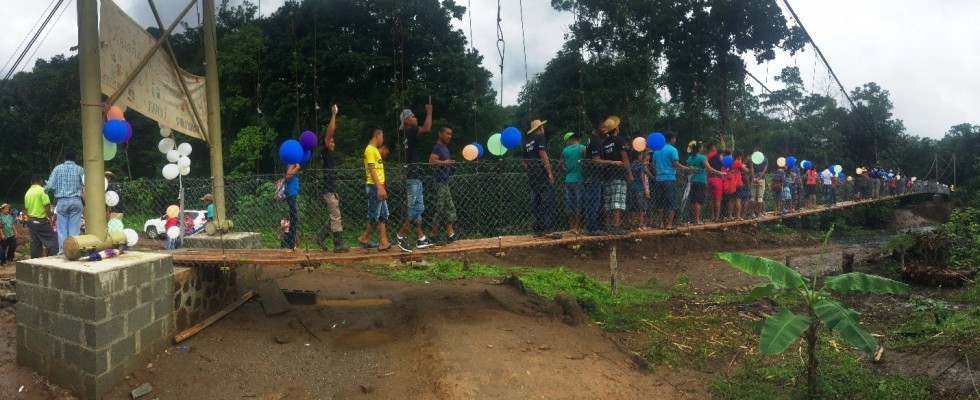
Inauguration day finally arrived. The electricity had been out since 7pm the night before and the rain continued throughout the night and into the morning. The team arrived to a still wetter and muddier site, but discovered that the locals had continued working to construct an additional structure and further clean the area.
The few items that remained to take care of on the bridge were quickly dispensed with: tying the fencing to the end posts and securing the final lag bolts on the deck. The banner was erected and balloons tied to the bridge. After taking a hike to the village, the team waited for the program to begin.
Around 1pm, the villagers assembled at the foot of the bridge. Jose Ruiz, the local leader, opened with a short speech thanking everyone involved. Several other speeches followed, including one from Tobias Petschke representing our team. “We came here to build a bridge,” he said. “We ended up building two bridges: the one you see here, and the one that connects two communities—yours and ours.”
In an emotional moment, the ribbon was cut and the bridge was open. The team stood back and watched, taking photos and videos with their cameras, as members of the community crossed the bridge: children excitedly skipping ahead, some adults striding confidently, others stepping carefully as the deck shimmied and swayed, but remained secure.
Next, the musicians arrived and the party began. In the midst of heavy rain, locals and team members danced the cumbia, took photos, and got to know each other a little better. It was a happy occasion, and happy occasions are mostly similar, so I’ll let the photos speak for themselves.
I’d like to thank all of our team, the B2P staff, the generosity of Traylor Bros. and COWI, and most of all the community of Chiguiri Arriba for an experience none of us will ever forget.
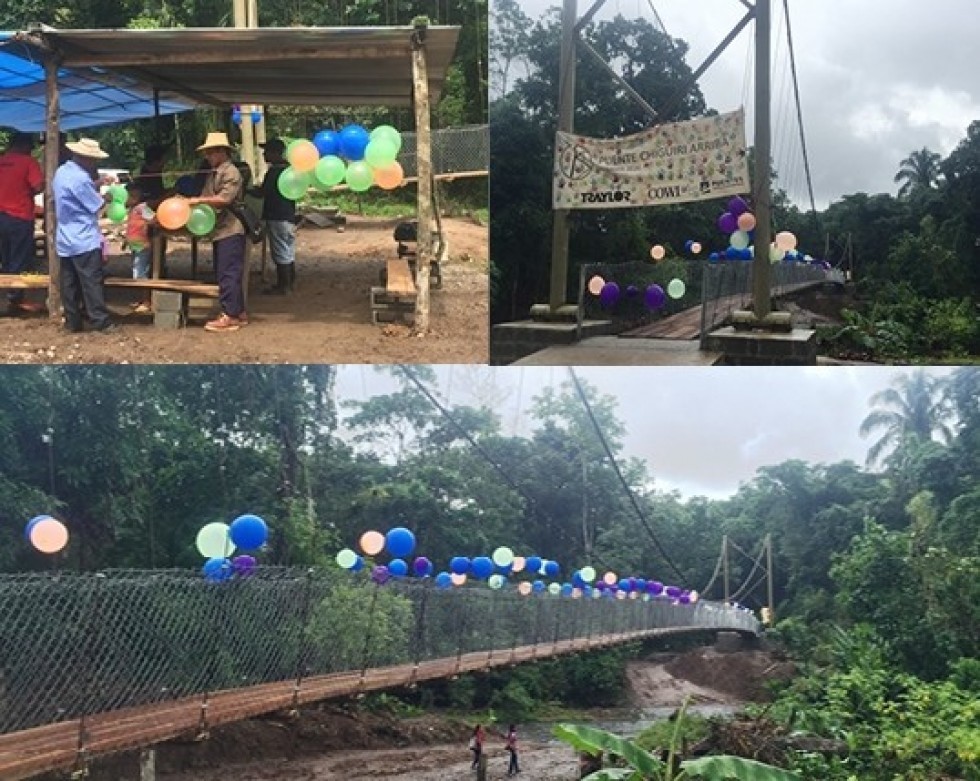
Decorated to the hilt in preparation for the occasion

The team before the program begins
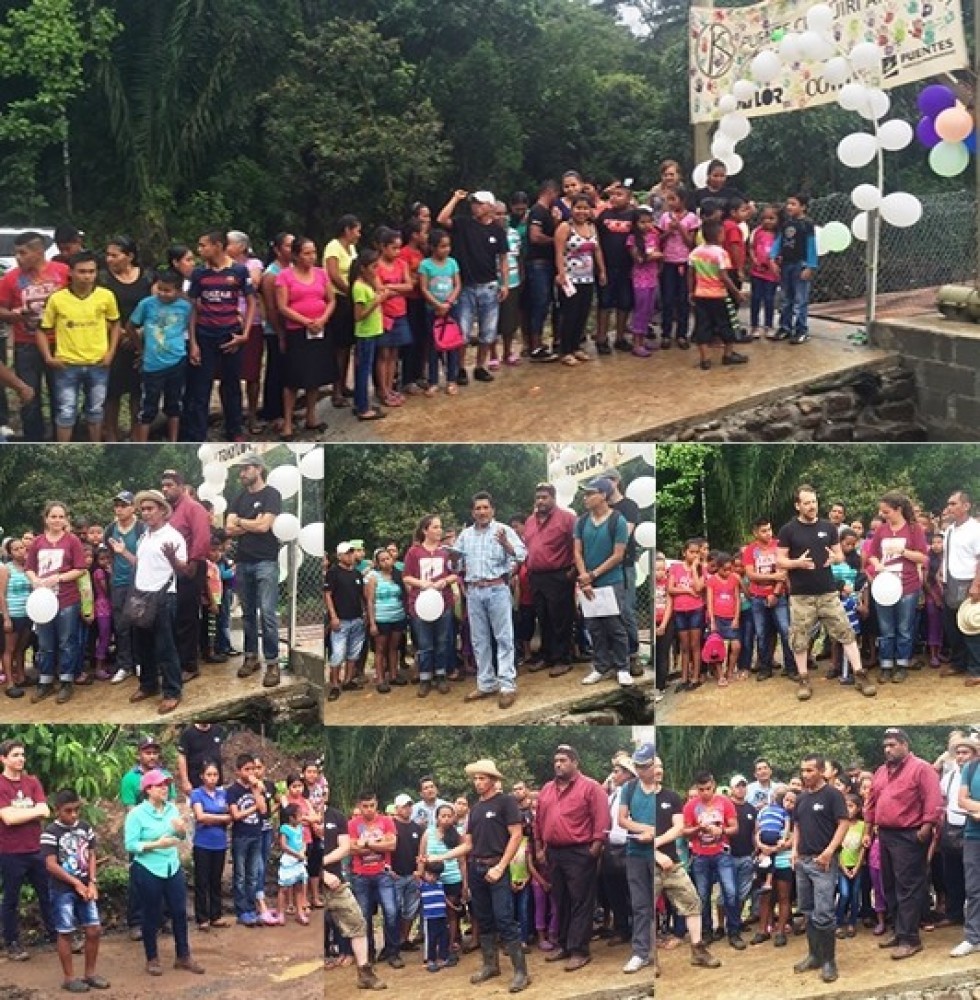
The speeches were given by multiple local community leaders, the team’s representative Tobias Petschke, and the two masons. Everyone who spoke expressed their heartfelt gratitude to all who were involved
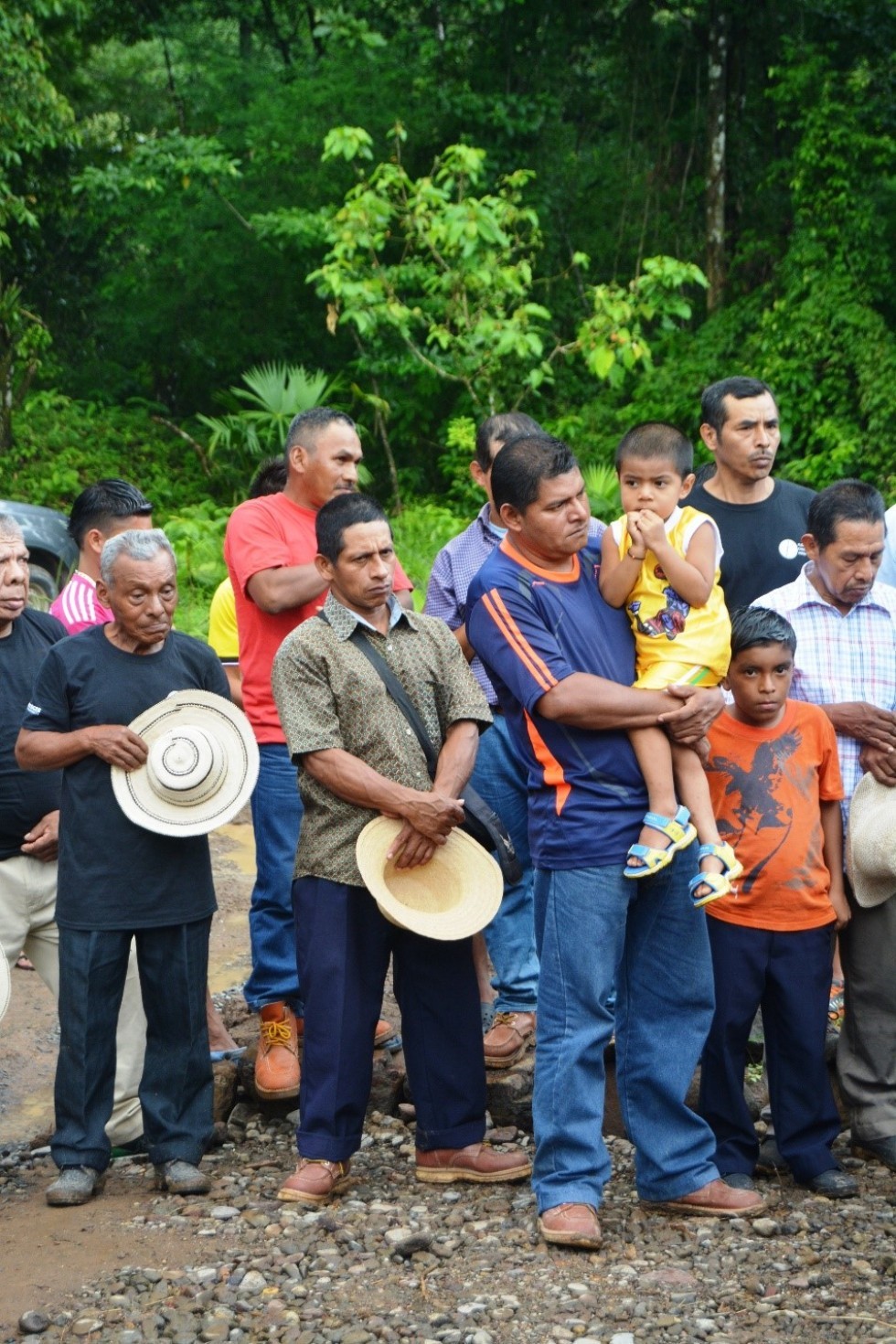
Listening intently
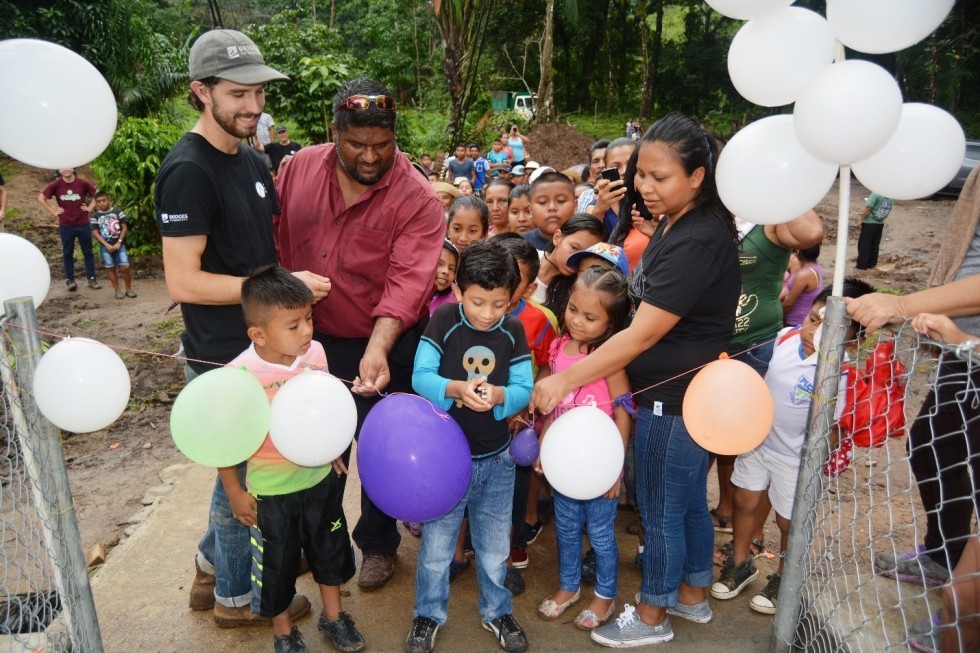
Aaaand…open!
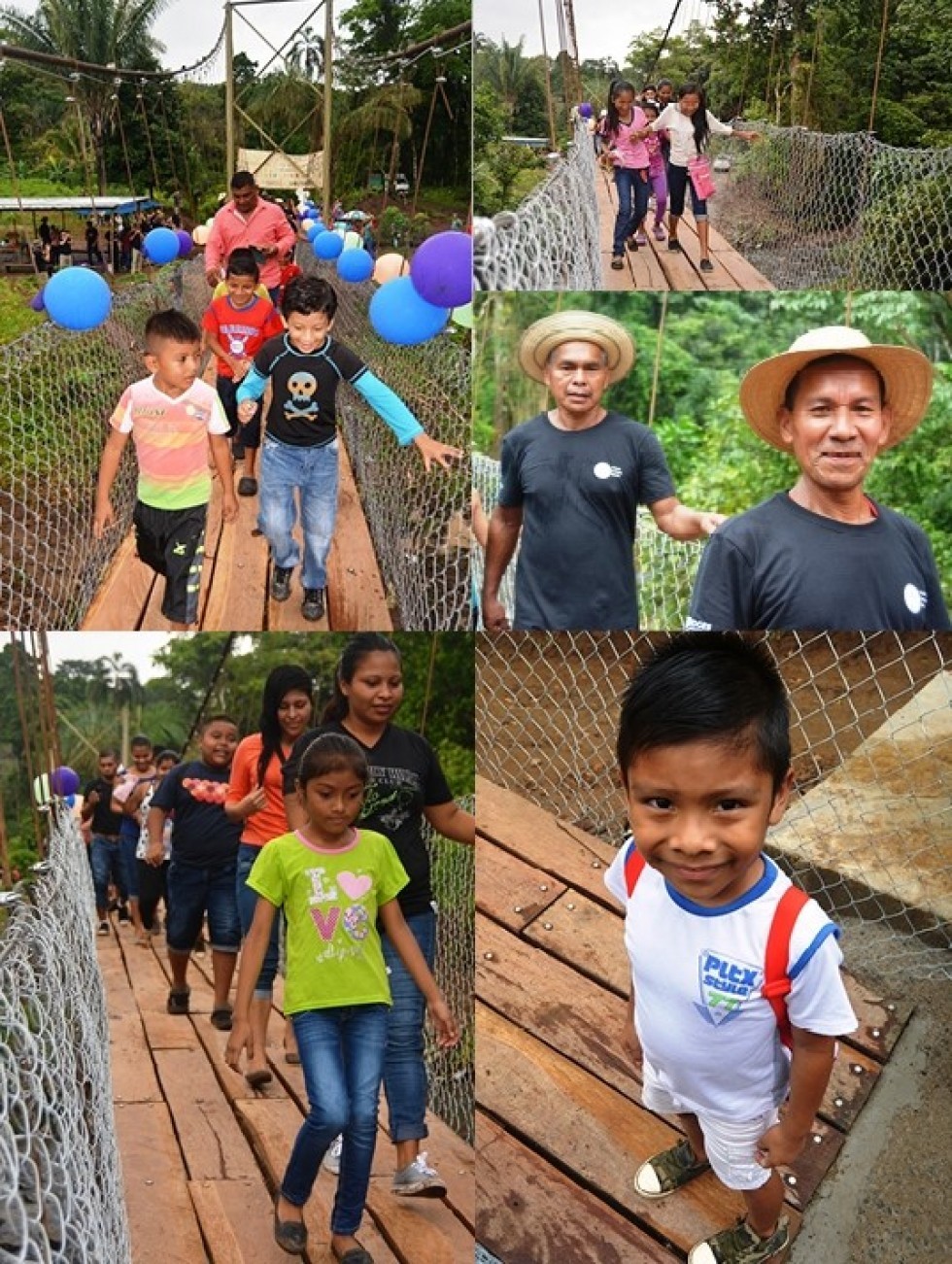
First crossing
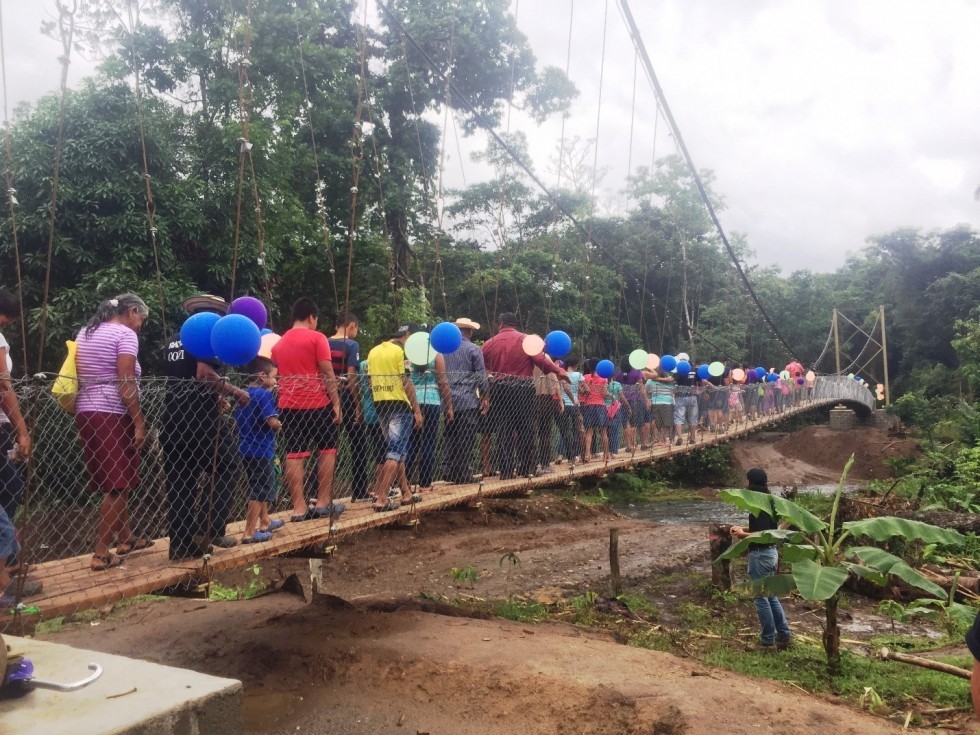
Load test!
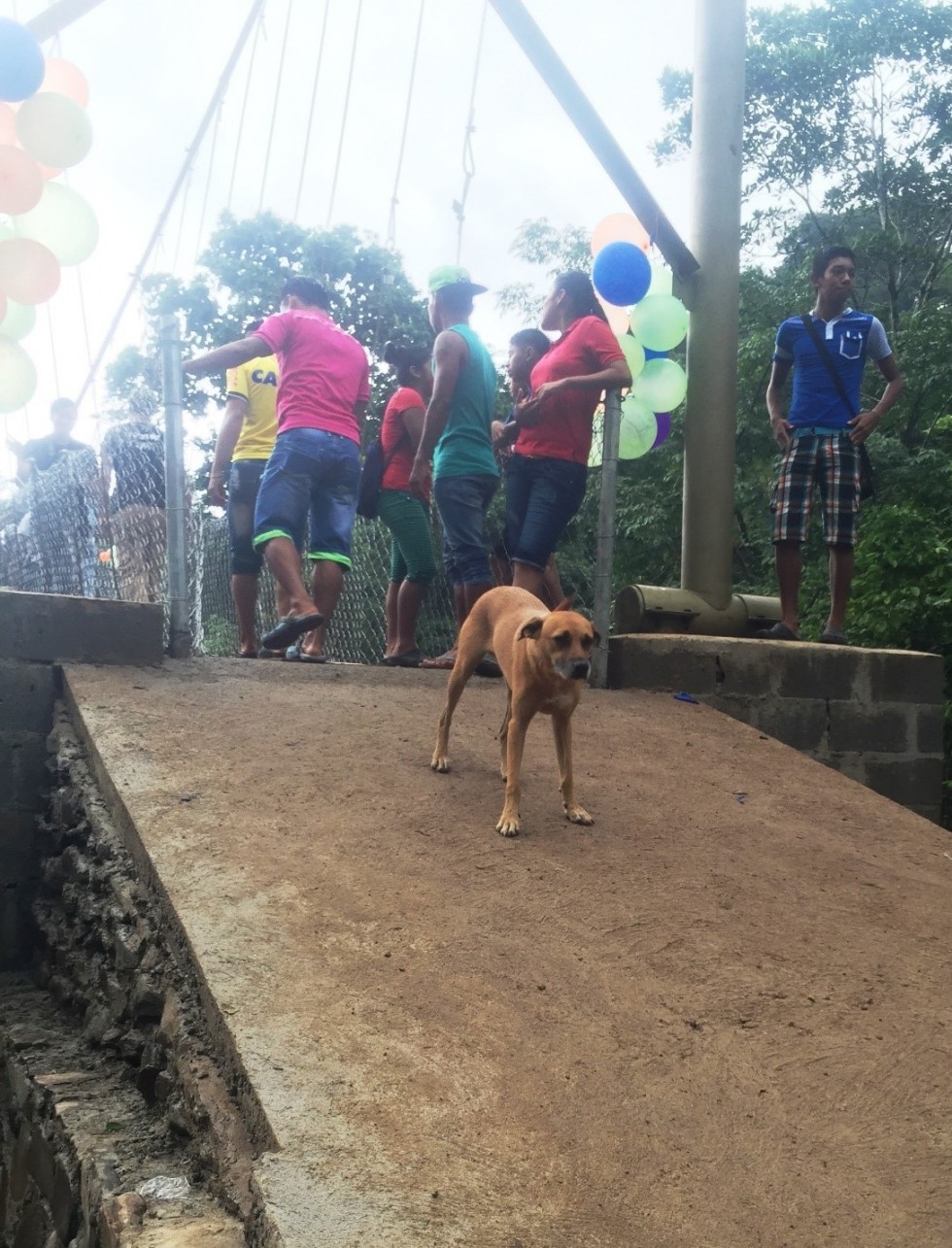
Only one participant could not be convinced to cross
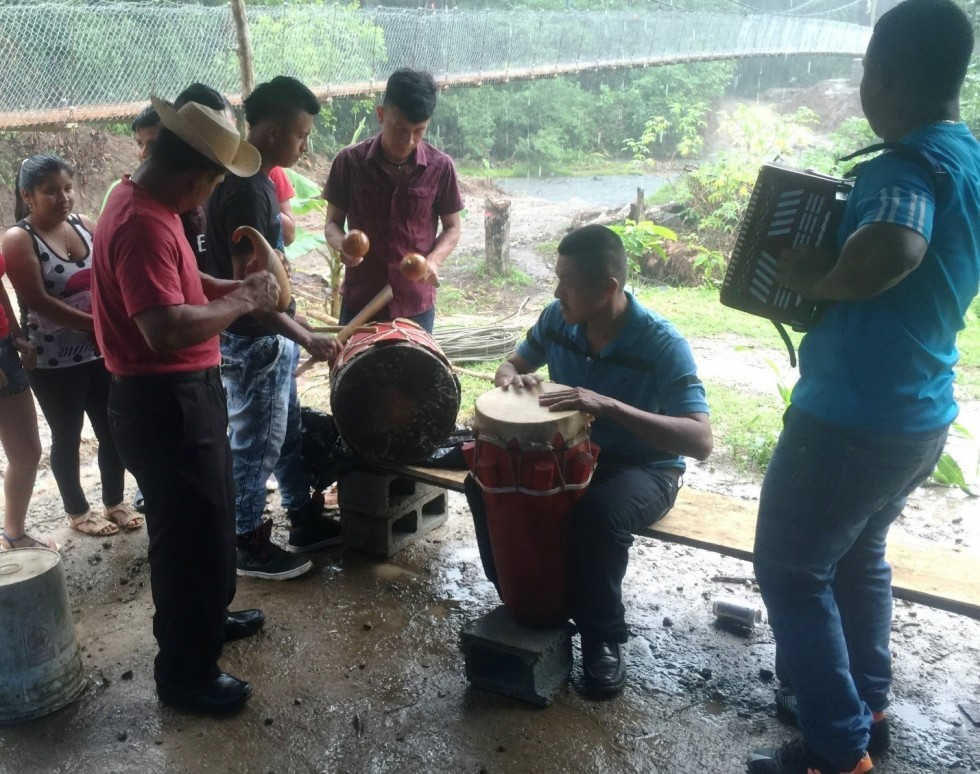
Cumbia time!
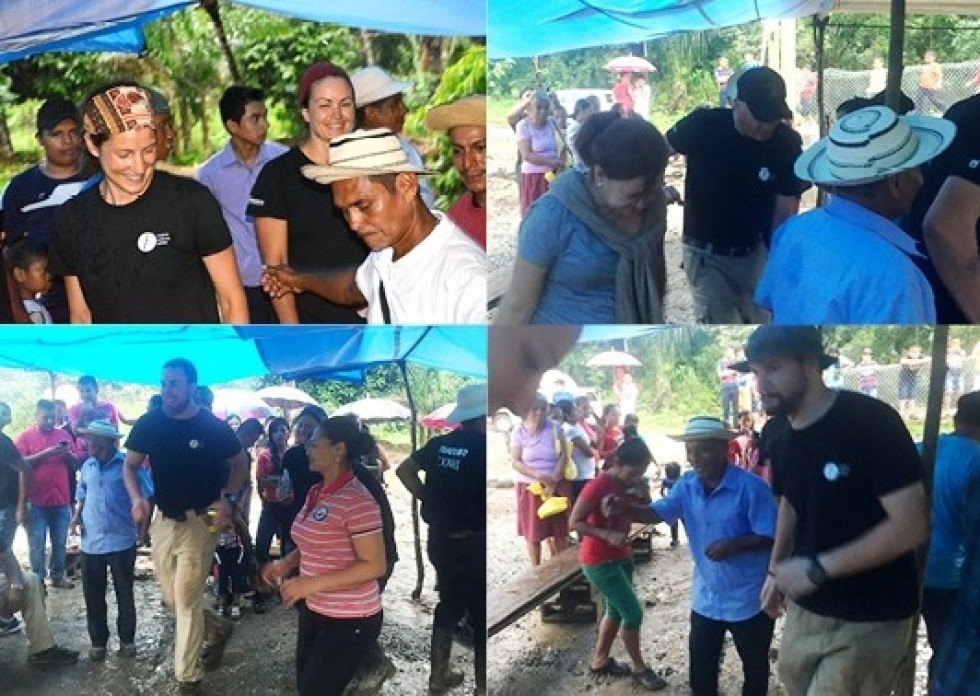
Time to let loose
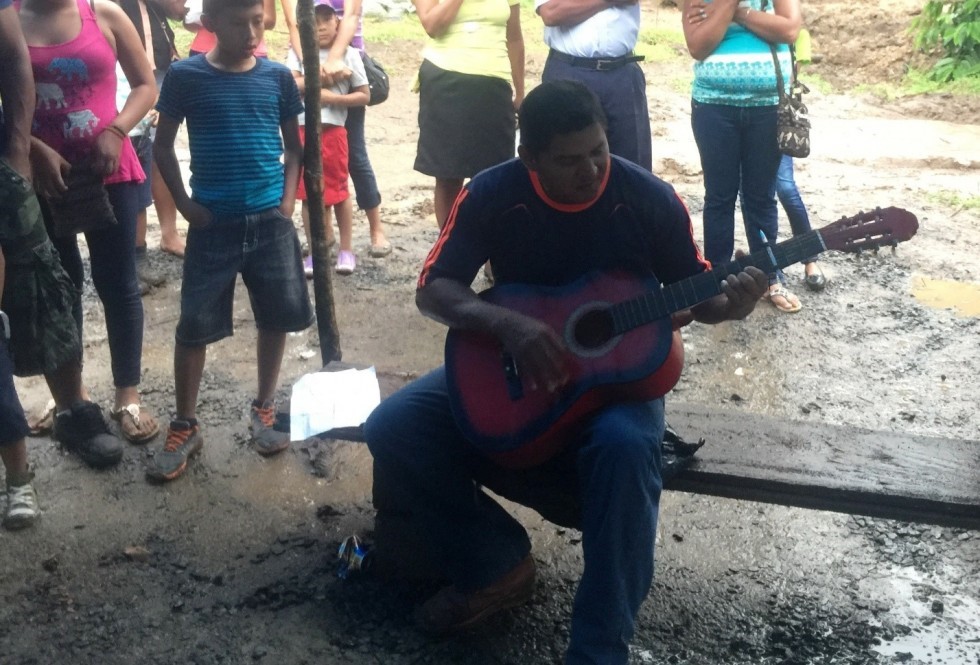
One of the locals even wrote a song for the team
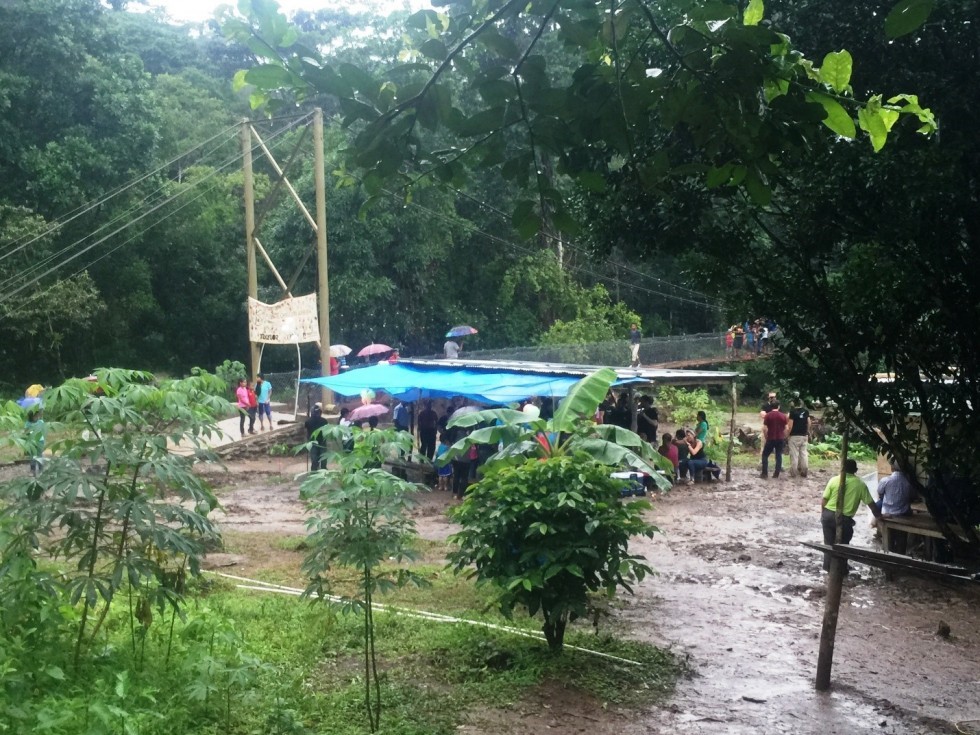
A view of the festivities
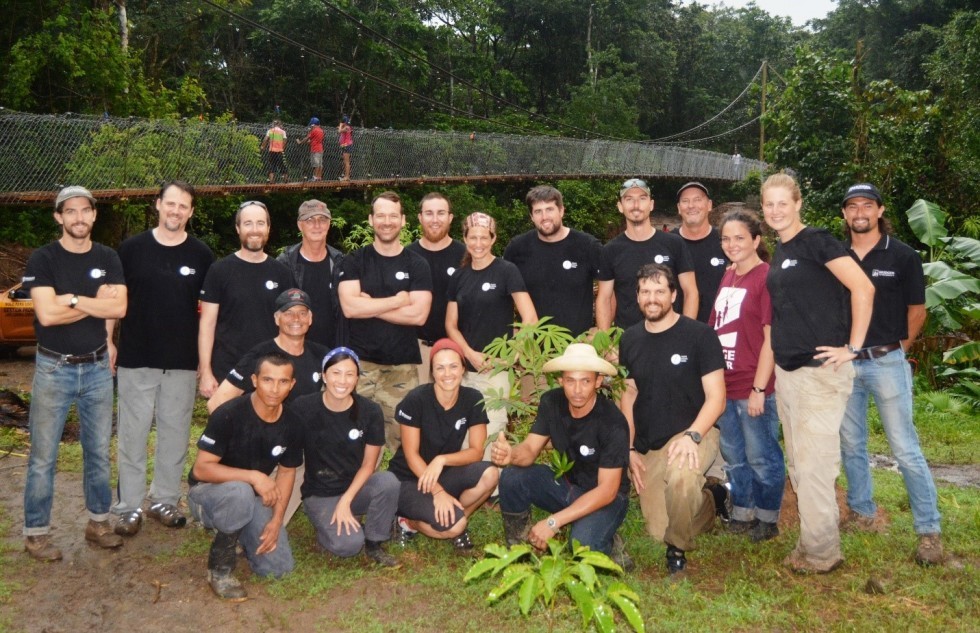
A happy, proud, emotional, and exhausted Traylor/COWI/B2P team
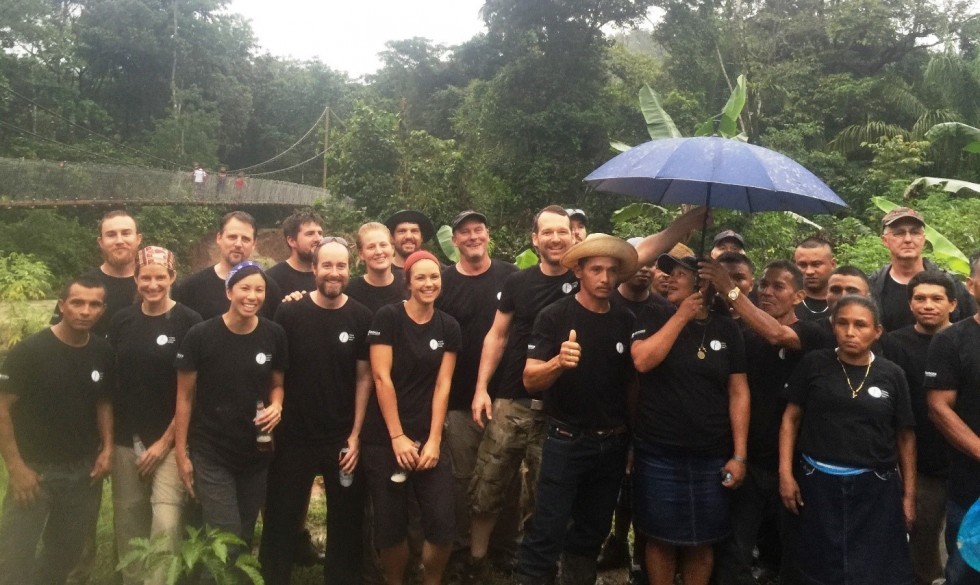
A big thank you to everyone who made the project possible
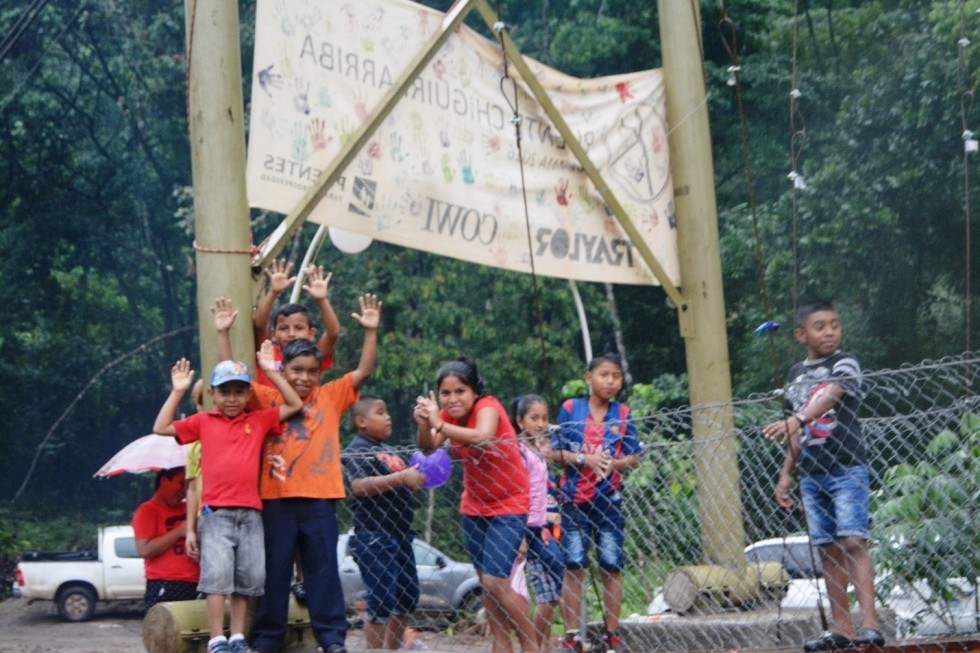
Adios! Until next time
July 20, 2016 – Day 10: Finishing Touches
Work Hours: 6am – 4pm
Weather: High 80s/low 90s, sunny
Peak Local Staff: 12
Conversations with Our Team
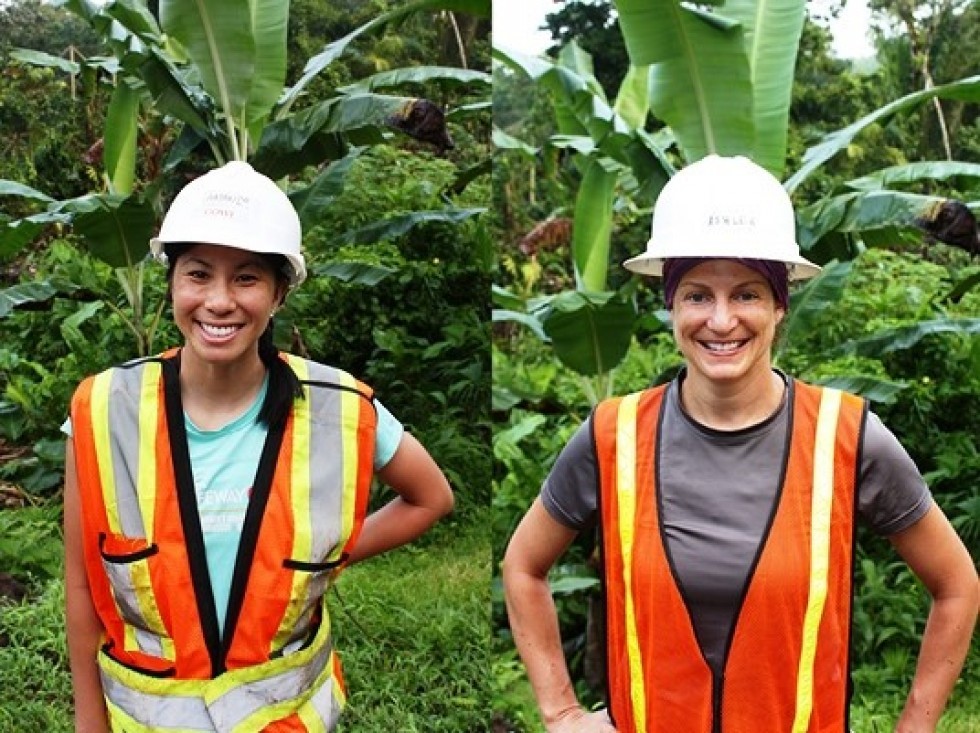
Left, Amanda Wong, COWI Junior Bridge Engineer, B2P Communications Manager; Right, Ashlea Scaglione, Traylor Bros. Marketing Manager, B2P Communications Manager
What has been your favorite part of the last two weeks?
AS: As a non-engineer, it was gratifying to experience field work for an extended period of time. The construction process was extremely interesting to watch and exciting to participate in. I have a ton of admiration for the engineers and what they are capable of.
Also, I had a great time with the entire team. I thought we got along very well and worked extremely well together. It can be challenging to live in a communal situation—at the end of a hard workday, everyone is tired and needs to rest—but we still had a lot of fun together!
AW: Yes—I thought it was impressive how well everyone got along. I would say my favorite part was going to the school and getting to interact with the community and participate in their celebration. And it was great to see that the community was excited about the banner, which was unexpected—I wasn’t sure what kind of response I would get, but they were very enthusiastic about it. I think they’re excited to be a part of the project even when they weren’t contributing directly to the build itself.
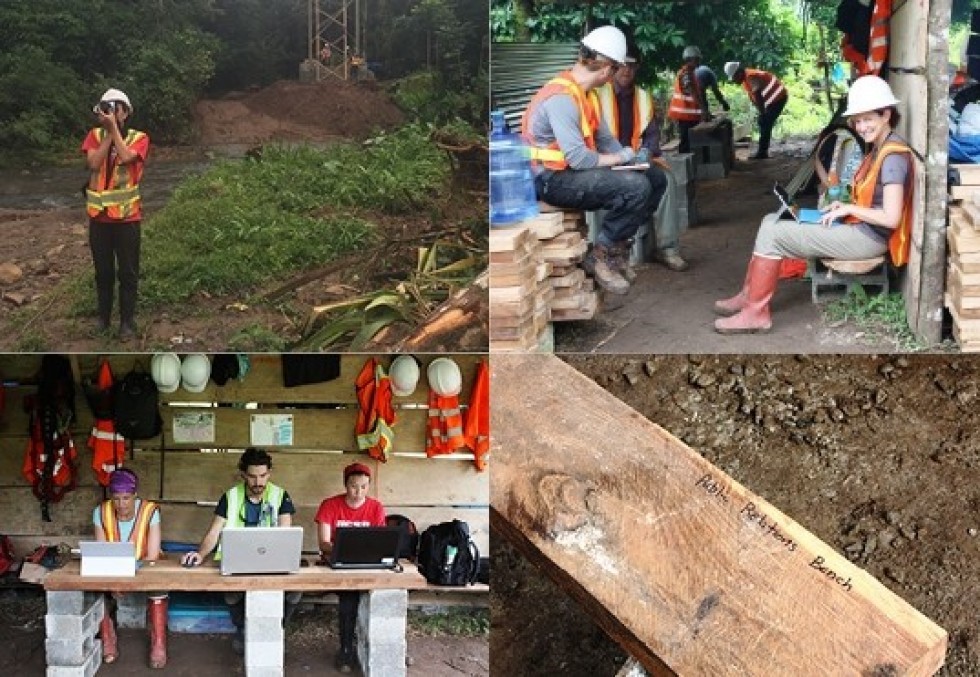
Real-time updates: top left, documenting out on site; top right, ergonomics were not ideal, but the communications team made it work; bottom left, a better setup; bottom right, a deck board masquerades as a seat for the “public relations” team
With only one full workday to go, the team again arrived on site at daybreak eager to finish the bridge. The first order of business was to replace several boards of the decking that were not quite right—too thick, for instance—but were still used in order to keep up production. Next, the team replaced the first four Left Side suspenders as they had done the previous day on the Right Side. Once these tasks were accomplished, the team set about installing the fencing. Each segment, six in total, was pulled out taut, hammered into the deck boards, the safety cable woven through the top, and then clamped to each suspender.
Throughout the day, the locals worked hard to prepare the site for inauguration, finishing up the paths to the bridge and putting up an additional covered structure that would serve as a dance floor.
John Meagher, Vice President at Traylor Bros., and John Brestin, Vice President at COWI, arrived toward the end of the day and got right to work, joining the teams clamping the fencing, working up an immediate sweat. Soon after a thunderstorm rolled in, right in time for the team to call it a day. Apart from some minor cleanup, the bridge was complete and ready for inauguration!
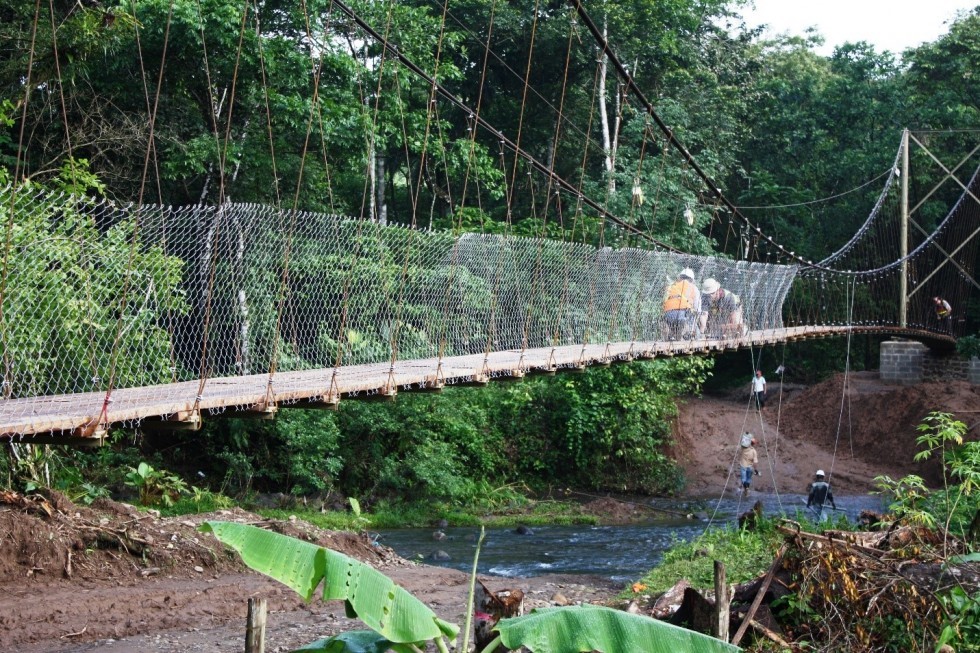
Replacing deck boards
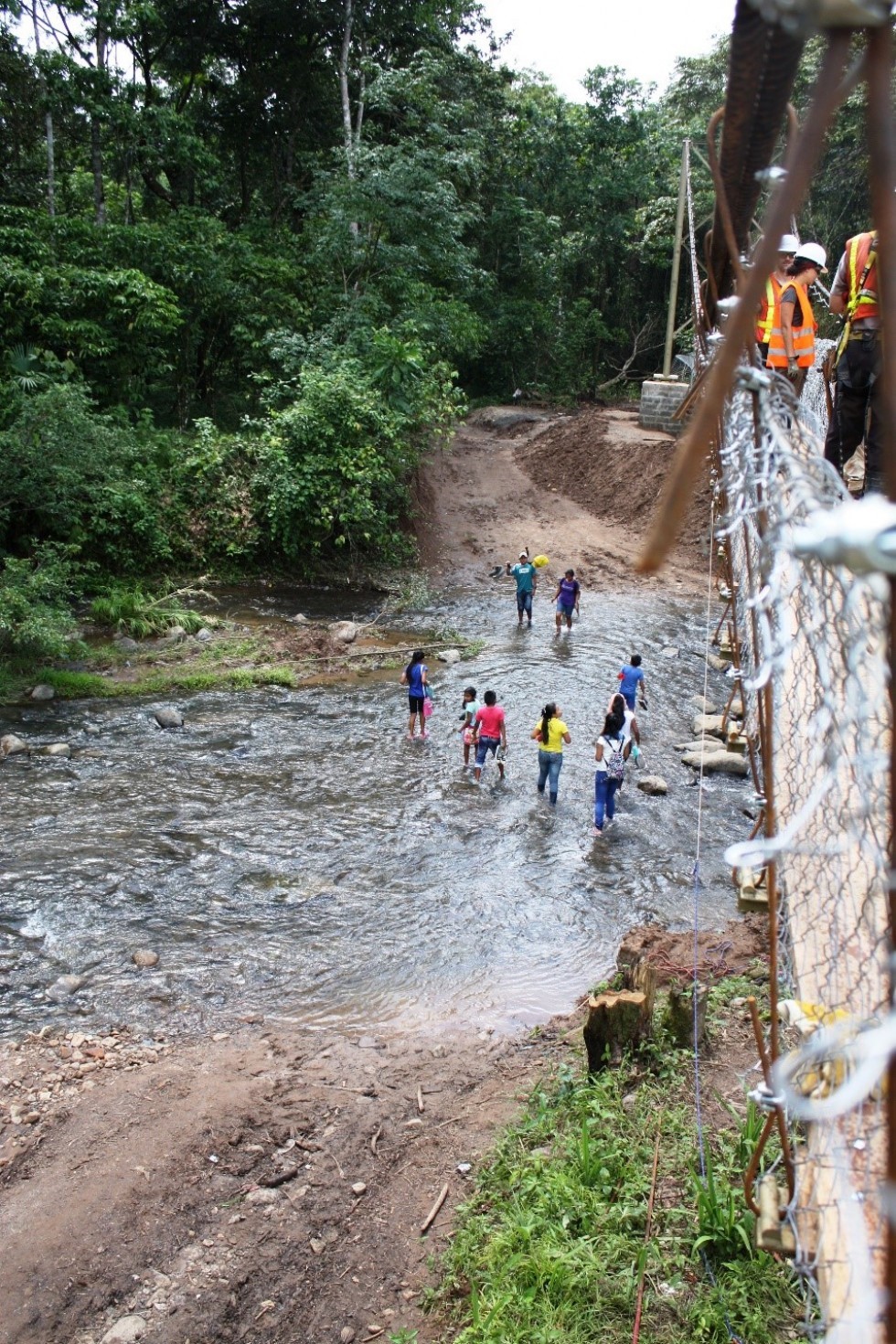
Very soon, the locals will be able to cross with dry feet

El Sorro pours concrete at the landing
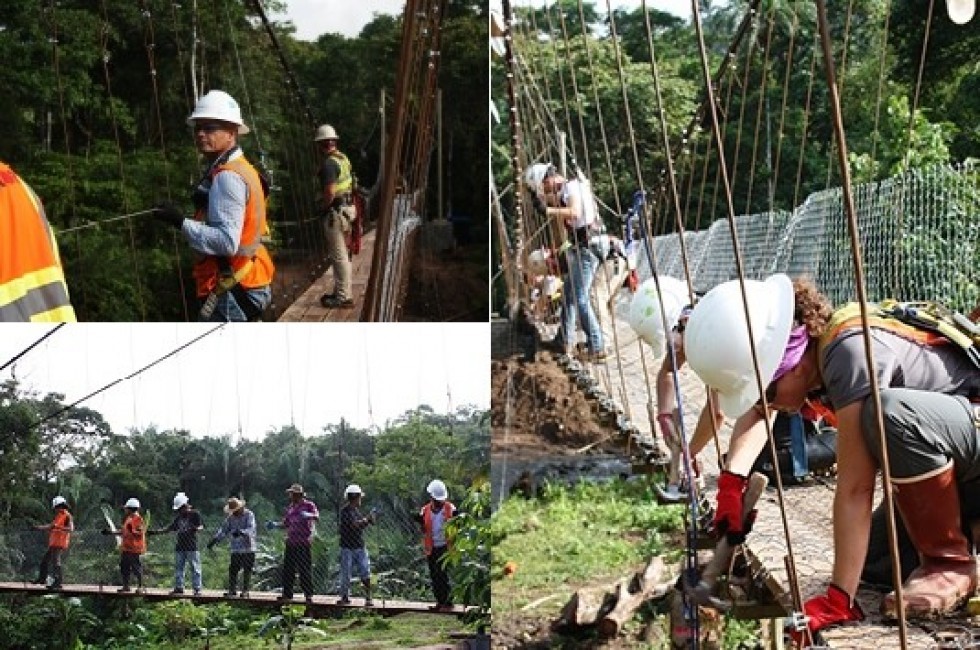
Fencing installation: top left, Dave Pease pulls helps pull out the safety cable for use on the fencing; bottom left, pulling out the fence; right, hammering the fence into the deck boards
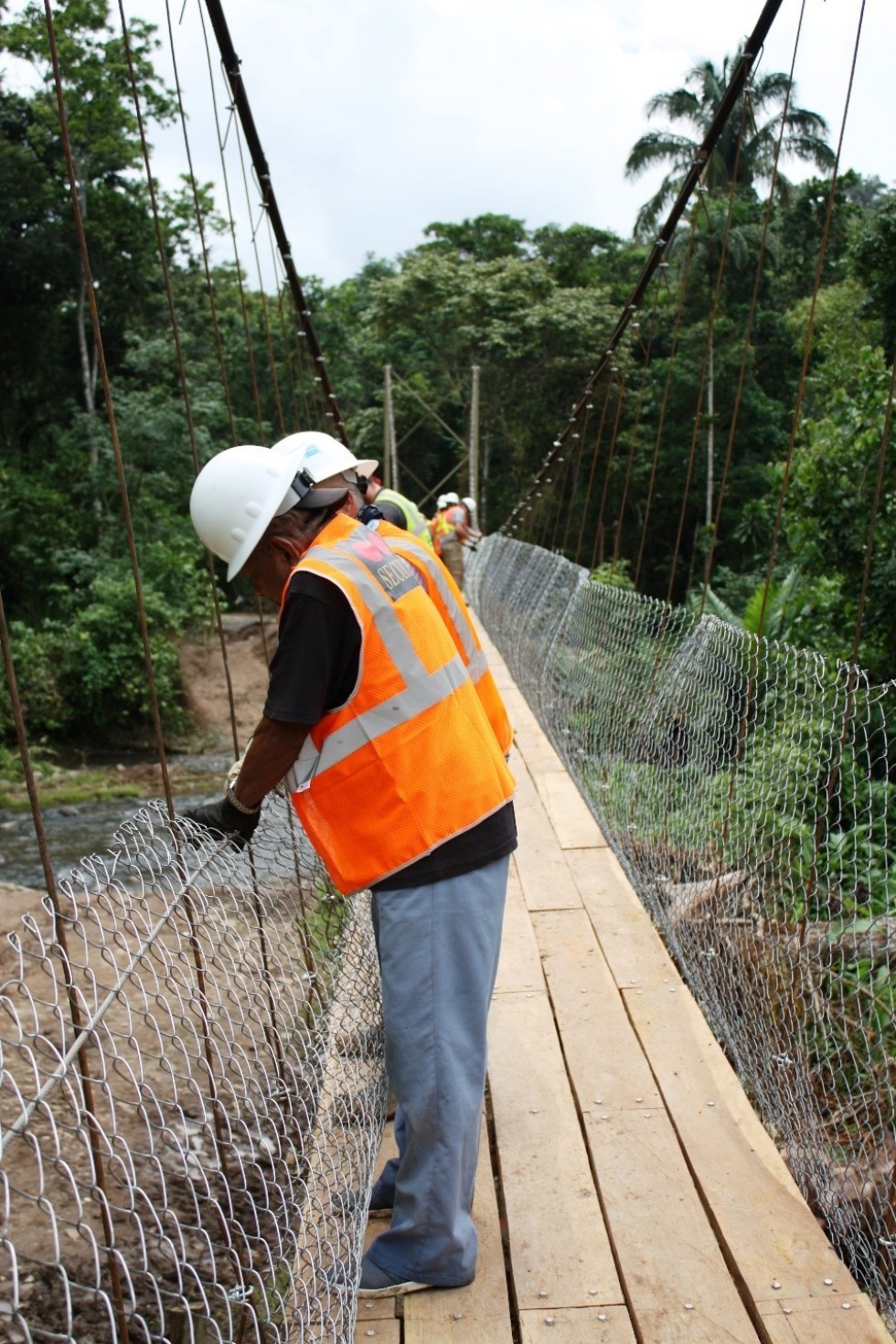
Maximiliano, a Chiguiri Arriba local, helps bend the top of the fence over the safety cable

Get to work!: left, John Meagher of Traylor (far left), and right, John Breslin of COWI (far right) jump right in, helping to clamp the fence to the suspenders
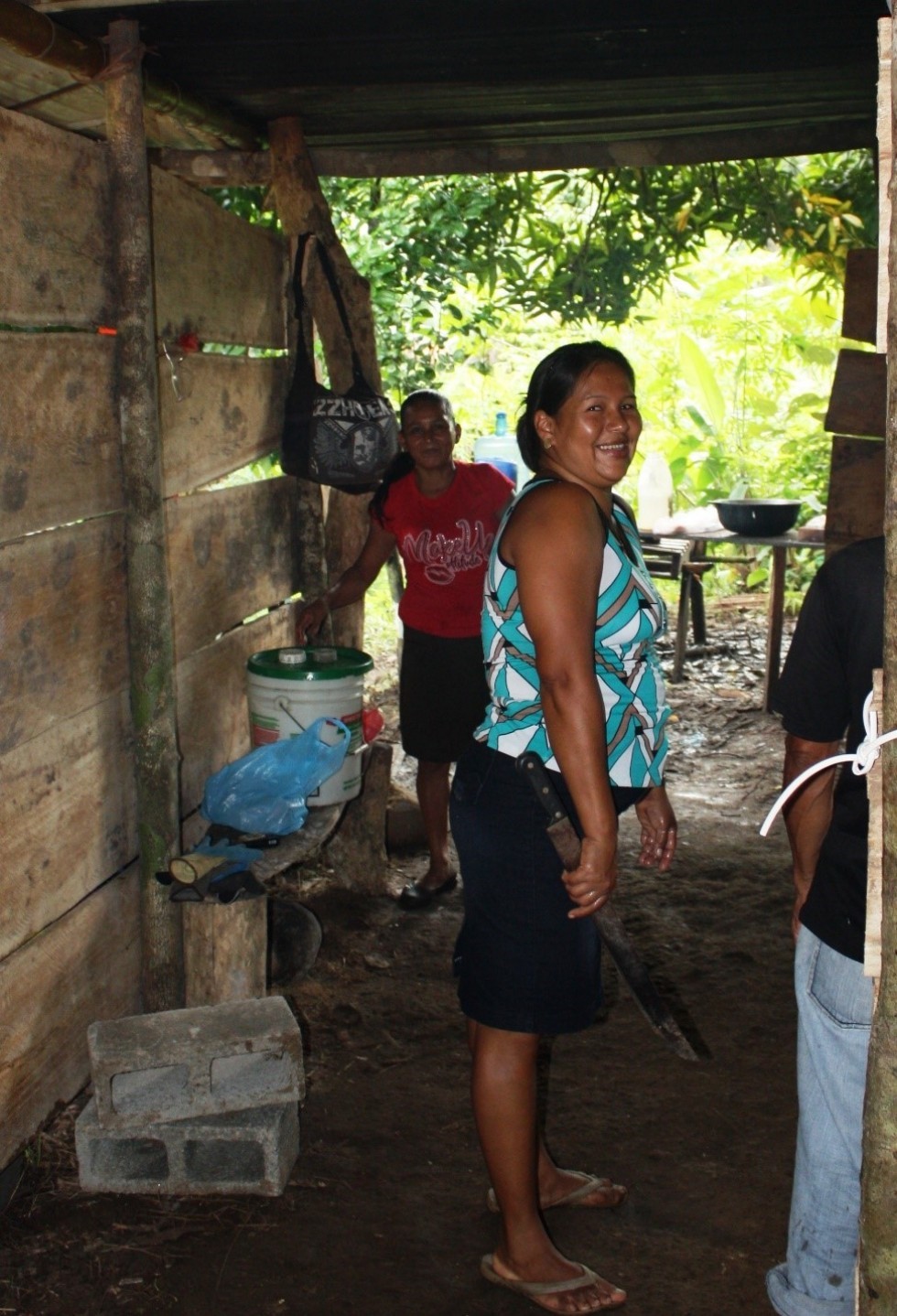
Happy faces as the bridge nears completion
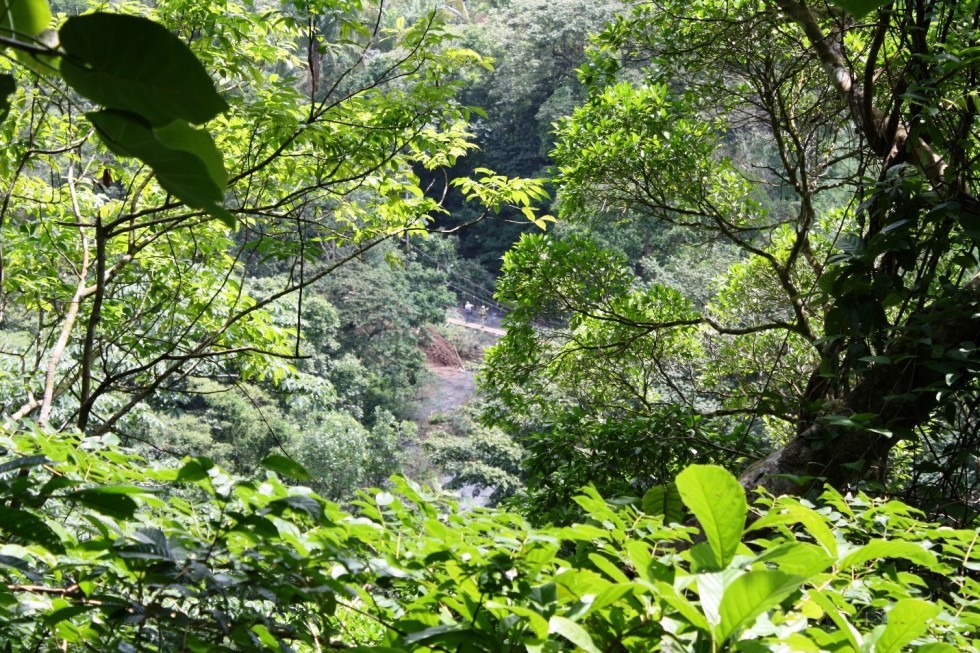
A view from far above: at center, a glimpse of the bridge appears through a break in the forest
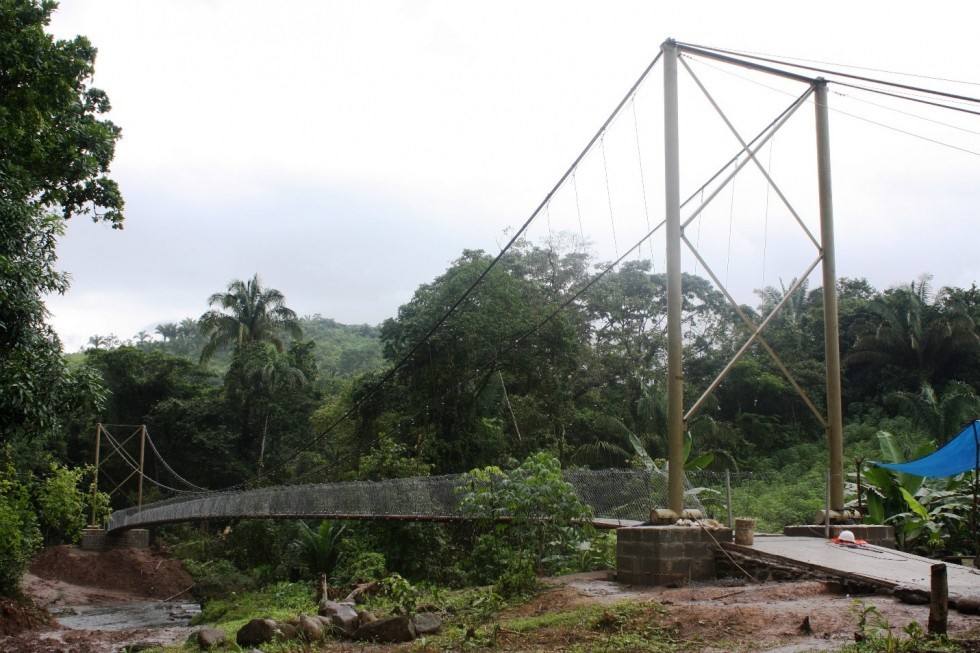
Complete! Isn’t she beautiful?
July 19, 2016 – Day 9: We are One, El Sorro y El Tigre
Work Hours: 6am – 4pm
Weather: High 80s, hot and muggy
Peak Local Staff: approximately 10
Conversations with Our Team

Left, Patrick Haley, Traylor Bros. Engineer, B2P Support Team Member; Center, Jon Murphy, Traylor Bros. Engineer, B2P Support Team Member; Right, Christine Idzerda, COWI Junior Engineer, B2P Support Team Member
We’re approaching the end of the project…what has been the highlight of your trip?
JM: Seeing the bridge decks close was very fulfilling.
PM: I’m really impressed with the community involvement. Before the trip, we were told we could expect anywhere from two or five or fifteen locals—who knows. We’ve had a really strong group here and everyone’s been really willing to help.
CI: For me, coming up with ideas and seeing them happen right away—such as loosening the restraint cables to align the crossbeams—has been great. Also, getting to sit on top of the towers was pretty fun!
PH: I thought this was a cookie cutter operation and everything was already figured out, but there were lots of challenges that came up and we had the flexibility to integrate our own ideas. Construction is like that—who can build the better mousetrap. There’s always a safer, faster, and better way to do something. Even though B2P has done a lot of these bridges, we were still able to make improvements.
The dedicated team, despite being exhausted by working more than a week without rest, decided the best course of action would be to arrive at the site at daybreak to ensure the most hours possible in case of another afternoon rainout. They got started right away on the decking and quickly found their groove. Each team had two people placing and drilling planks and one or two others feeding them the wood. On each team, the two individuals drilling and planking were tied off to the suspenders with lanyards, while the individuals feeding the planks were tied off to the retractable cables attached to the safety cable, giving them the freedom needed to walk back and forth.
The day’s main challenge was that both sides of the deck hung approximately 20 cm high above the pedestals, leaving too large of a gap between the deck and the ramp. After considering multiple solutions, the team decided the best way to resolve the issue was to replace the bottom segment of the first four suspenders (which are the four longest; due to their length they are made of two connected suspenders rather than one) on each side with longer pieces to account for the difference. In the afternoon, the theory was tested on the Right Side; the team replaced the suspenders, released the deck, and it settled to exactly where it needed to be.
At the end of the day, as a large thunderstorm threatened to roll in, Mat Reynolds and Tobias Petschke closed the gap between the sides, completing the decking. At the same time, the first segment of fencing was pulled into place and secured for installation the next day. In addition, the locals worked on cleaning the site and building an inviting pathway up to the ramp of the bridge using large rocks, tree trunks, and gravel, and planting small trees on either side.

Deck production begins: left, Jon Murphy and Patrick Haley on the Right Side; right, Chris Scollard, Mat Reynolds, and Mike Krulc on the Left Side
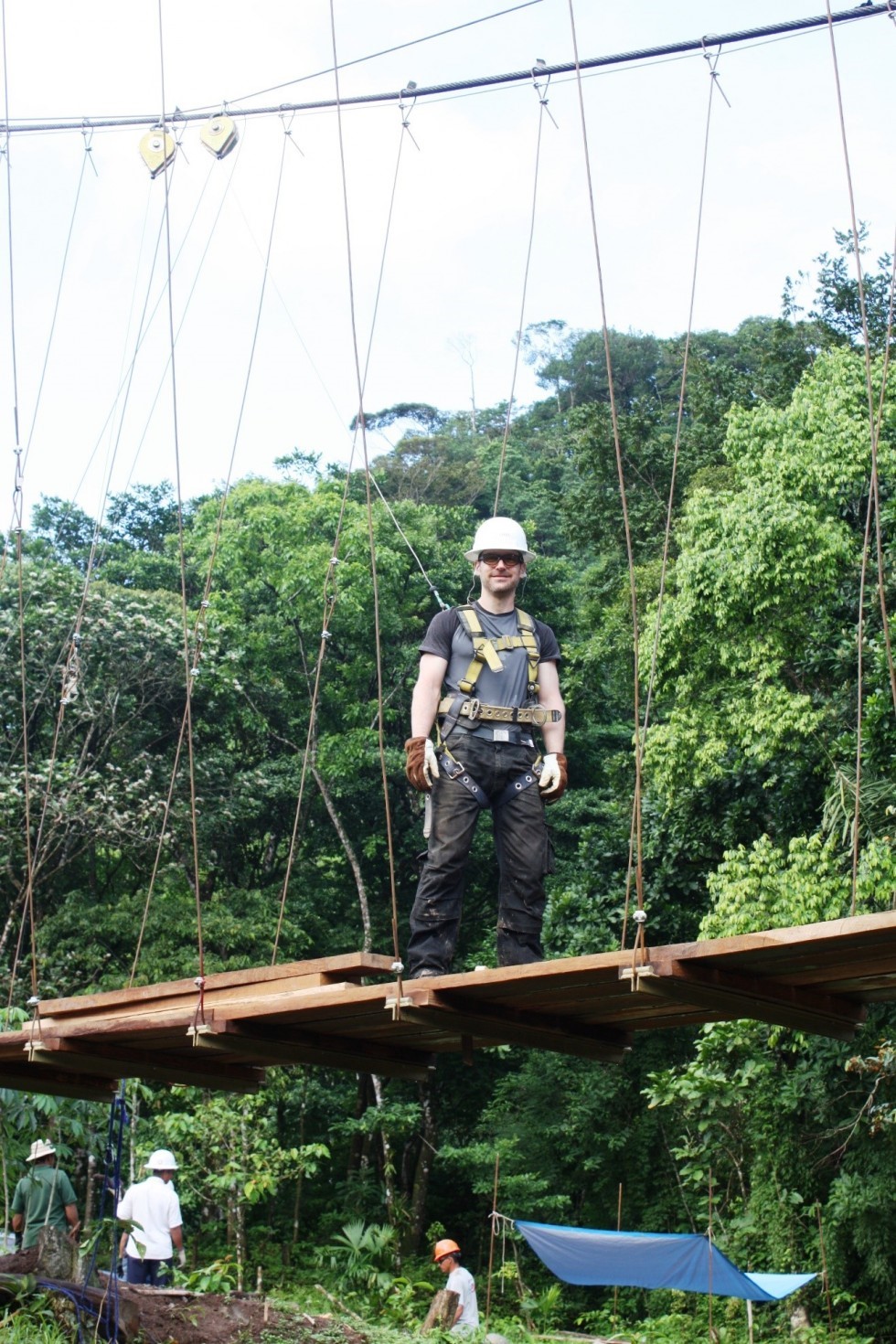
Tobias Petschke lends a hand

The locals begin building the pathway to the bridge ramp
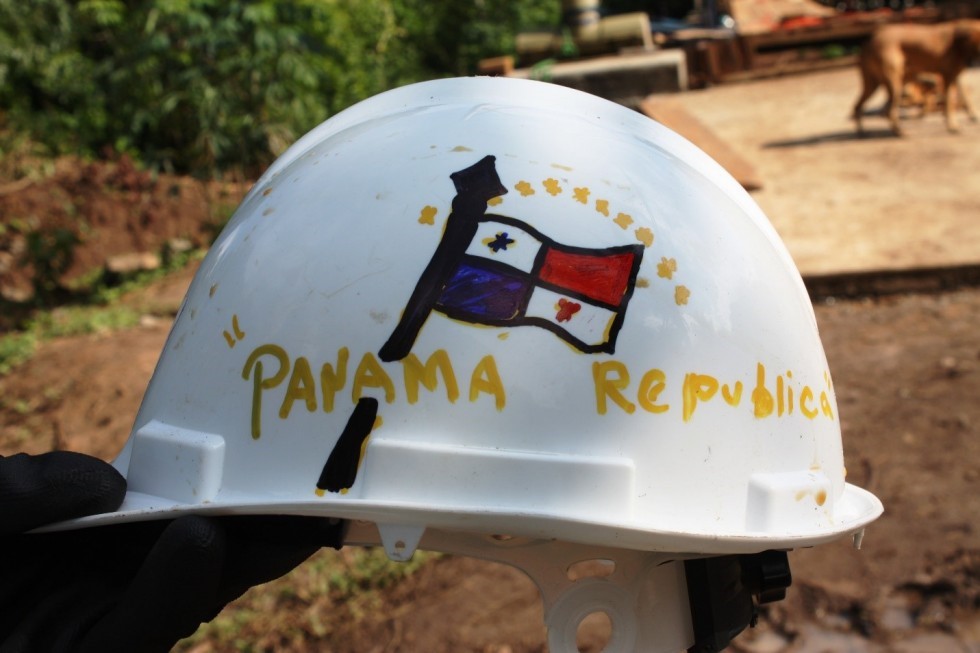
Many of the locals decorate their hard hats during down time

Making progress on both sides
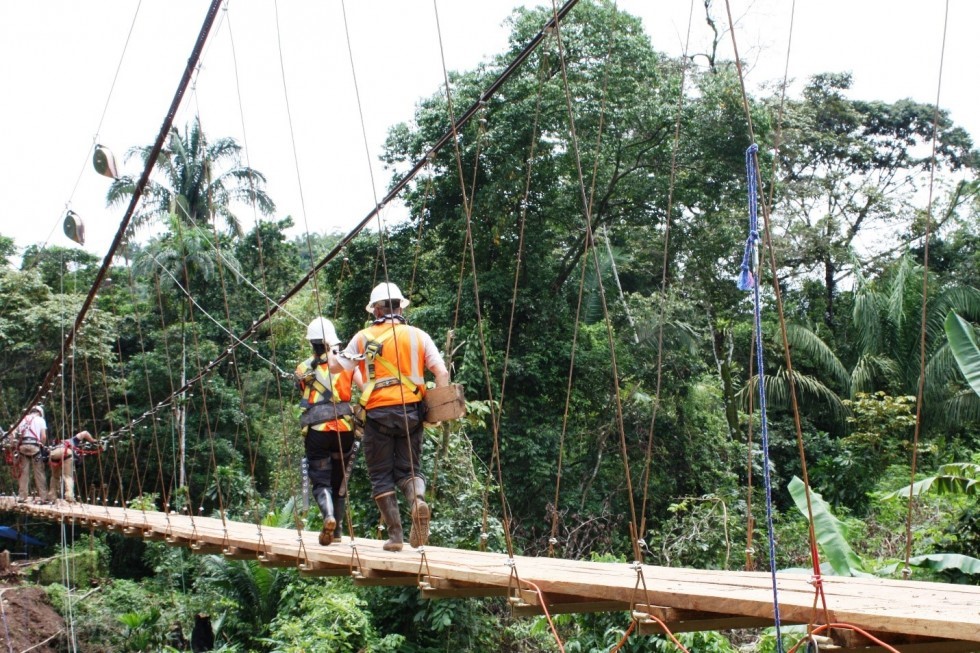
Amanda Wong and Dave Pease deliver deck boards
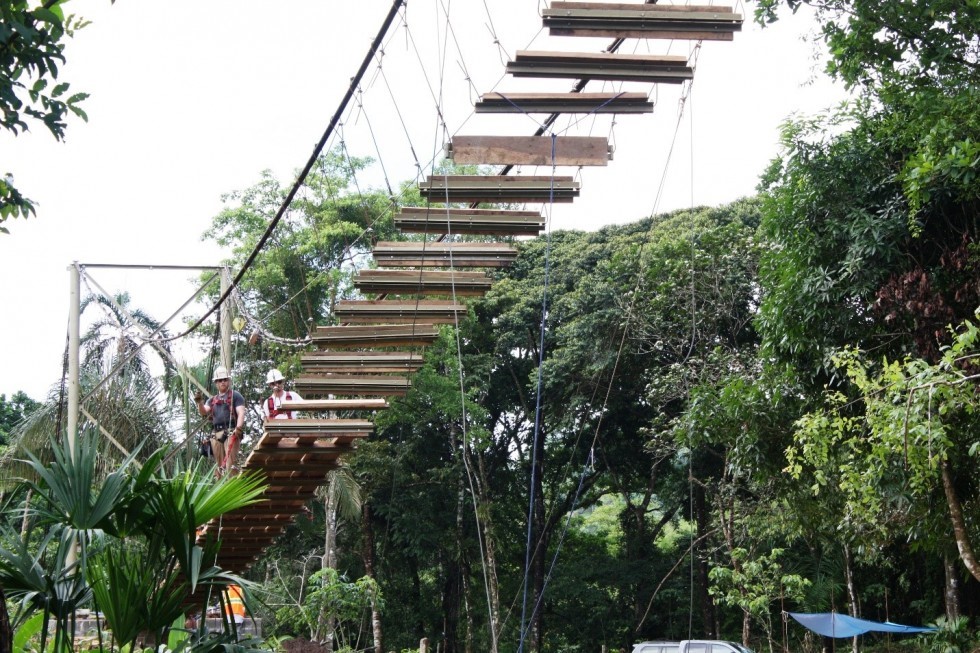
Creeping up on the Right Side
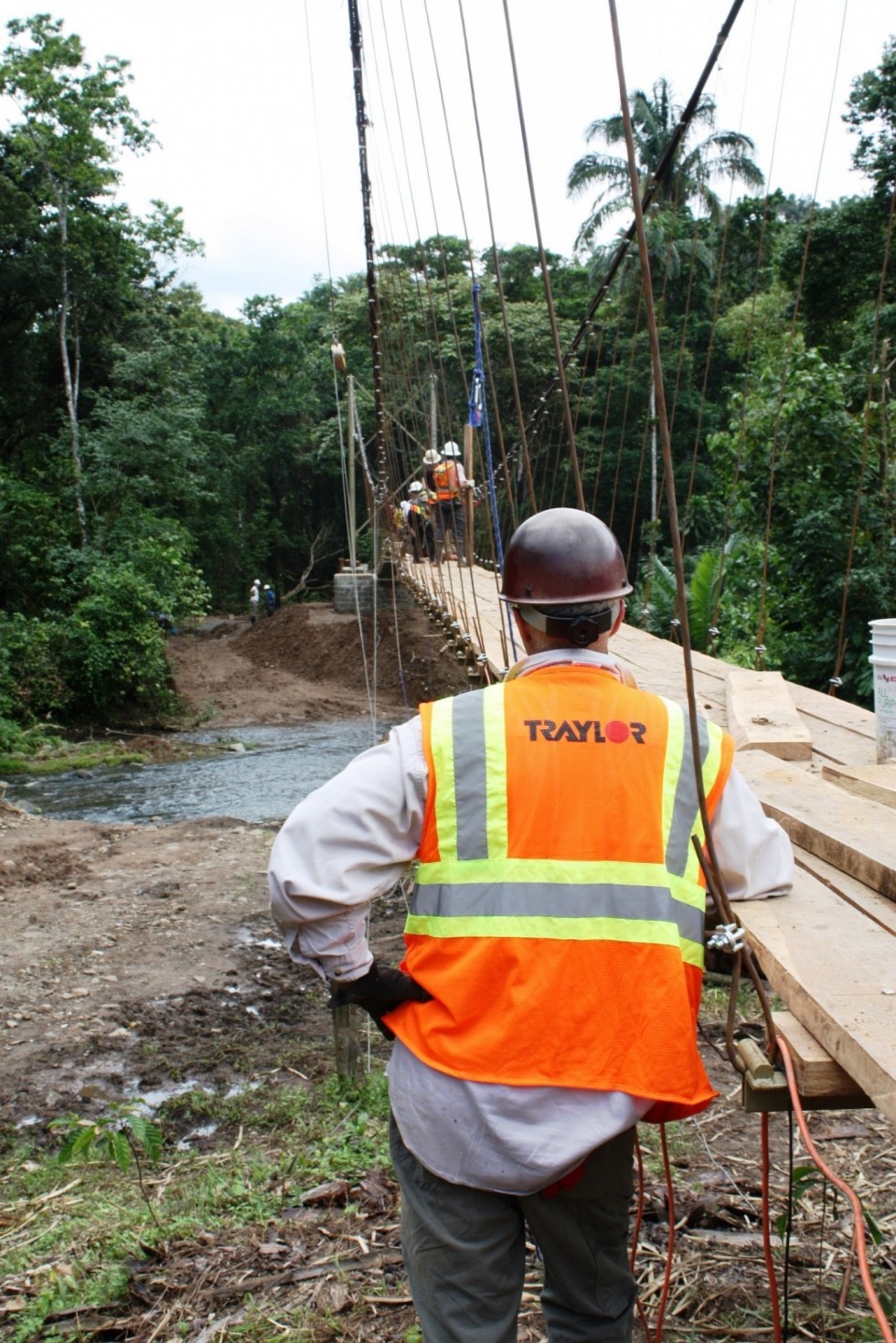
Wayne Jones keeps an eye on his team
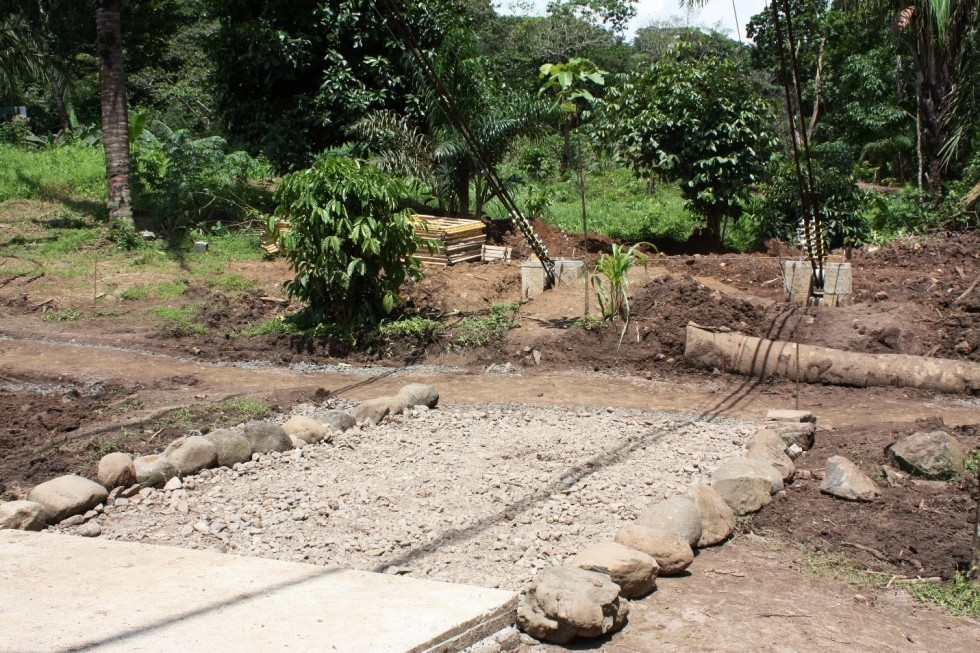
The Right Side pathway
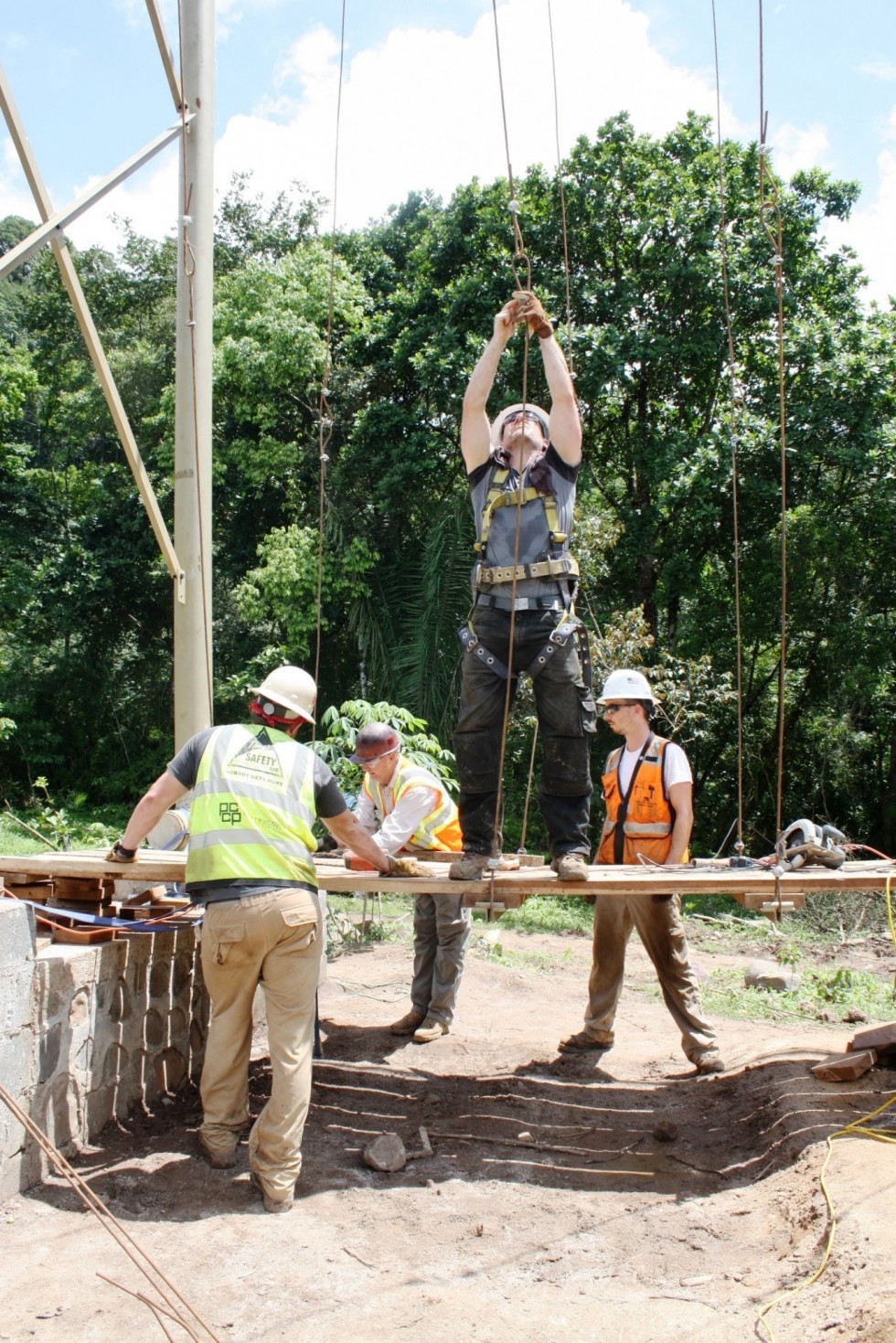
Replacing the first four suspenders on the Right Side
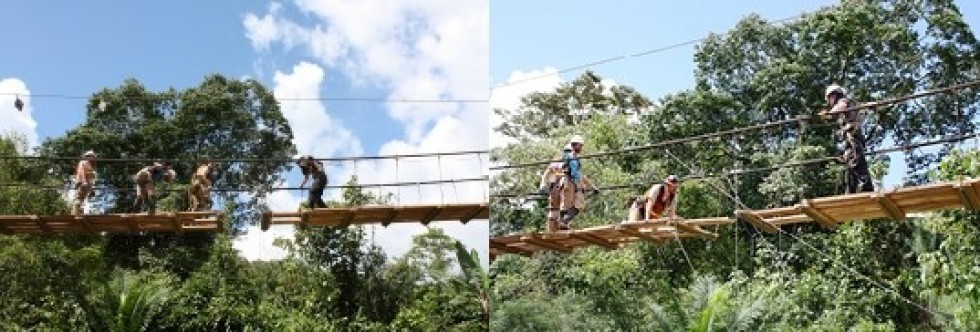
Closer…

First contact…
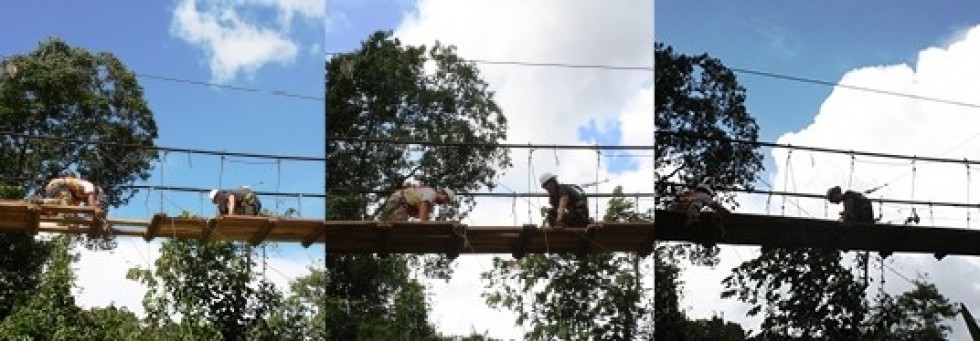
Looking good…
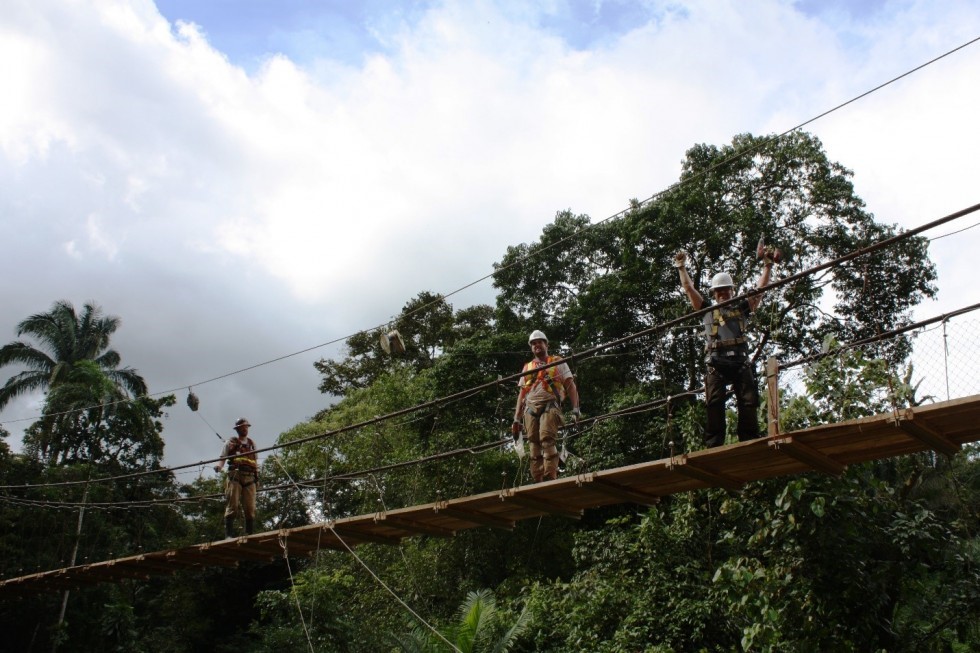
Closed!
Meet Shon, “El Tigre,” and David, “El Sorro”
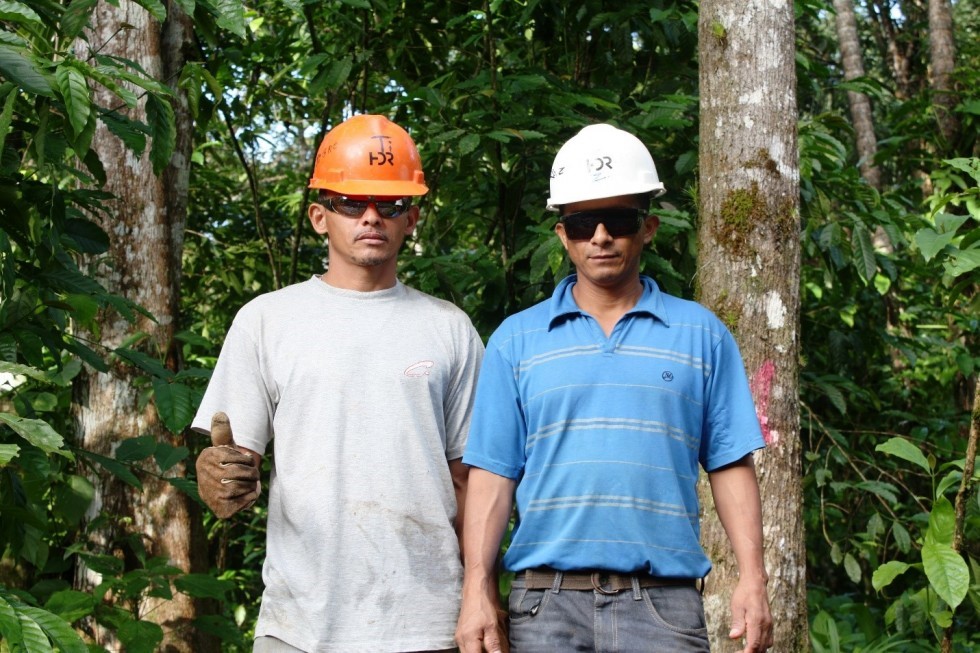
This B2P project has two local masons, who are essentially the project foremen: Shon (left), or El Tigre, the tiger, and David (right), or El Sorro, the fox. Shon is married and lives in Colon, a nearby town, with his wife, who makes beautiful hand woven baskets he was trying to sell on site for $25 apiece. (At that price, he had no takers.) He has been working with B2P for the past six months on all the builds in Panama.
David lives with all of his immediate and extended family in Colon. He has four children: one boy and three girls ranging from the age of 18 to six years old. He enjoys working for B2P because he likes to travel among all the sites. In between projects, he returns to Colon to look for other work.
El Tigre and El Sorro injected a definite dose of personality to the job. Between El Sorro’s frighteningly realistic animal noises and El Tigre’s daily progression of shirt unbuttoning (the shirt starts the day fully buttoned, and by the end only one or two are fastened), the team was continually entertained.
July 18, 2016 – Day 8: Deck Board Installation, Inclement Weather, Dia de los Niños
Work Hours: 7:30am – 1:30pm, 3pm – 3:45pm
Weather: Mid to high 80s, morning sun, midday thunderstorm and afternoon rain
Peak Local Staff: 8
Meet Benjamin and Maribel Ruiz
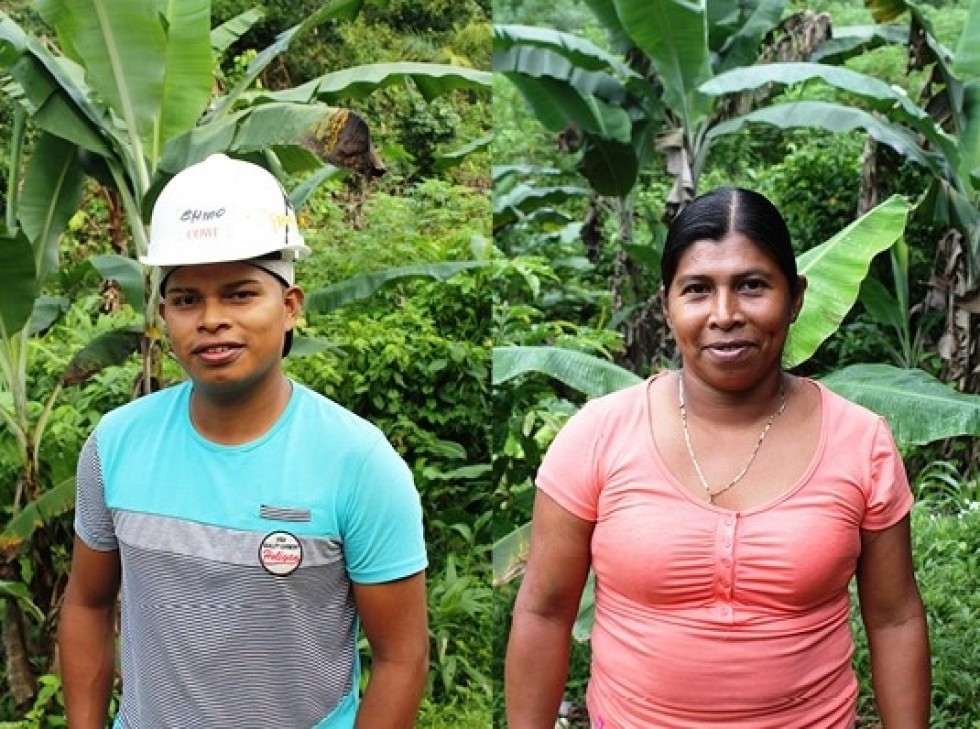
Benjamin Ruiz and his mother, Maribel Ruiz, have been frequent volunteers at the job site. Benjamin, Maribel, Benjamin’s father, and his younger brother all live in La Vieja. His oldest brother lives in Panama City and works in a restaurant.
Benjamin is 25 years old. For a time, he lived in Panama City and worked in construction there, but he preferred La Vieja, so he moved back to be with his family.
Maribel is 42 years old and has lived in La Vieja all of her life. She comes to the site to cook because the bridge is very important to the community and she wants to help.
Earlier in the project, Benjamin was helping to bend rebar. Where the team had set up, there was a small banana tree that proved to be in the way of the longer pieces. One of our team members suggested that the tree be cut down. Although the forest is thick with banana trees, Benjamin insisted on finding an alternative to removing the tree, demonstrating a clear cultural difference on site.
Monday’s weather was the most challenging yet. For the first time the sun emerged from behind the heavy rain clouds, and the strength of the rays was palpable. The morning hours were hot and steamy—weather the team had been expecting since day one.
After removing the scaffolding, deck board installation began on both sides, and each encountered the same difficulty: mounting the first deck beams perfectly straight lengthwise and also exactly perpendicular to the crossbeams. The first part of the challenge was because the crossbeams hung free. This problem was solved by securing the first crossbeam to the tower legs, with slightly different execution on each side. The challenge was also caused by the restraint cables not being exactly aligned, which meant the suspenders were not directly across from each other, resulting in the crossbeams hanging at about a thirty degree angle. The Right Side team made some measurements and then created shims to place between the boards to keep them correctly aligned. The Left Side team also spent time measuring things out, but then decided to pull the restraint cable to create a small amount of slack, bringing the suspenders into alignment, which straightened out the crossbeams and therefore the deck boards. Once the problem was solved, production began in earnest and the deck boards could be mounted relatively quickly.
But the weather is changeable here in the rainforest, and at midday a thunderstorm quickly rolled in. The team waited out the storm, getting back to work for a short while before the rain and thunder began again, forcing the team to pack up for the day.
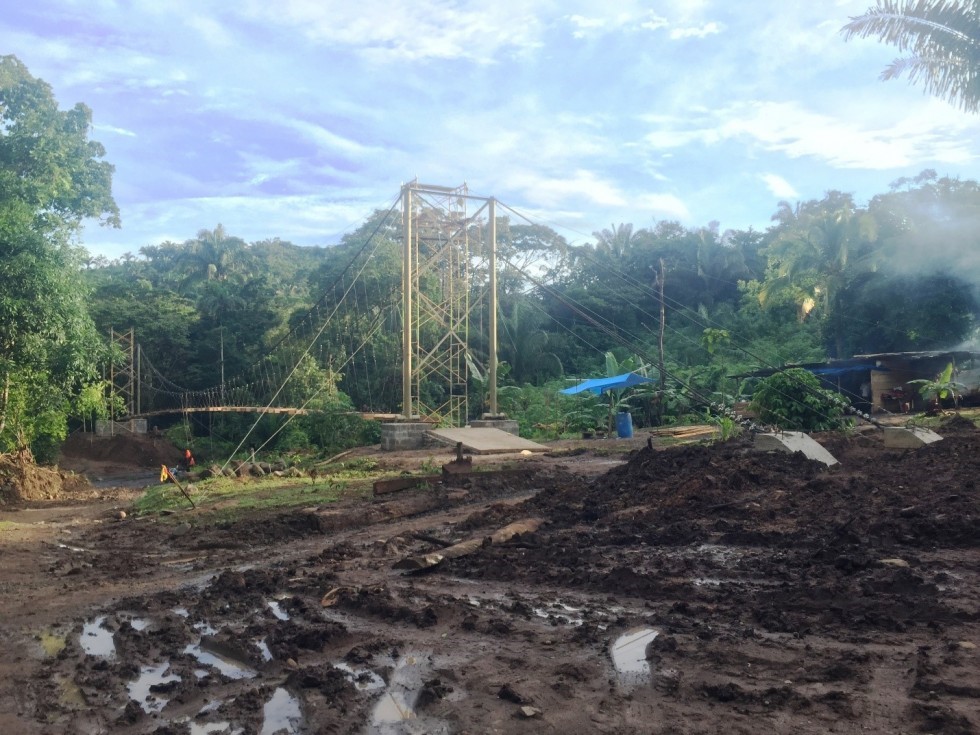
Early morning sunshine
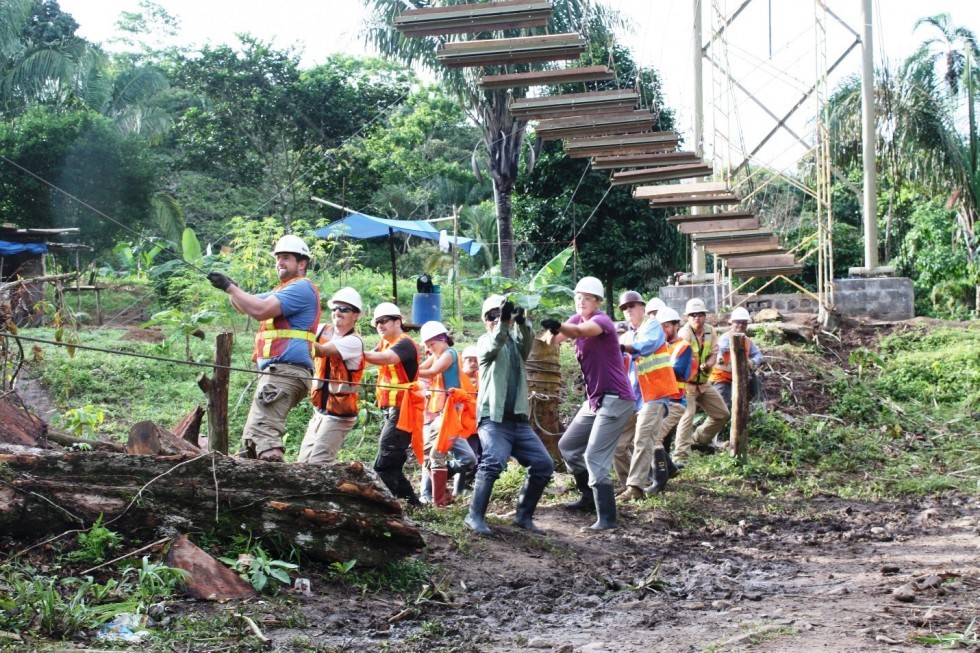
Pulling all the slack from the back side restraint cables
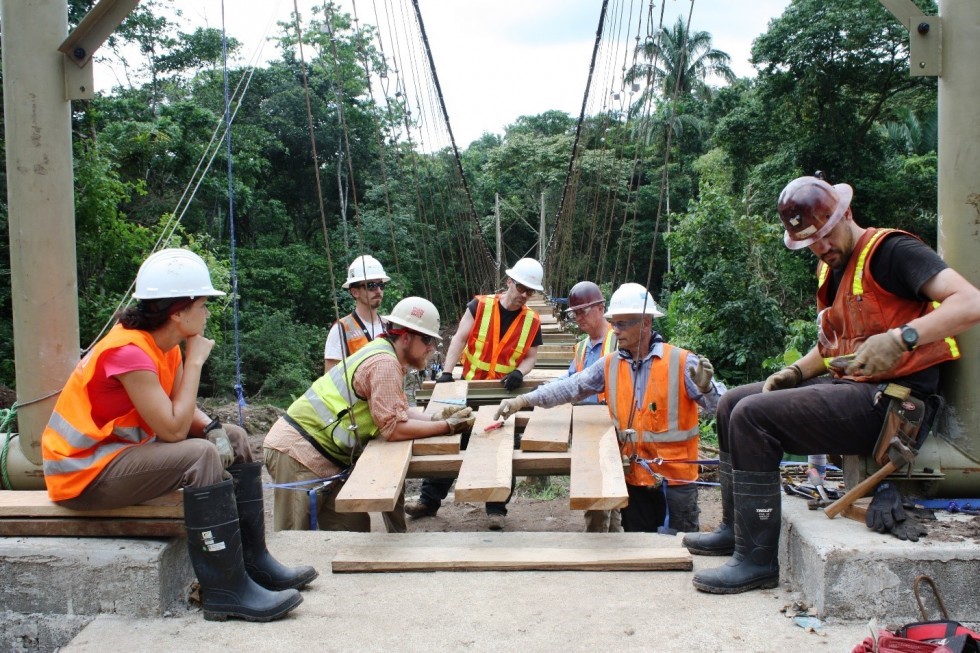
Brainstorming deck board placement

Deck board production begins: Left, Mat Reynolds and Chris Scollard, Left Side; right, Patrick Haley and Jon Murphy, Right Side
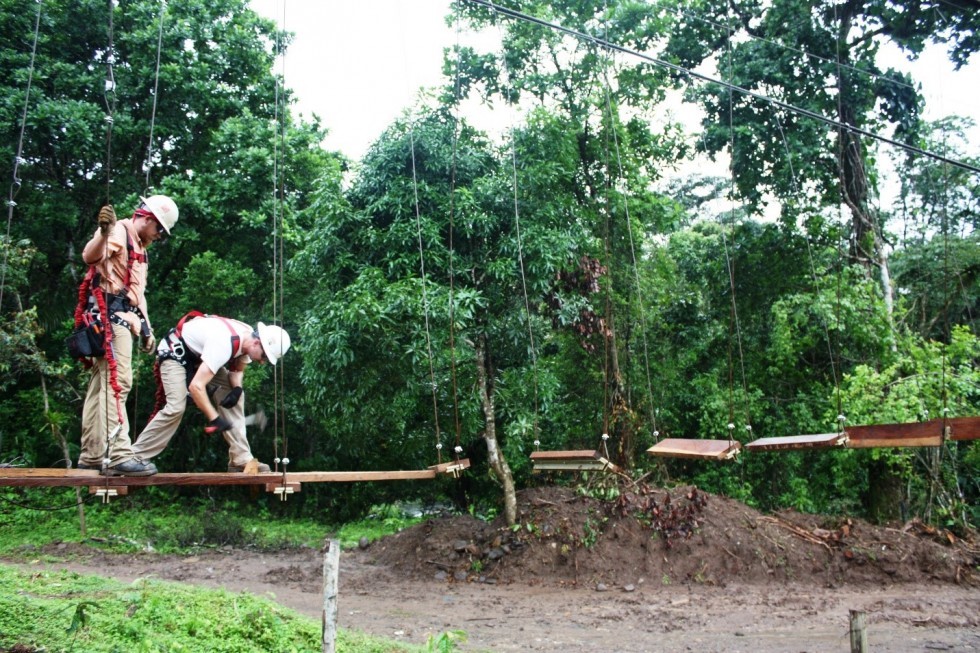
Mind the gap

Mike Krulc, demonstrating superior wheelbarrow utilization skills
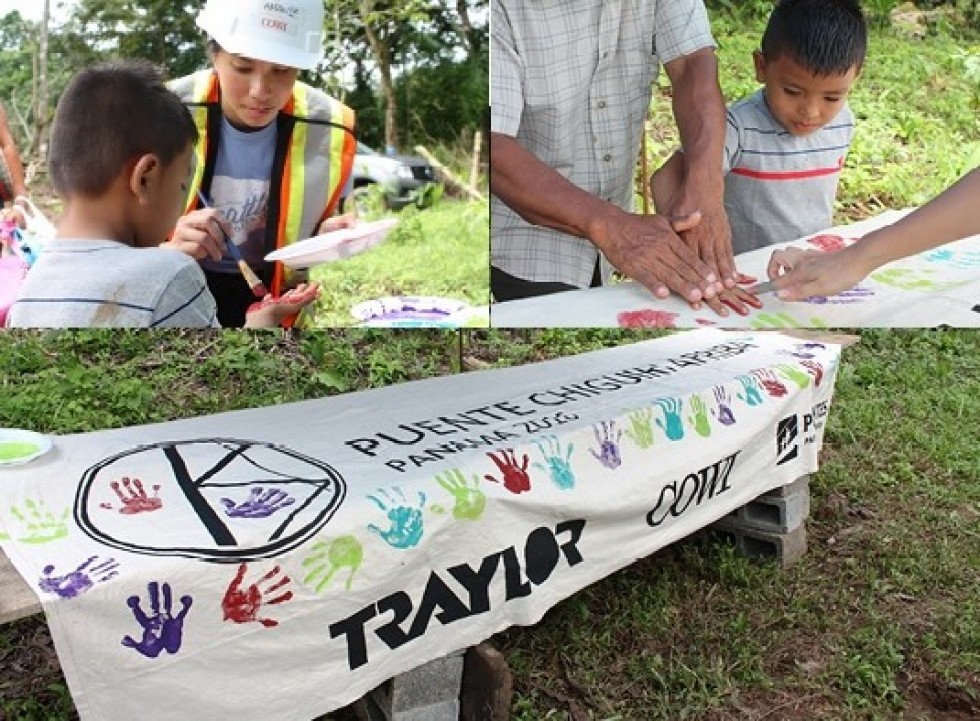
Schoolchildren and their families apply handprints to the team banner as they pass through the site. The children, once they got over their shyness, were very excited to put their stamp on the project
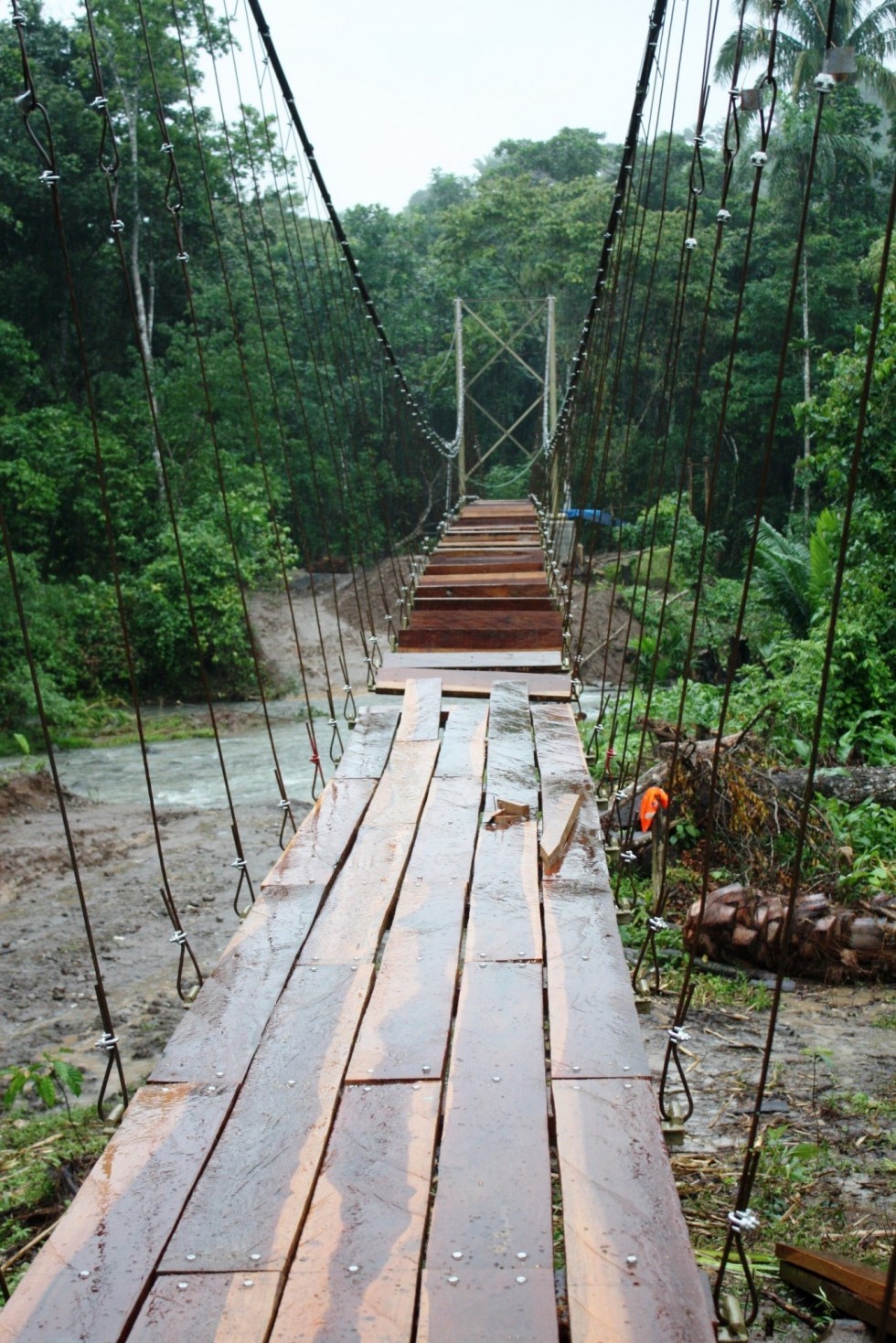
The decking at the end of the day, slick with rain. Notice anything different? Yup, the scaffolding is gone—and the towers are still standing!
Dia de Los Niños
On Monday, Jose Ruiz escorted Amanda Wong and Ashlea Scaglione off site and up the hill to the elementary school, where they could announce the bridge inauguration and tour the facility. The 92-year-old school, next door to the Catholic church, is a private parochial school with about 300 students. Every day there are two sessions of classes: 8am – 12pm for kindergarten through sixth grade, and 1pm to 5pm for grades seven through nine.
When they arrived, they found that it was a special day: Dia de los Niños, or Children’s Day, and instead of the usual uniforms and classes, they found students wearing whatever they wanted and having a party. Most of the children were in the open air auditorium and the teachers were presiding over a raffle, potato (or in this case, sugar) sack races, and conga lines. One of the teachers was acting as DJ, playing loud Panamanian pop music. It was a scene that takes place everywhere—the barely controlled chaos of kids having fun.
Amanda and Jose announced the inauguration, inviting the children and their families to the event. Afterward, Jose escorted Amanda and Ashlea around the rest of the school, showing them the classrooms, cafeteria, and cooking area, where a lunch of chicken and rice was being prepared. It was gratifying to see how happy the children were, and to know that the bridge will assist them in their schooling by making travel to and from a little easier.
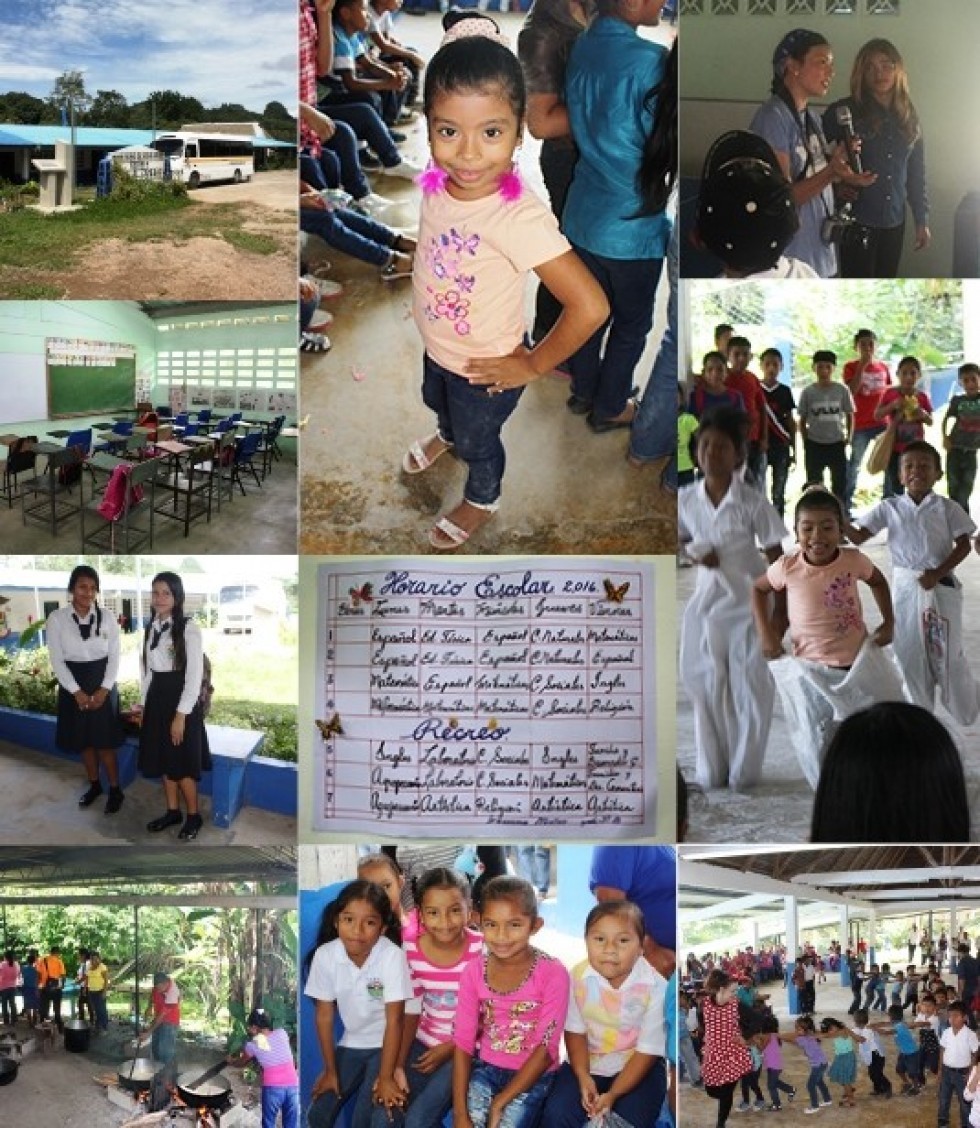
Fun at school: clockwise from left, a view of the main building; striking a pose; Amanda Wong invites the children and their families to the bridge inauguration; conga line; good friends; cooking lunch; sixth graders in uniform; a third grade classroom; and center, a third grade class schedule
July 17, 2016 – Day 7: That Thing in the Jungle is Starting to Look Like a Bridge!
Work Hours: 7:30am – 5pm
Weather: Mid 80s, overcast
Peak Local Staff: 6
Conversations with Our Team
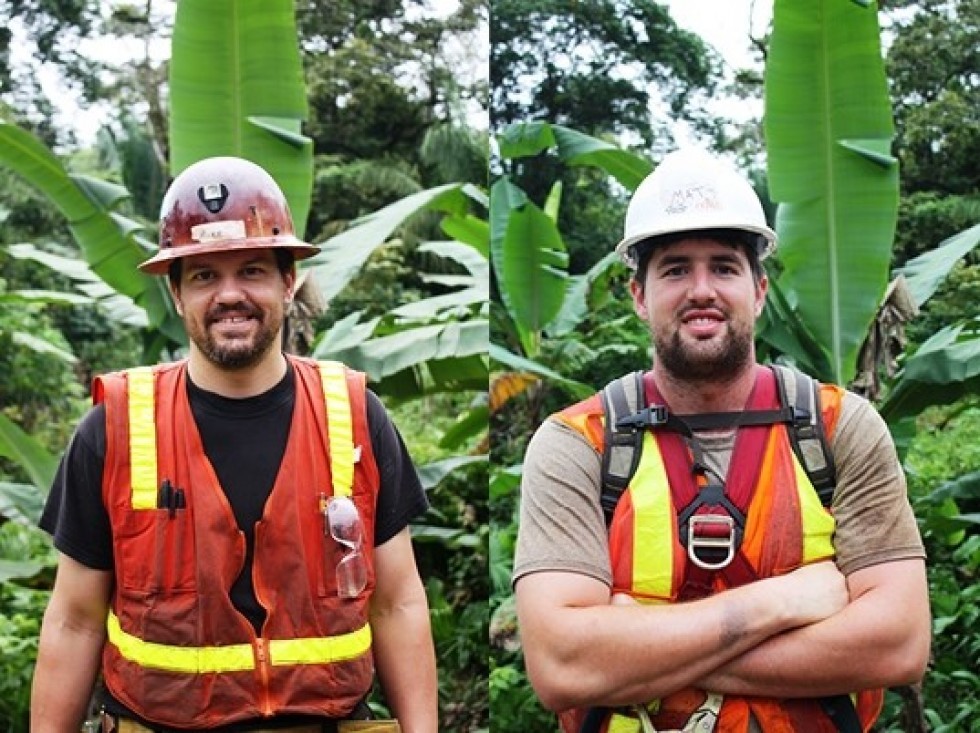
Left, Mike Krulc, Traylor Bros. Project Manager, B2P Support Team Member; Right, Mat Reynolds, COWI Junior Bridge Engineer, B2P Project Manager
Tell us more about the Left Side.
MR: It’s an interesting challenge, crossing the river every day. You have to be prepared. We fill buckets with everything we need and carry it all over.
MK: I like it over there! It’s quiet and peaceful, and our team is very productive. It’s got a great view and we’ve had some great wildlife sightings—like the toucan and a whole family of butterflies.
Has the trip met your expectations?
MR: In terms of working with the locals and actually building a project with my own hands, it has definitely met my expectations. And it has exceeded my expectations in terms of how much work it actually is!
MK: Oh yes, it’s definitely exceeded my expectations in terms of general enjoyment. I thought it would be more difficult—not just the project and the work, but the accommodations and everything else. As far as morale and general happiness goes, it’s been way better than I expected. One thing I do regret, though, is not being able to speak Spanish. It would be so much more fun if I could communicate with the locals. And things have taken a bit longer—rain is difficult, but lightning is the real issue. But I feel really good about finishing and I’m looking forward to inauguration.
Sunday turned out to be the opposite of a day of rest. Instead, the team made significant progress, making up for the loss of time due to rainout the previous afternoon. The crossbeam and suspender hanging operation was in full swing before mid-morning. At times, the suspenders became stuck, preventing the main cable from advancing. Additionally, the restraint cable was tangled with the suspenders at points, making it difficult to pull each side’s crossbeams into their final configuration in the middle of the span. To remedy the problem, team members used rebar lashed to a long stick with hooks at the ends to break the tangles and free the crossbeams. At the end of the day, all crossbeams and suspenders were in place.
The final activity that occurred was setting the safety cable, which is the temporary cable the team will tie off to while installing the deck boards. The cable was threaded through the upstream Right Side tower saddles and through one saddle of the Left Side tower, and then anchored to a tree stump.
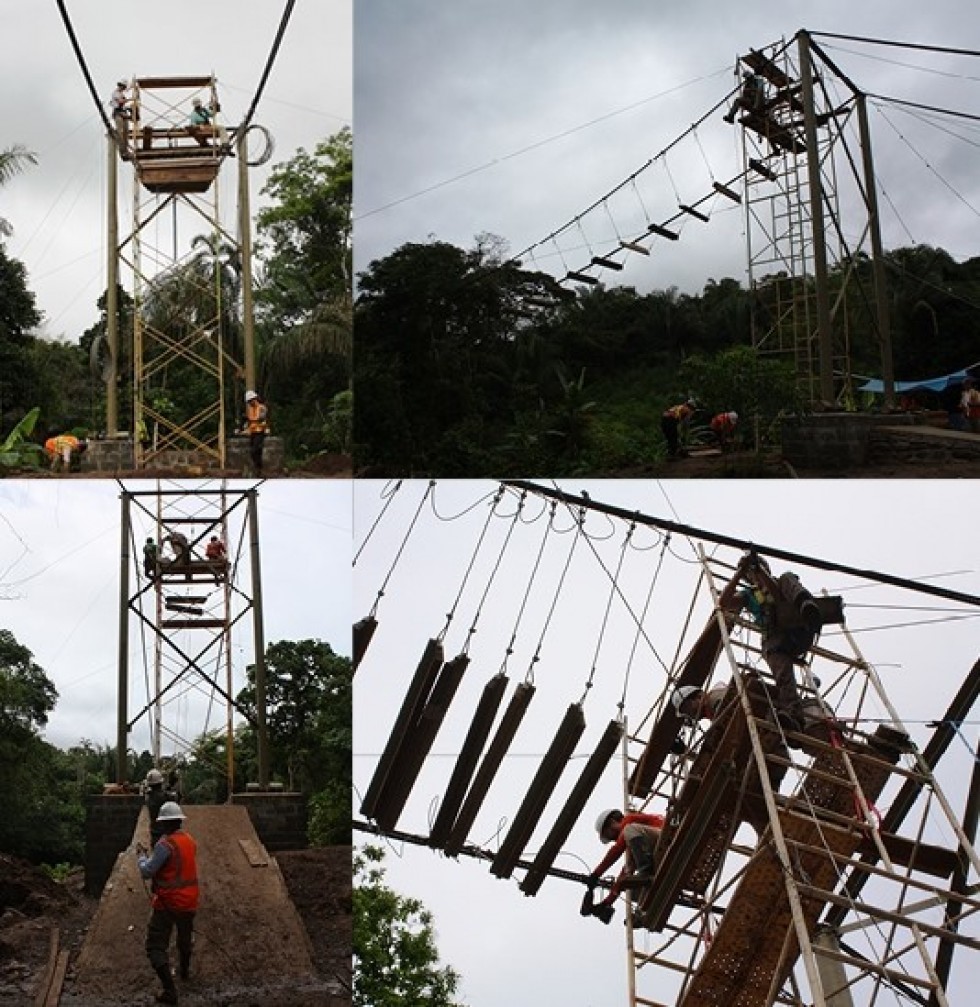
Crossbeam hanging in full swing: top right and left, Right Side production; bottom right and left, Left Side production
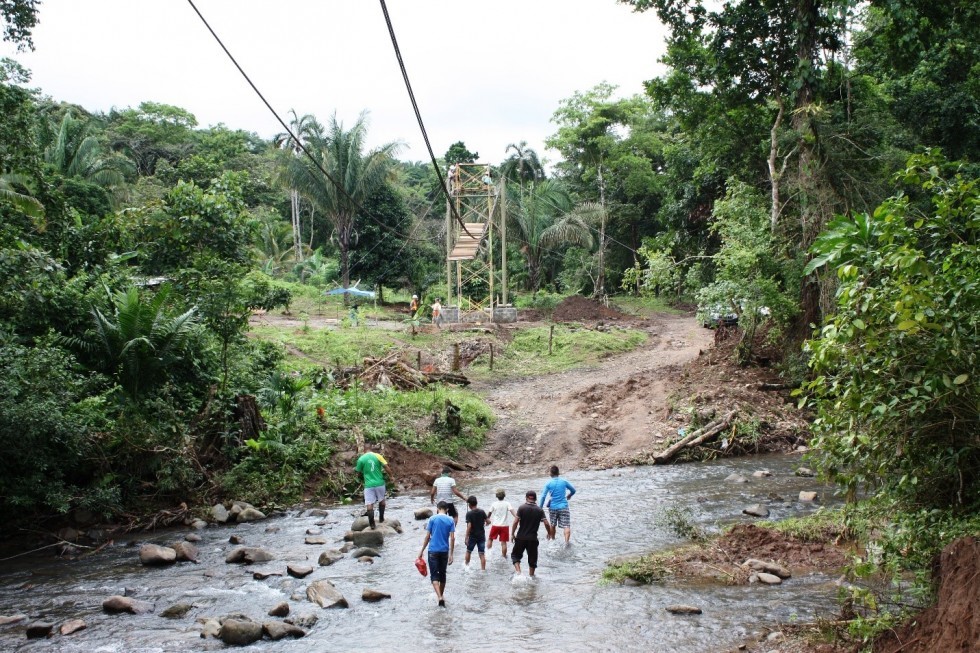
Making progress on the Right Side
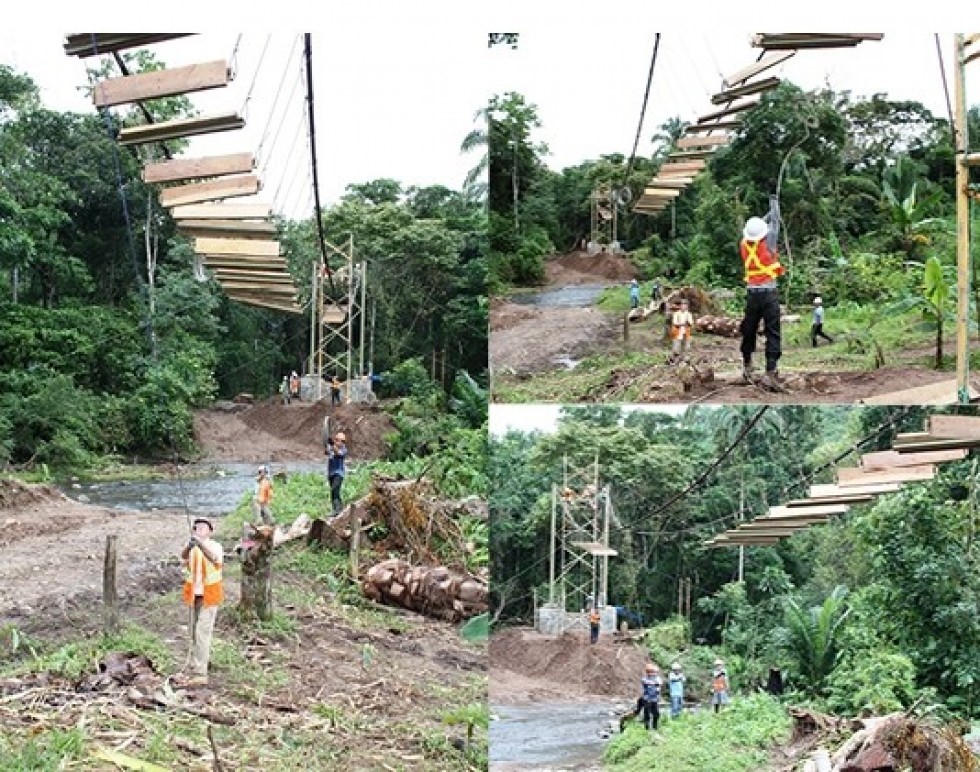
Cowboy up: left, Wayne Jones pulls the beams toward the center; top right, Tobias Petschke tosses a line over a beam to attempt to untangle them; bottom right, pulling toward the center of the bridge
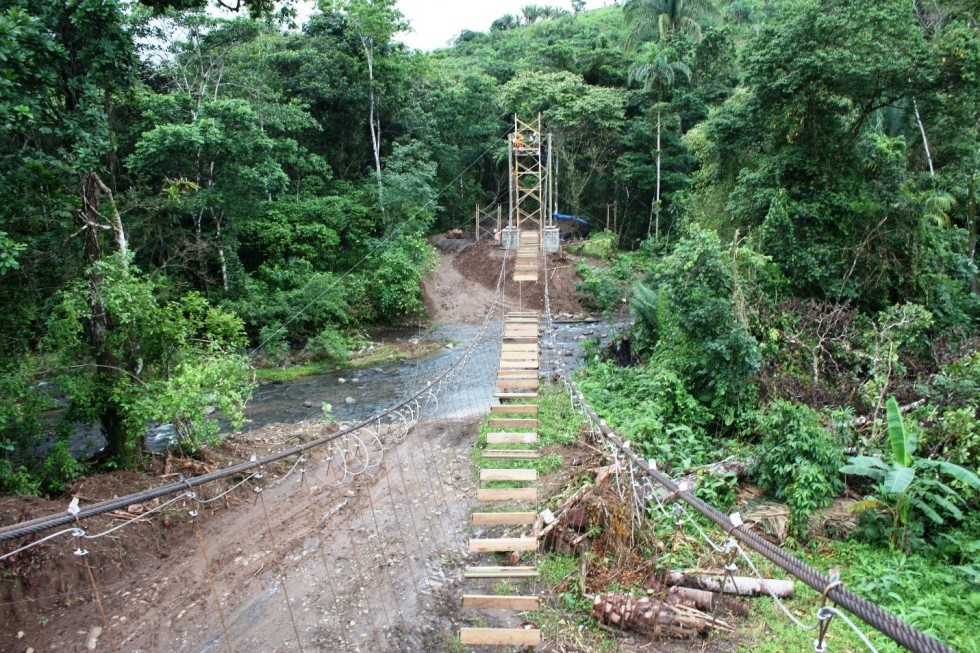
The gap narrows…
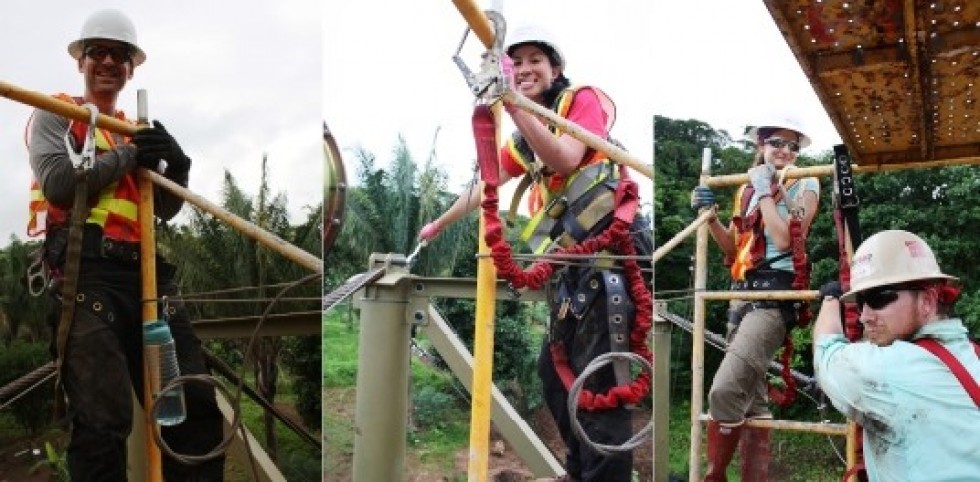
Taking a (short) turn at the finish: left to right, Tobias Petschke, Amanda Wong, and Ashlea Scaglione hang the last four deck boards and install the bolts on top of the Right Side tower, while Patrick Haley patiently walks everyone through the process
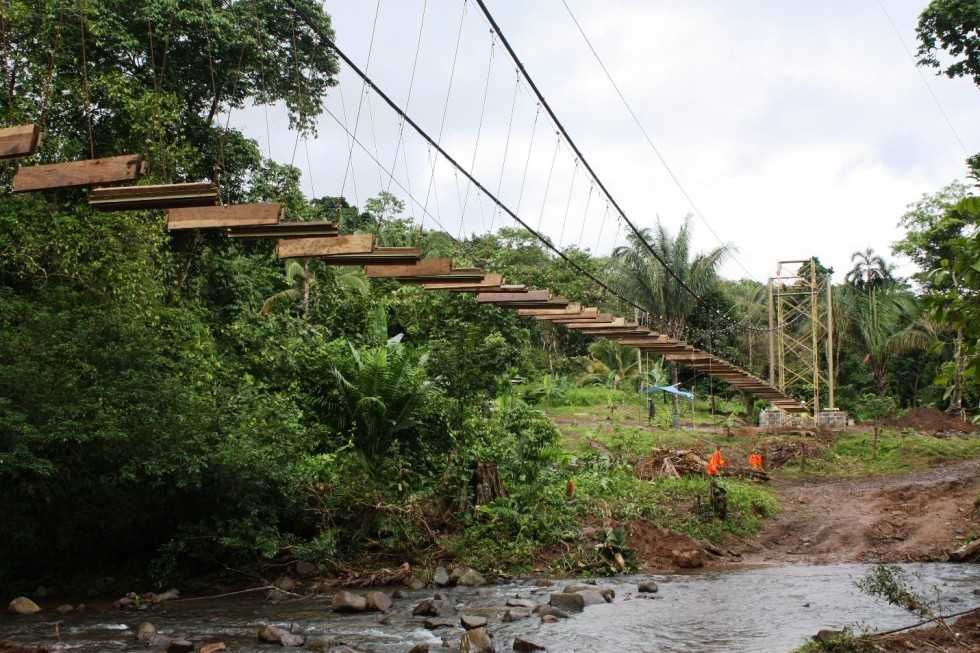
Why, this contraption is starting to resemble a bridge!
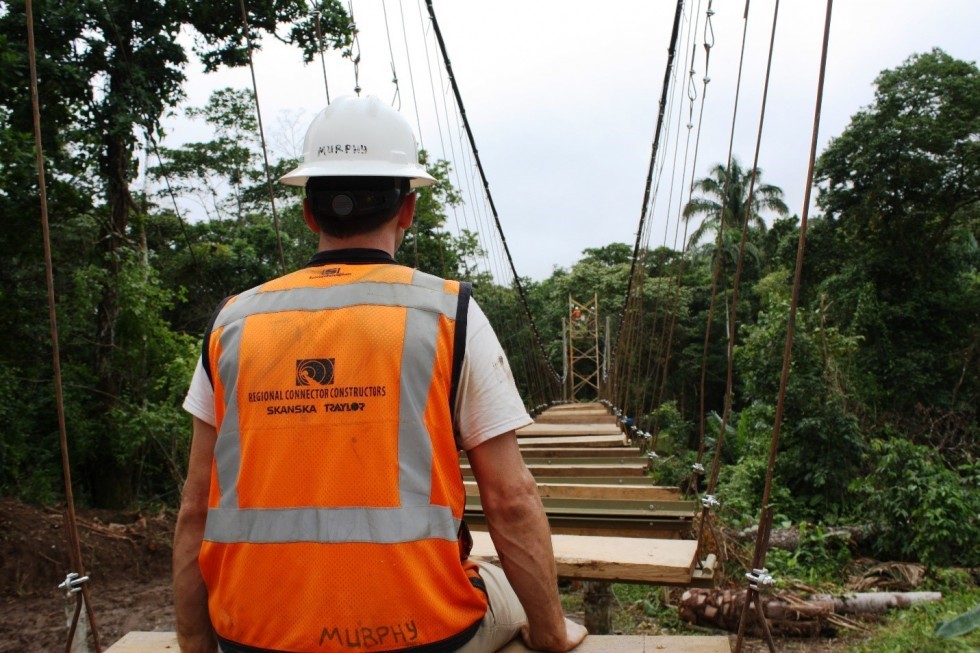
Jon Murphy takes a moment to enjoy the team’s handiwork
Local Tidbit
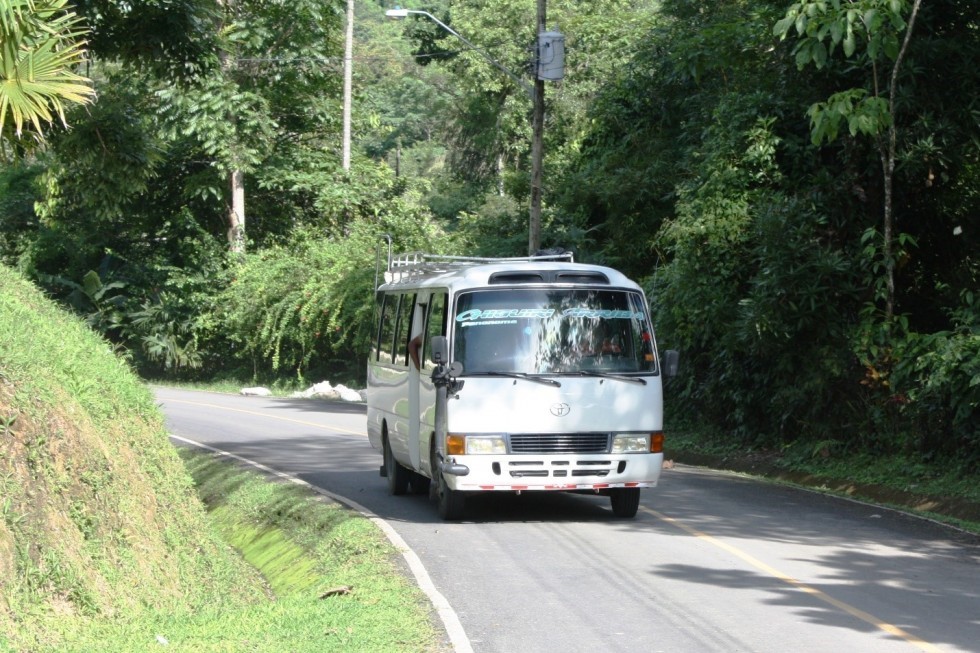
There are all sorts of ways to get around Chiguiri Arriba, the neighboring villages, and back and forth to Penenome, but one of the most popular is the bus, or chiva. Chivas, mid-sized Nissan diesel vans with tinted windows, thread their way up and down the winding roads every day. They are owner operated and do not necessarily follow a regular schedule or stops; at times they may even stop for personal errands or visits, leaving passengers waiting in the van for long periods of time. All chivas go back and forth to El Centro, or the center of Penonome, and branch out from there; the bus’s destination is posted above the windshield. It costs $2 to travel from Chiguiri Arriba to Penonome, and less for students. Best of all, the direct translation of chiva is “goat.”
July 16, 2016 – Day 6: Set and Sag, Rainout, Sloth!
Work hours: 7am – 3pm
Weather: Mid to high 80s, partly sunny, afternoon thunderstorm
Peak Local Staff: 12
Meet Eliuterio Martinez
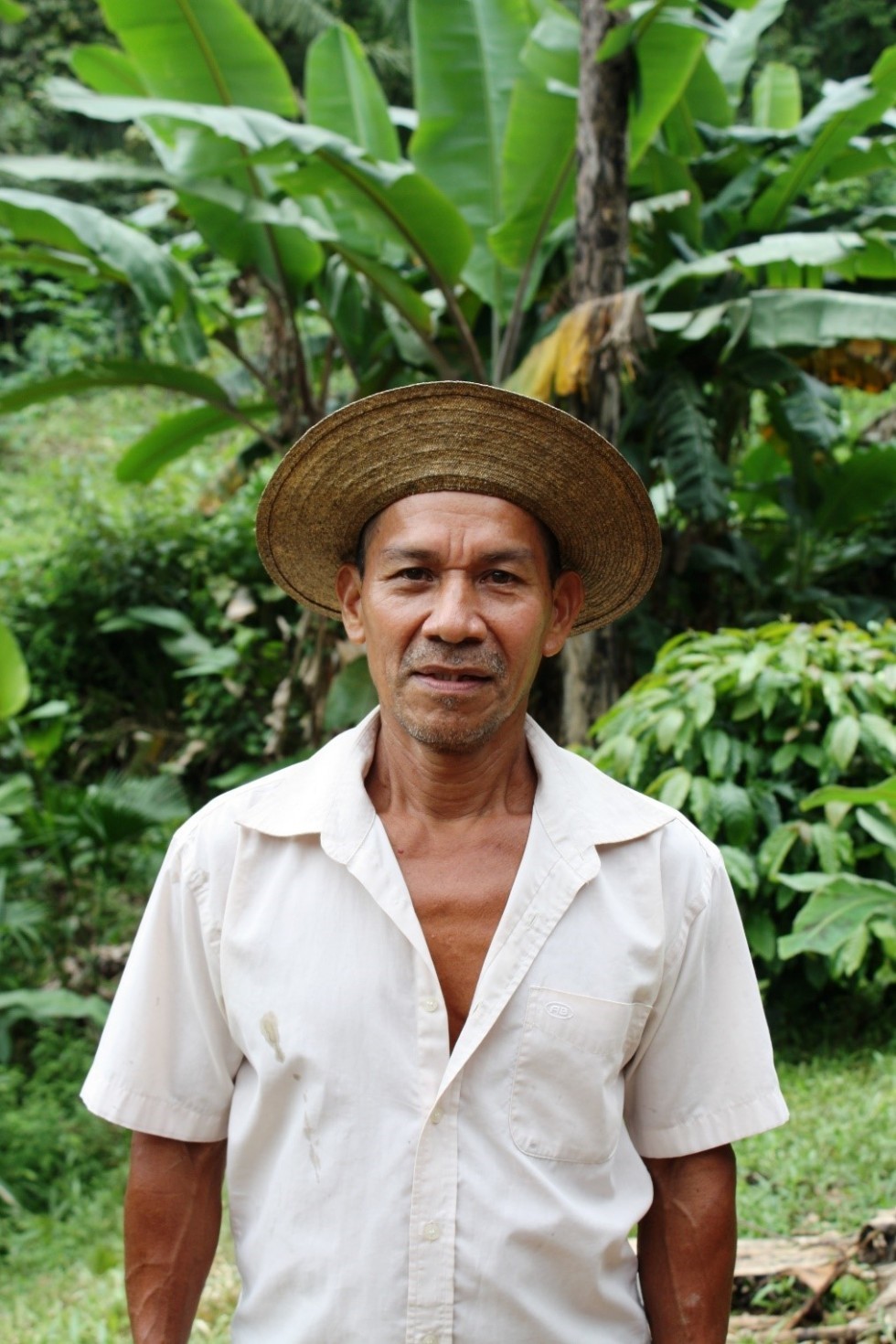
Eliuterio Martinez is our most dedicated hand, joining us on site every day, working, managing the other villagers, and making sure we all have chicha (fruit juice that the locals make on site). He is second in command to Jose within the community. Sixty years old, he has always lived in Chiguiri Arriba. He is in charge of general community farming and works a small plot of corn, coffee, banana, and yucca adjacent to our site. He has eight children, five boys and three girls, the majority of whom live in Panama City.
In addition to stretch and flex, on Saturday we were instructed in a few yoga poses by the B2P site manager’s girlfriend. The team enjoyed the sun salutations and warrior pose, but the locals were definitely puzzled by the additional activity, and those who arrived while we were stretching took wide berth to avoid being asked to join, throwing perplexed looks in our direction.
The entire morning was spent setting the sag. The team inched the cables back and forth, clamping and unclamping them from the anchor. Despite a few challenges, before lunch they were set at approximately one half centimeter and one centimeter below target. During this time, the restraint cables were set up and spooled on each side in preparation for hanging the crossbeams, which was the next activity.
After lunch, the crossbeam operation began. A pulley system was set up on each side (two on the Left Side scaffolding and one on the Right) to hoist the crossbeams from the ground. Once a crossbeam reached the top of the scaffolding, the suspenders were clamped to the restraint cable and around the two main cables. Once everything was clamped, someone on the ground pulled a rope tied to the first crossbeam, which in turn pulled the restraint cable, advancing the line of crossbeams toward the center of the bridge.
The process was just beginning to work efficiently when a thunderstorm rolled in. The team waited for nearly an hour for it to pass, but even though the rain let up, the thunder and lightning lingered, so for everyone’s safety Construction Manager Dave Pease called it a day. When we left for the evening, four crossbeams had been hung on the Right Side and one on the Left.
Dirty, drenched, and slightly concerned about the schedule, when the team arrived at the hostel they encountered a pleasant surprise—a sloth had decided to eat its dinner hanging from a tree directly outside the dining patio. Everyone grabbed a beer and watched the show. Then, a couple hours later, the team was treated to a feast of barbequed chicken, chorizo, and pork, and fried yucca. By far the best meal of the trip, everyone happily stuffed themselves and retired with full stomachs, ready for an early start the next day—due to the rainout, Off Sunday had become Working Sunday.
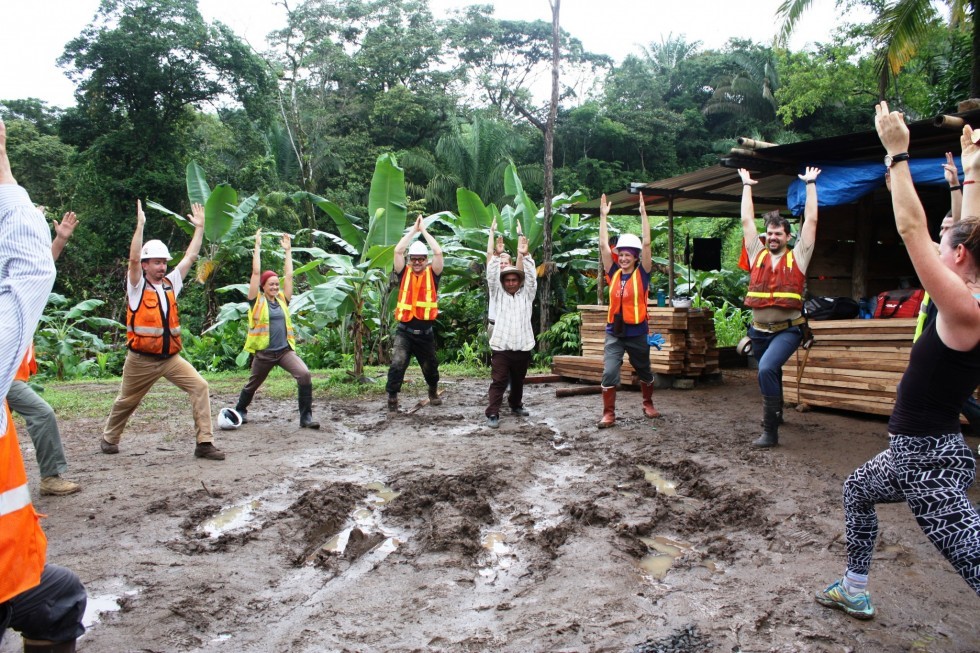
Warrior pose: a new addition to stretch and flex
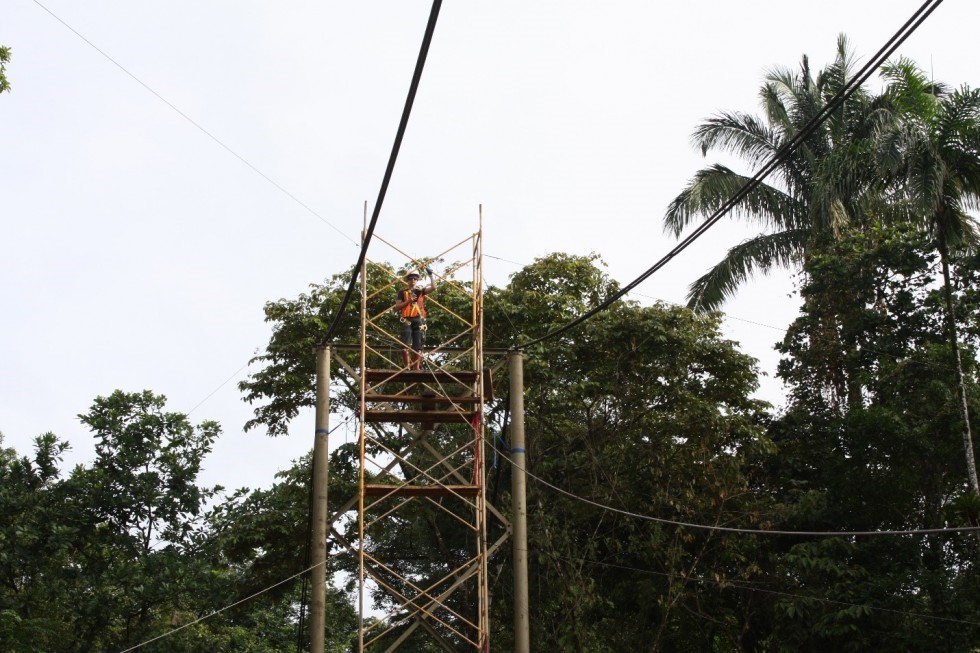
Ashlea Scaglione enjoys a moment of solitude atop the Left Side scaffolding
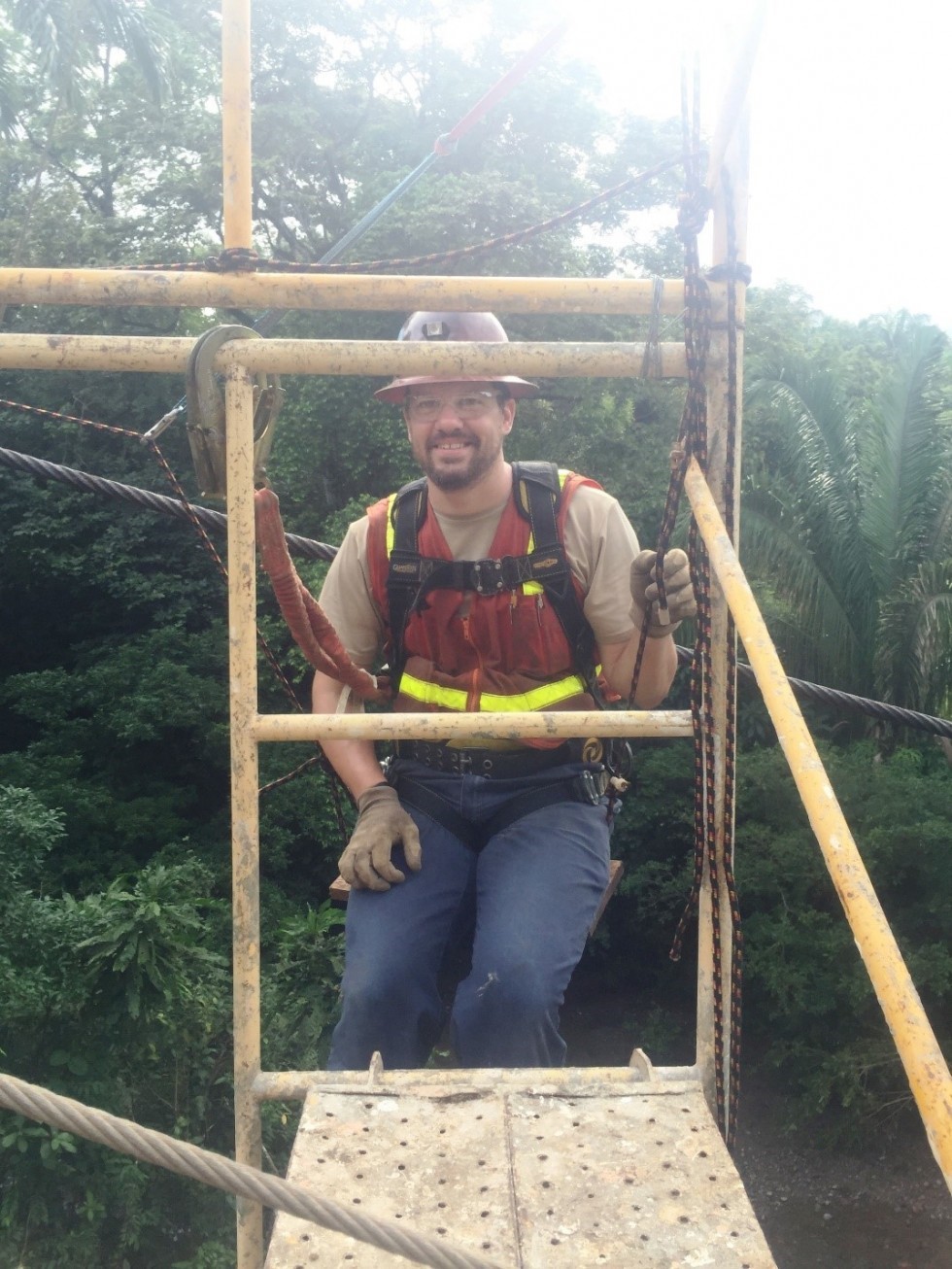
Mike Krulc demonstrates the safety (and comfort) of his bosan
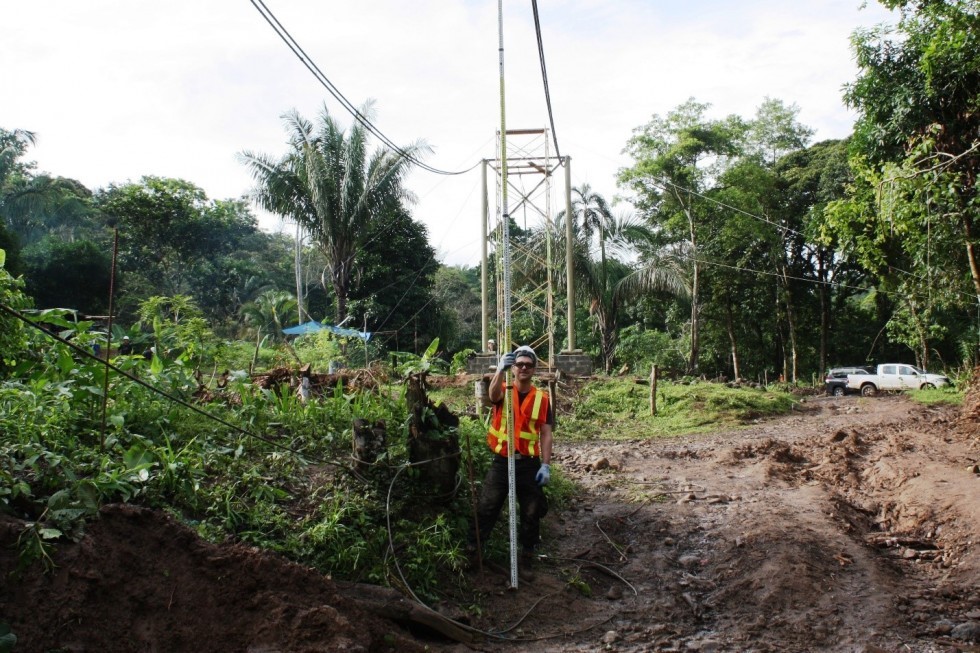
Tobias Petschke cheerfully holds the survey rod…for hours
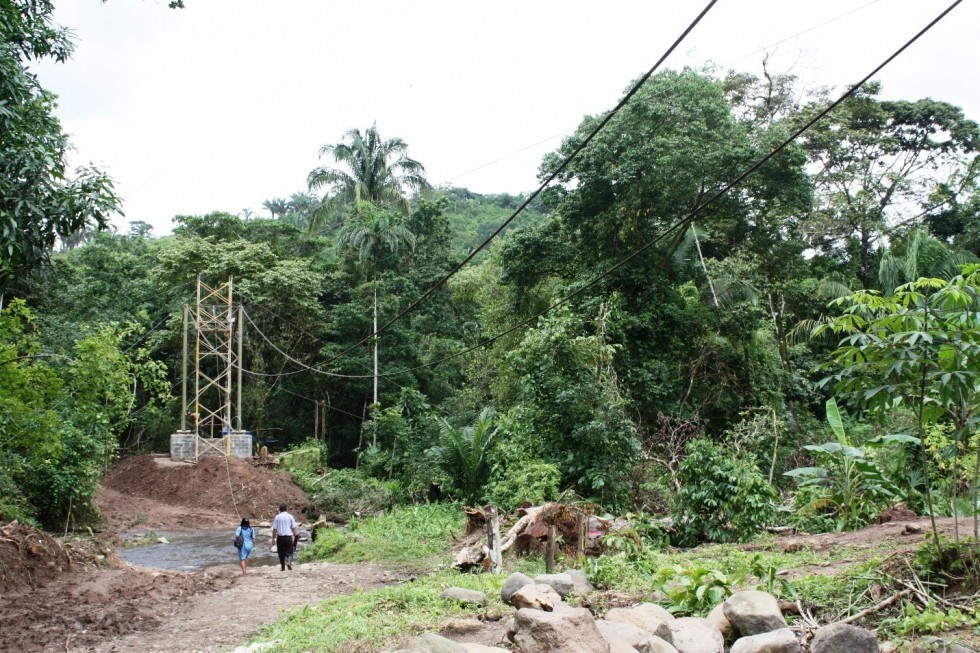
The final main cable configuration
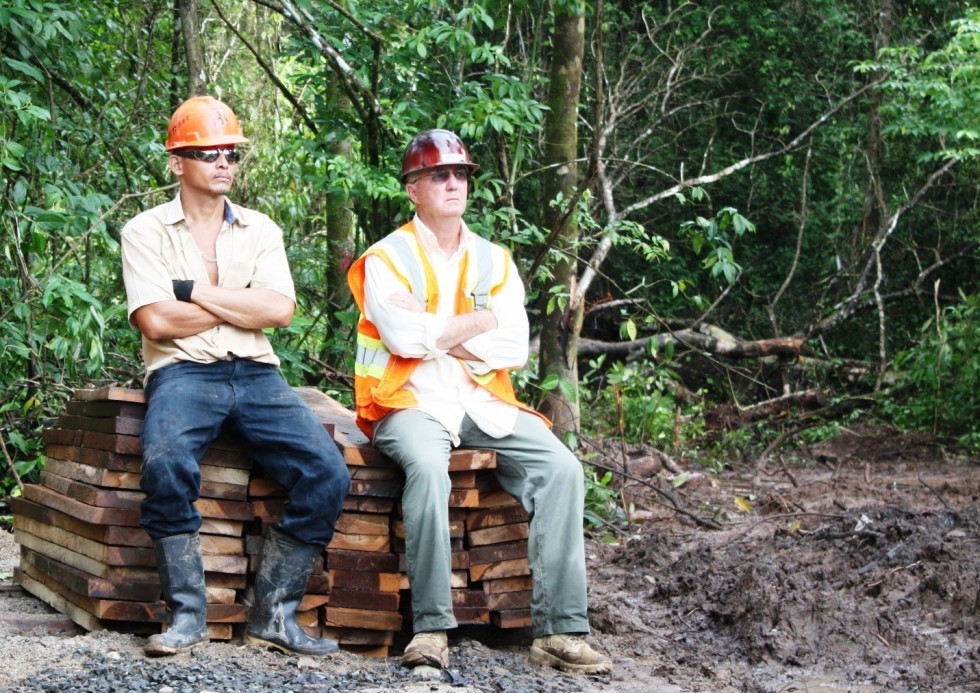
Chon, one of the masons, and Wayne Jones observe the work. They may be from different worlds, but judging by their body language, at this moment their thoughts may be exactly the same
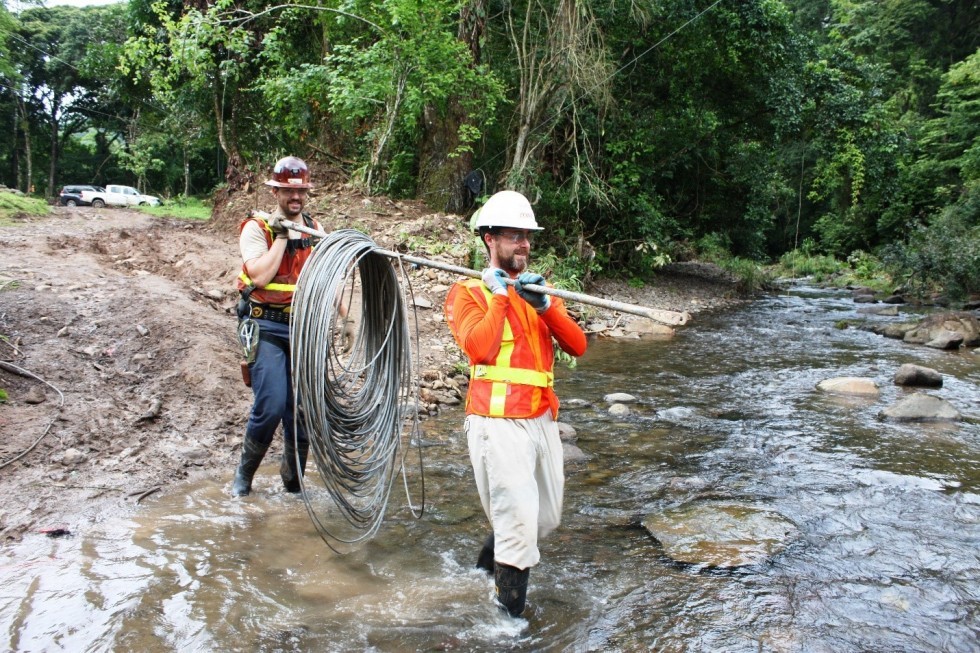
Mike Krulc and Chris Scollard carry restraint cable to the Left Side
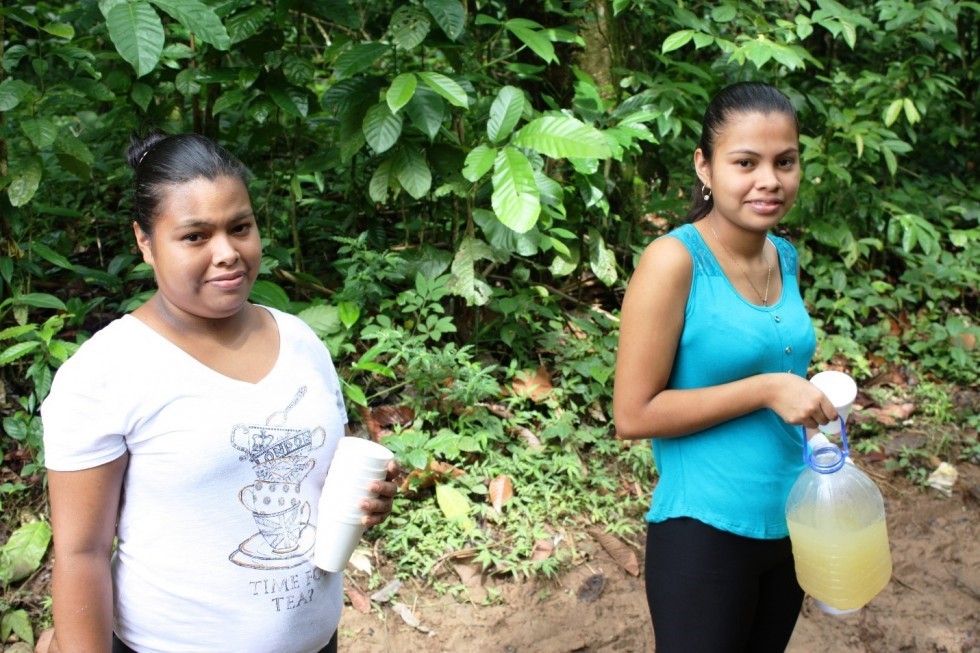
Locals delivering chicha naranja (fresh squeezed orange juice) to everyone on site

Beginning the crossbeam hanging process: left, hoisting the beam to the top of the scaffolding; right, clamping the hangers to the main cables and moving them toward the center of the bridge

Rainout!
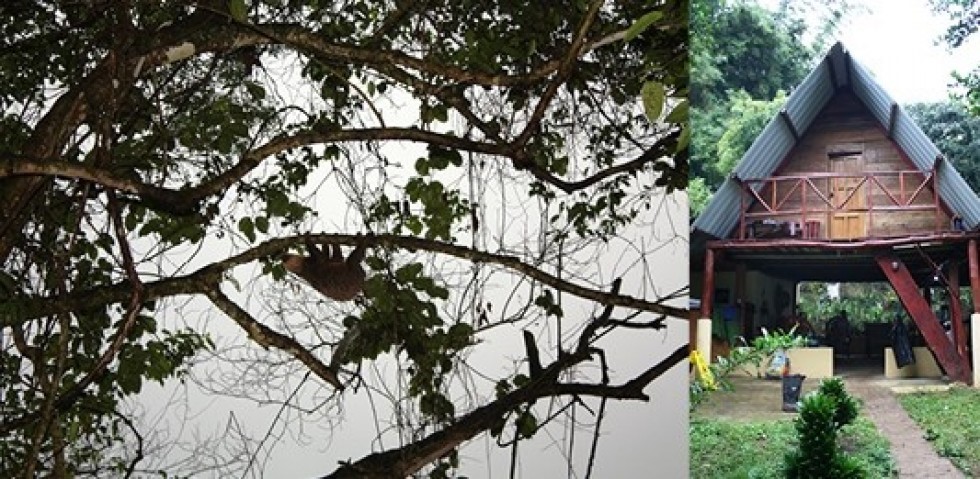
A warm welcome home: left, an exhibitionist sloth; right, our patio/dining/common area
July 15, 2016 – Day 5: Main Suspender Cables Part 2, Crossbeam and Suspender Assembly, Ladies Who Lunch
Work Hours: 7am – 5pm
Weather: Low 80’s, slight breeze, passing showers
Peak Local Staff: 10
Conversations with the Team
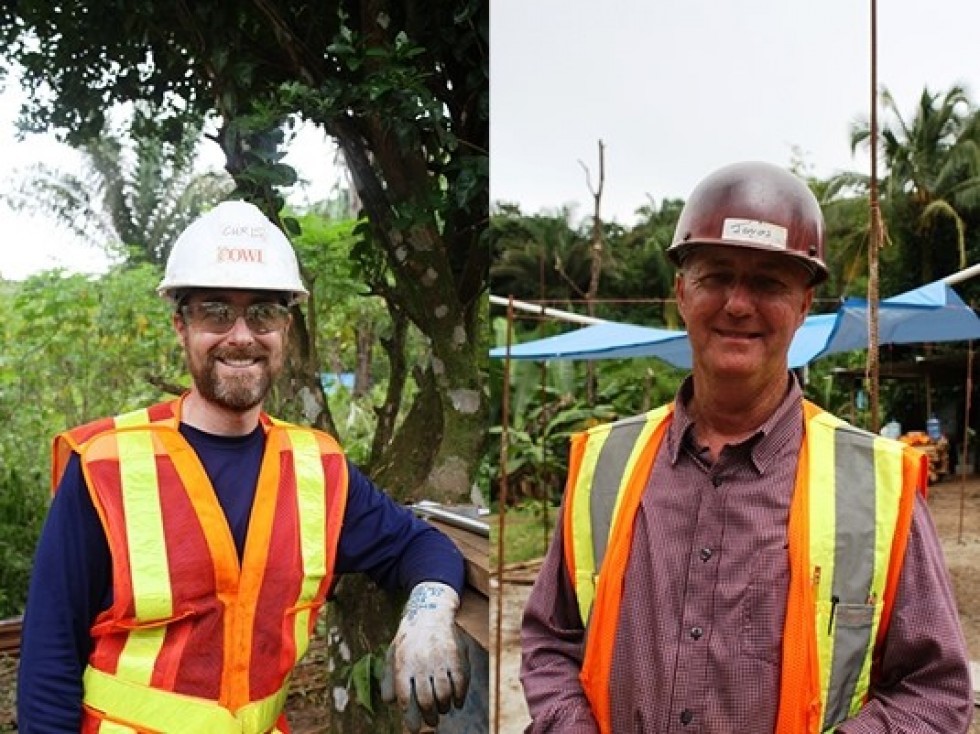
Left, Chris Scollard, COWI Chief Project Manager, B2P Support Team Member; Right, Wayne Jones, Traylor Bros. Senior Project Manager, B2P Support Team Member
We’re now a little more than halfway complete. How do you feel about our progress?
WJ: On the Right Side, the terrain is much more conducive to labor. The Left Side is a muddy mess and takes more labor and effort to do the same amount of work.
CS: Yes, the majority of the challenges have been due to the site conditions over there.
WJ: We minimized the problem by erecting the main cable from the “good” side and bringing it over to the “bad” side, rather than working from both sides as prescribed by the B2P manual.
How about the production operations?
CS: They have gone smoothly, but are much more predictable than the main operations due to the large work area. Because much of it is under cover, we were able to continue working regardless of the weather.
WJ: Prefabrication is ahead of schedule, partially because of the covered area, and partially because the main operations were sometimes delayed due to rain.
CS: We were also able to set up a process and put the larger group of locals to work.
How do you feel about the local help?
WJ: They’ve been willing and enthusiastic.
CS: Yes—we wouldn’t be where we are without them doing the bulk of the production work.
WJ: Right—there were certain components of the work that were past our team’s ability to physically perform them.
CS: And for production, as I said, we defined the process, explained it to them, oversaw the work, and checked it, but didn’t necessarily do all of it ourselves.
WJ: I think B2P brings a technically proven system to the job, which our engineering component has refined, and our construction component has the capability to make some minor refinements while constructing in a timely fashion. With the addition of the local resources, the result is a very capable, integrated work force.
What is your favorite part of the trip so far?
WJ: At 2pm when you’re looking at 5 or 6pm and thinking what you need to accomplish is going to take longer than that—I’m impressed with the extra effort the team puts in at the end of the day to get us to where we need to be, even when we’re all tired and ready to go home.
CS: For me, I’m usually in an office, so the act of physically producing something, especially something with a genuine purpose, is rewarding. Seeing the people who will benefit from it every day is rewarding. It is a bridge that will be used.
Friday was a hugely productive day. The team finished cutting and drilling the deck plants, except for the few being used for platforms on the scaffolding, staging, and other general use. Those will be finished as they become available.
All of the suspenders were attached to the crossbeams. The team laid them out on either bank—half on one side and half on the other—and completed the process with three passes: the first to thread the suspenders through the crossbeam, the second to attach the clamps, and the third to torque them into their final tightness. The scaffolding was prepared for hanging, with a bosan constructed to assist in reaching the cables when attaching the suspenders and crossbeams. The restraint cables, which are the cables from which the suspenders will be hung, were marked in preparation for hanging as well.
In addition, the other two of the four main suspender cables were threaded through the cable saddles and raised to a position very close to the permanent sag.

Connecting suspenders to crossbeams: left, Amanda Wong and Chon attach the suspenders with clamps; right, Chon carefully tightens each
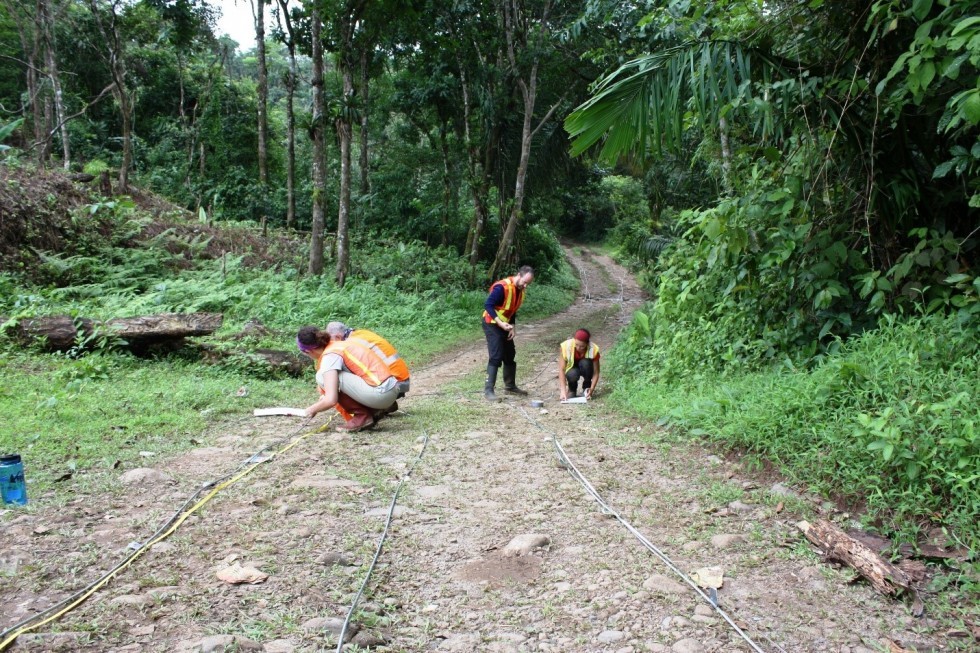
Ashlea Scaglione, Dave Pease, Chris Scollard, and Christine Idzerda measure and mark the four restraint cables for hanging the suspenders
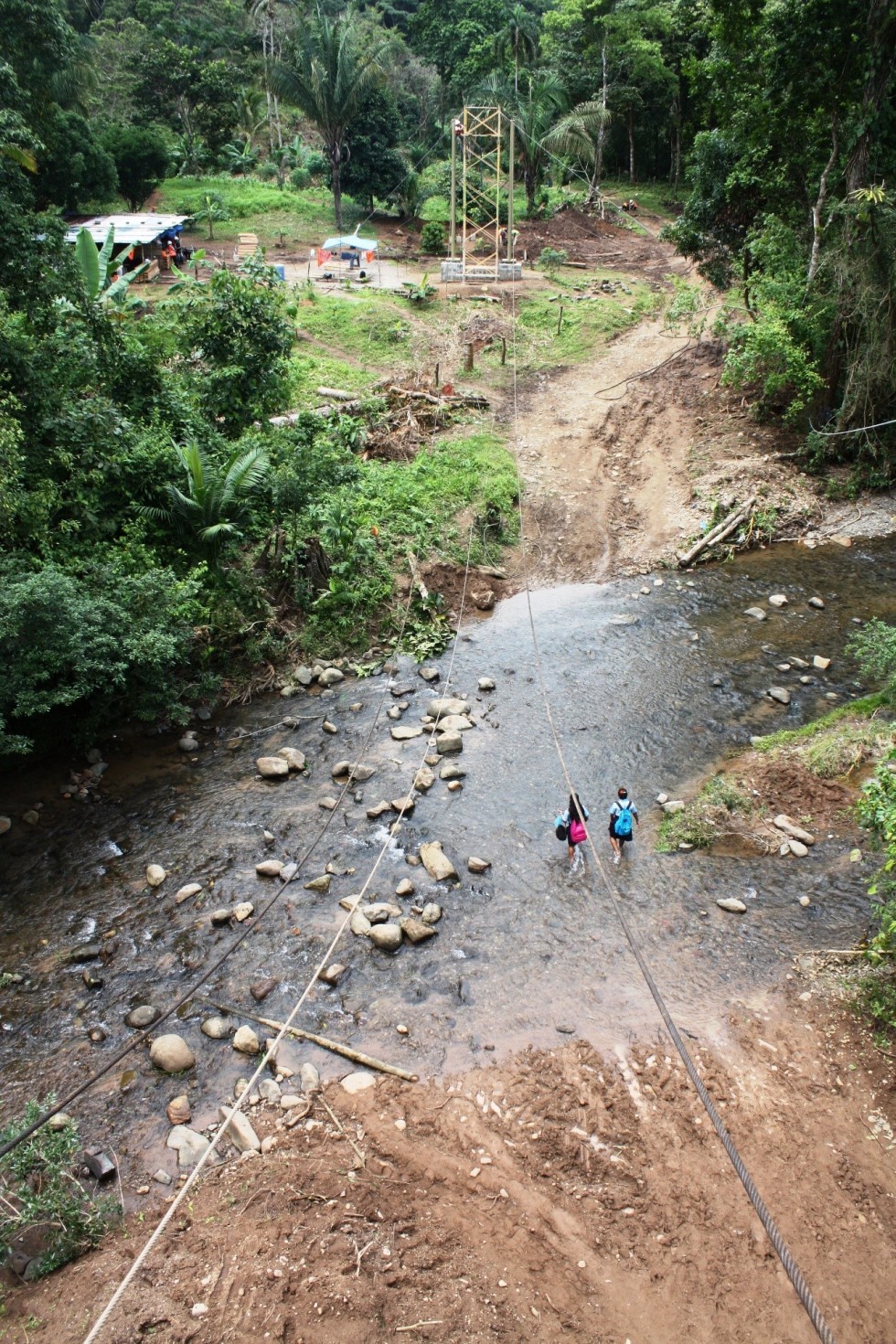
The view from atop the Left Side scaffolding
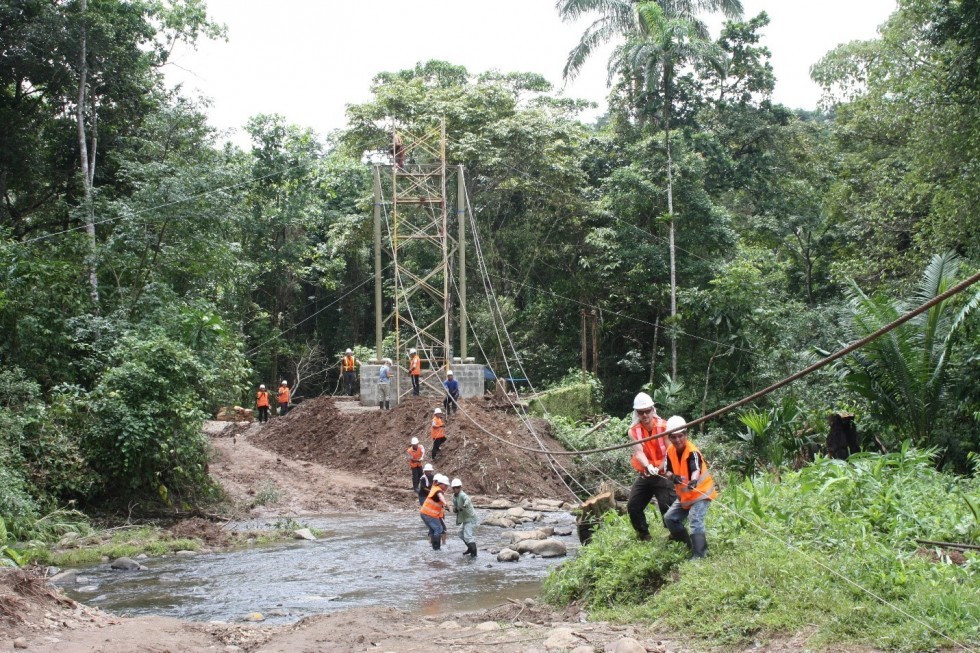
The team repeated the same process as the previous day to hang the final two main suspender cables
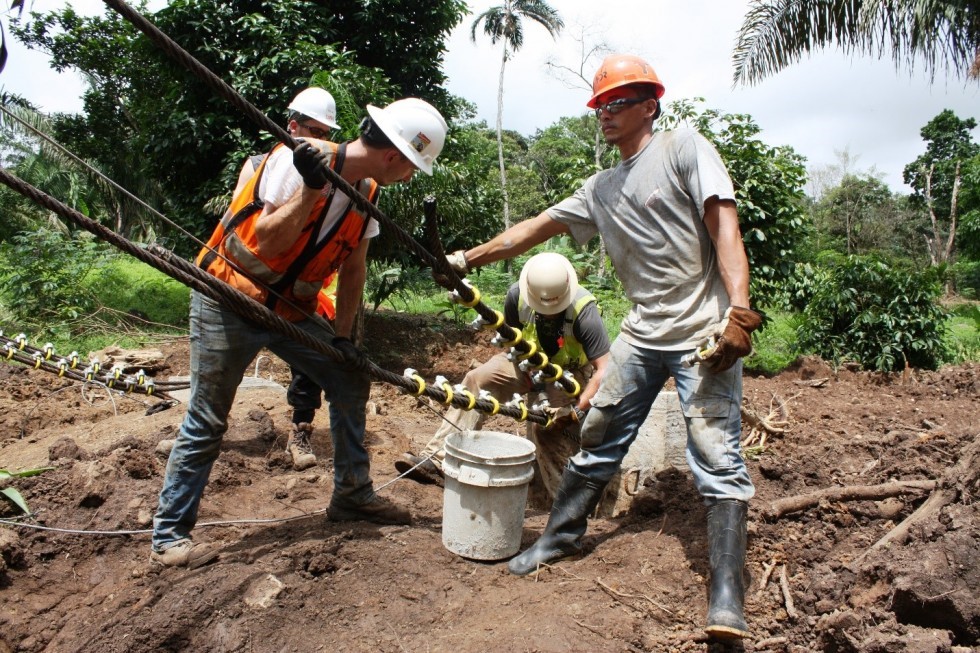
Jon Murphy, Patrick Haley, and Chon affixing Crosby clamps to the Right Side main cables
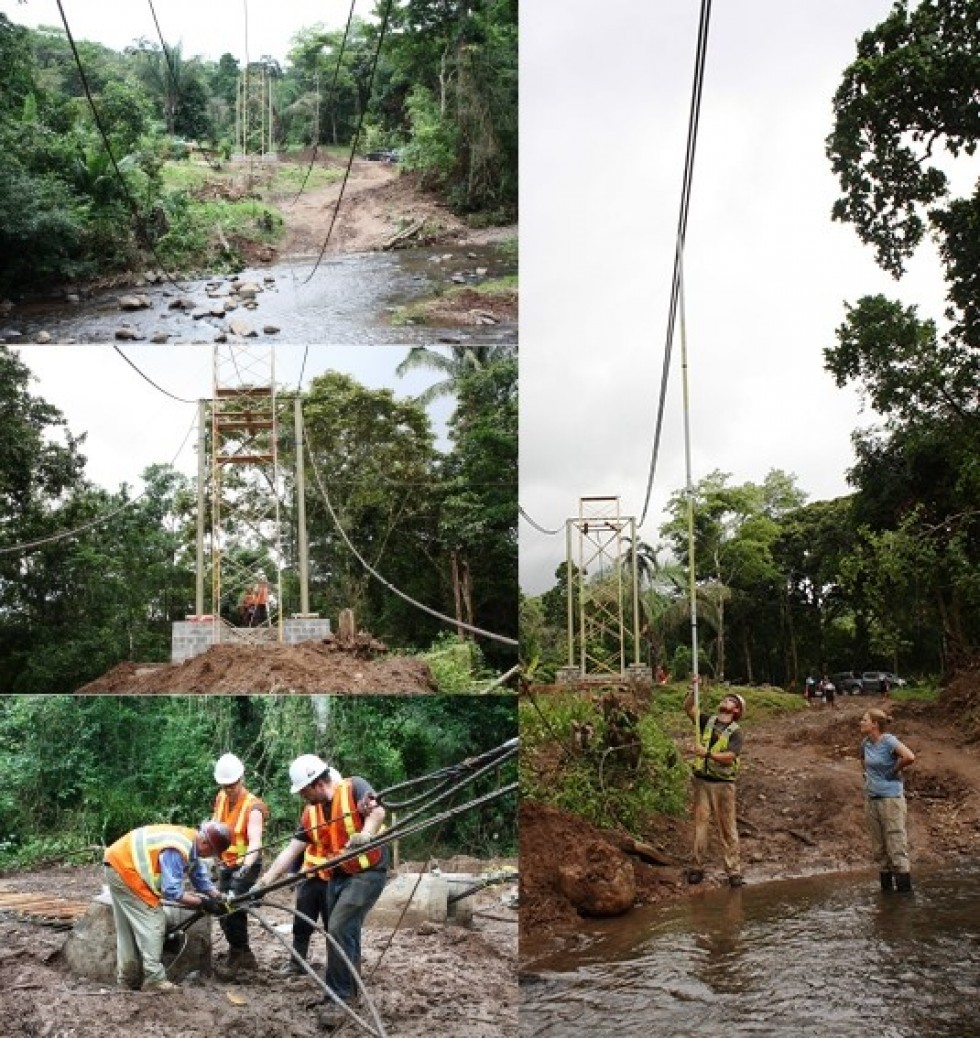
Setting the sag: top left, the four main suspender cables; right, Patrick Haley holds the survey rod up to the cable; middle left, David Pease uses the automatic level to determine the height; bottom left, Wayne Jones, Tobias Petschke, and Mat Reynolds make adjustments to the cable from the anchor
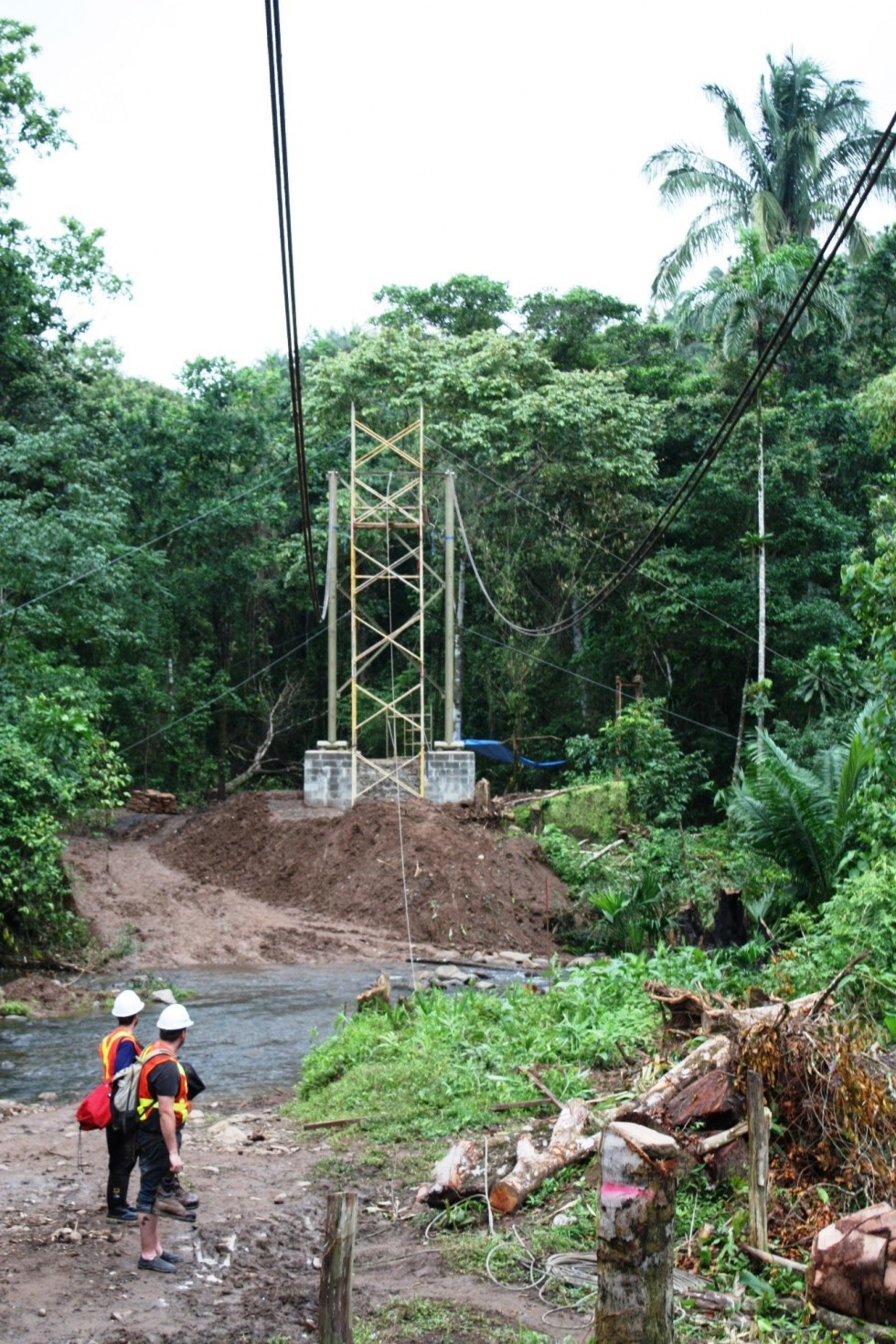
At the end of the day, the sag is near final position, but will likely take several hours of fine tuning before it is complete
Local Tidbit: Ladies Who Lunch
Every morning, a group of ladies arrive on site, start a fire, and begin the process of cooking lunch. The lunches, and our meals in general, consist of rice, potatoes, chicken, beef, plantains, and yucca. Spaghetti is also a common dish.
You may have noticed that the list above is heavy on the carbohydrates and there is a distinct lack of vegetables. The Panamanian diet is definitely proportioned differently than ours. For instance, the first workday, the cooks told us we brought too little meat—they were suggesting that we needed eight pounds of meat for approximately 15 people. (Pro tip: order your chicken from the local villagers and they will kill and cook their own.) And we have to be sure to provide them with vegetables and fruit to prepare; although mangoes grow abundantly, they mostly go uneaten, except by the ants. On top of that, meals are based on a very large portion of multiple carbohydrates—rice and potatoes, rice and yucca, rice and lentils. They even mix rice with the spaghetti. As one of the locals told us, “It’s not a meal unless there’s rice!”
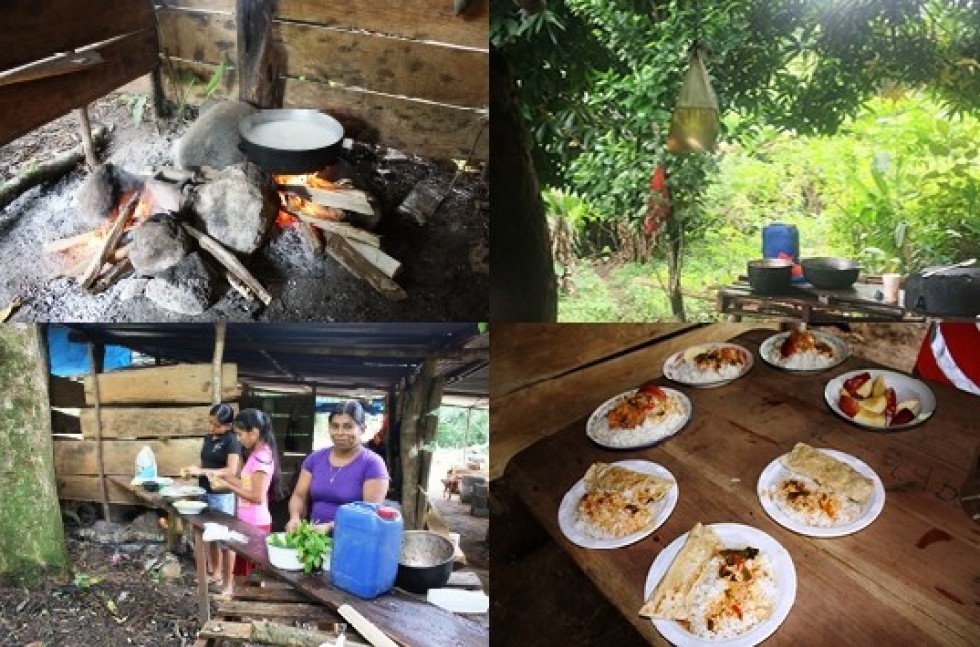
Our site kitchen: top left, the fire’s going. Sometimes the cooks use banana leaves when they need a pot cover; top right, a bag of water is hung daily. When asked what it was for, we were told it was to keep the flies away—when they see their reflection, they get scared and leave bottom left, some of the ladies; bottom right, a typical lunch
July 14, 2016 – Day 4: Tower Tipping Part 2, Suspender Cables, Pajaro Loco
Work Hours: 7:30am – 5:30pm
Weather: Low 80s, intermittent rain, brief midday sun
Peak Local Staff: approximately 10
Jose Ruiz
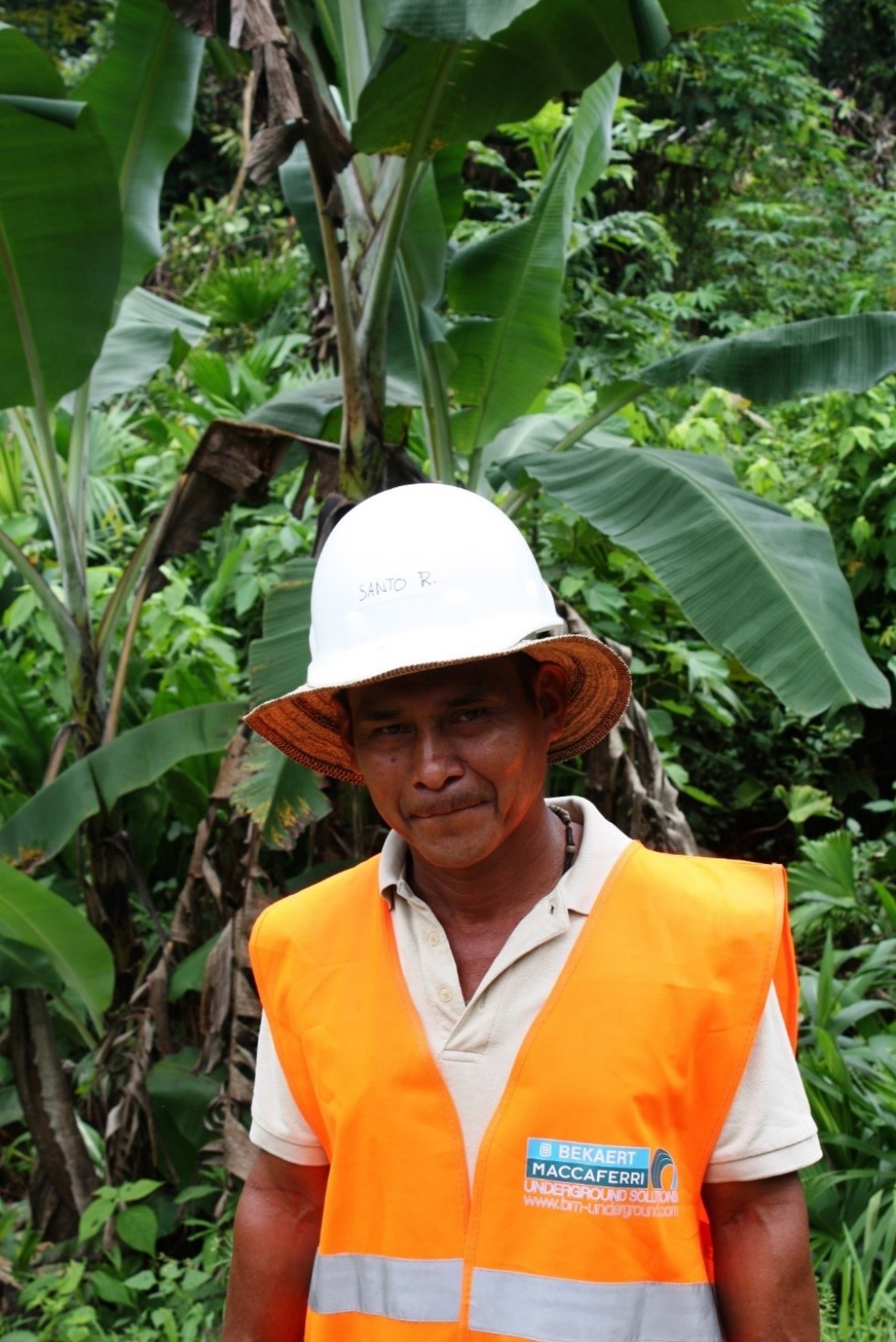
Jose Ruiz is the community’s leader. When he’s not on the bridge site, he works in agriculture growing yucca, plantains, and coffee. He takes these items into Penenome a few days a week to sell them at a market for extra cash. Overall, he lives off of the land and doesn’t need much beyond that.
His farm is about 30 minutes’ walk from site. He lives there with his wife and two of his five children, who all help work the land. He also has a dog named Ben—one of our many site mascots.
Jose is very observant of the weather. For instance, he knew that a recent storm came from downstream of the river, and he mentioned that the river would not rise as high as it would had it come from upstream. When it rains and the river is too high to cross, the locals walk downstream to where the crossing is less wide.
As we approach the close of the first full work week, the team has settled into a routine. We awake every morning around 5am, stumble toward the kitchen for coffee, take turns in the bathrooms, apply copious amounts of sunscreen and bug spray, pack up, and head out. In the evenings, there is an immediate rush on the showers (our smell, individually and collectively, grows more intense every day) and a simultaneous rush on the beer cooler. Every other day or so a group drives the 40 minutes into Penonome for shopping and wifi access; otherwise, the team eats dinner and settles in for an evening of work, cards, and conversation before retiring between 9 and 10pm.
On site, the routine has settled in as well. After unloading gear, the team does stretch and flex and discusses the day’s tasks. At this point the locals begin to arrive, as well as the ladies who cook our lunch. The shop areas are now well established; the wood deck operation is located under cover on one side of the kitchen and the rebar/crossbeam operation on the other, next to the generator and slick with mud. Tobias Petschke translates all of the major instruction to the locals and runs the decking group, while Chris Scollard manages the rebar and crossbeams. General teams have been established on each side of the river; Wayne Jones runs the Right Side operation, Mike Krulc the Left, with David Pease keeping eye on the entire project.
The assembly line for the deck planks and suspenders continued on Thursday. The suspenders were nearly completed and the deck planks are about halfway complete. A strong team of villagers cutting and drilling the deck planks worked efficiently and with a high level of quality.
- On the Left Side, the team spent the morning setting up, tripping, and setting the tower. The same large stump on the right side of the river was used as the anchor for the winch for the second tower tripping.
- On the Right Side, the team focused on setting up and stringing the main suspension cables.
By the end of the day, the first set of suspension cables (there are four total, two on each side of the bridge) were strung through the saddles of both towers. Rather than following the methodology put forth by B2P, which involved carrying the cable across the river and then lifting it up and into the saddles, Wayne Jones had a better plan. The team used a pilot cable to pull the main cables up and over the saddle, which was a more efficient and safer operation. The task was accomplished with significant help from the locals. The cables were set approximately five to six feet above the river to ensure they would not be washed out if the river rose overnight.
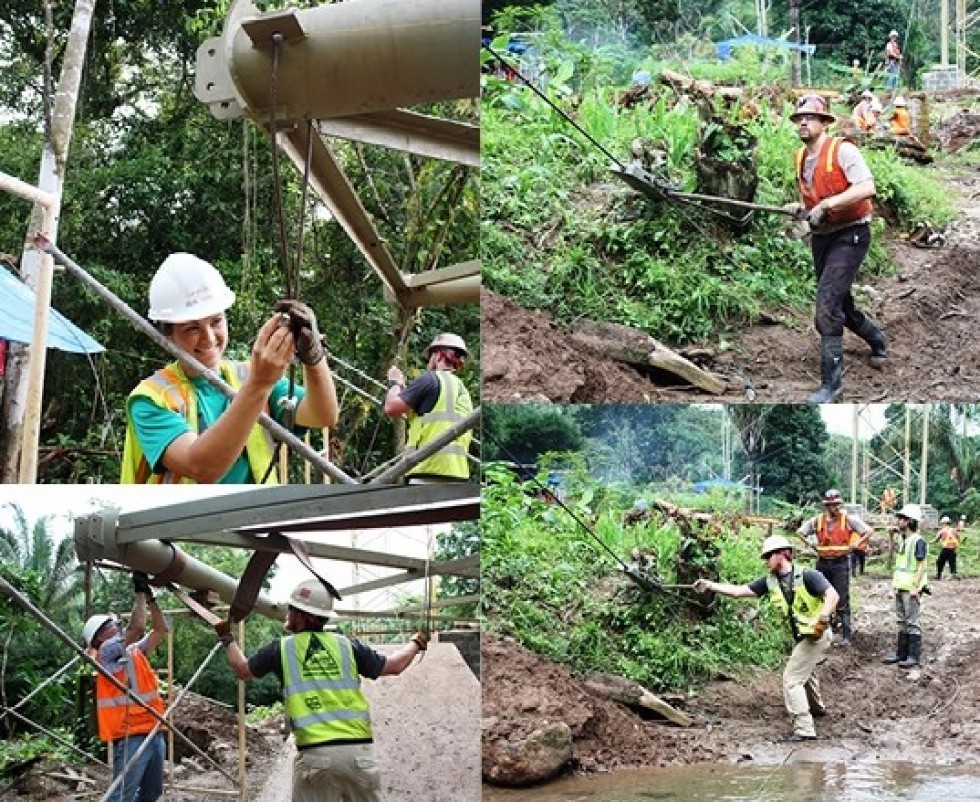
Left Side tower tipping preparation and execution: top left, Christine Idzerda prepping the tie-back cable; bottom left, David Pease and Patrick Haley installing the lifting strap; top and bottom left, Mike Krulc and Patrick Haley work the winch
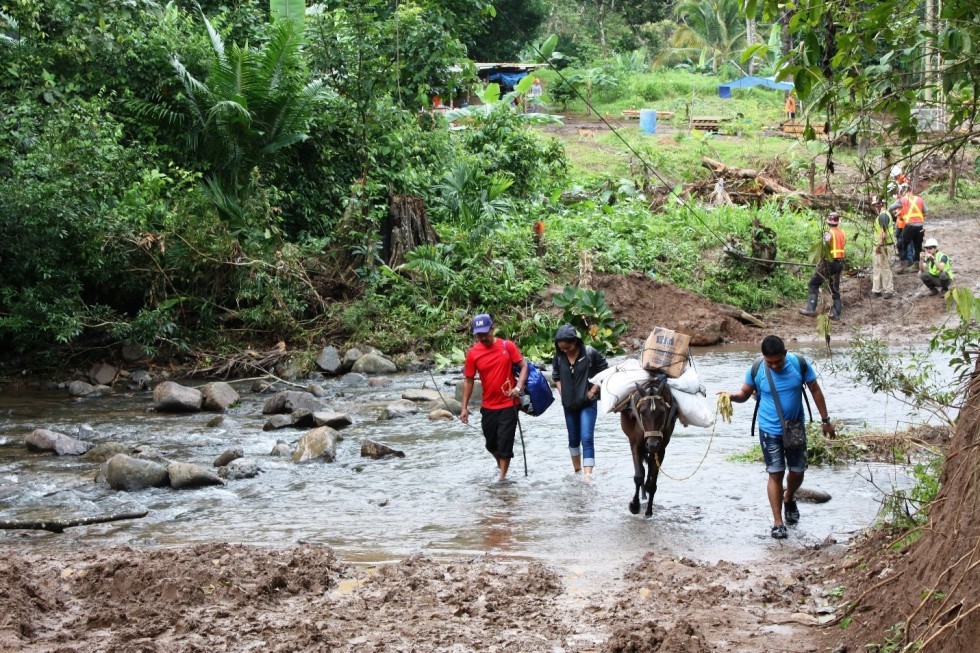
The crossing was busy while the tower was being tripped. The team paused work each time to allow all pedestrians (and horses) to pass through safely
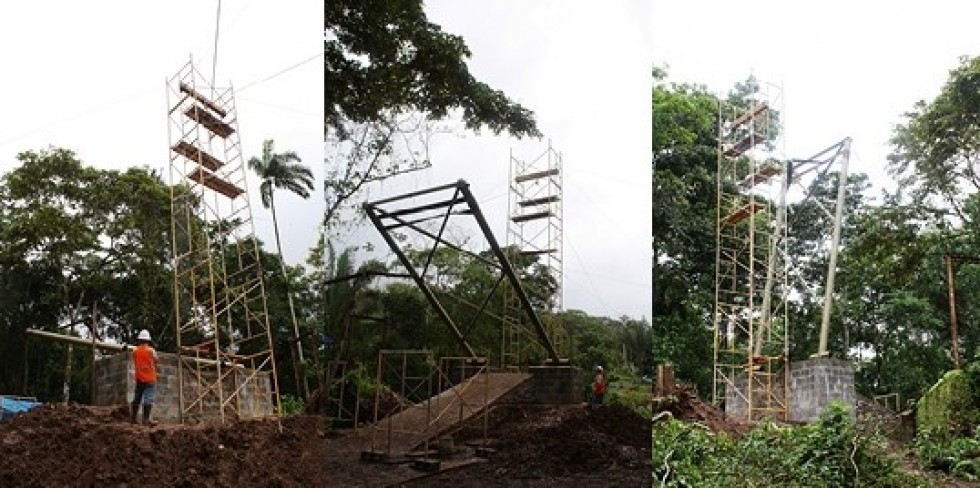
Aaaaaaand…liftoff!
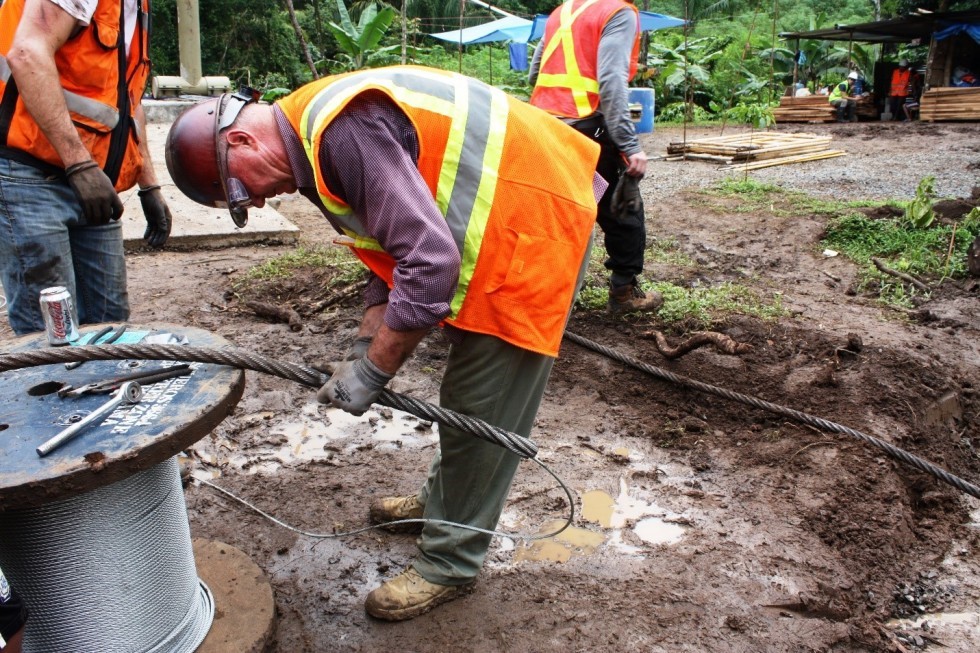
Wayne Jones attaches the pilot cable to the main cable. Utilizing this method increased the efficiency and safety of the process
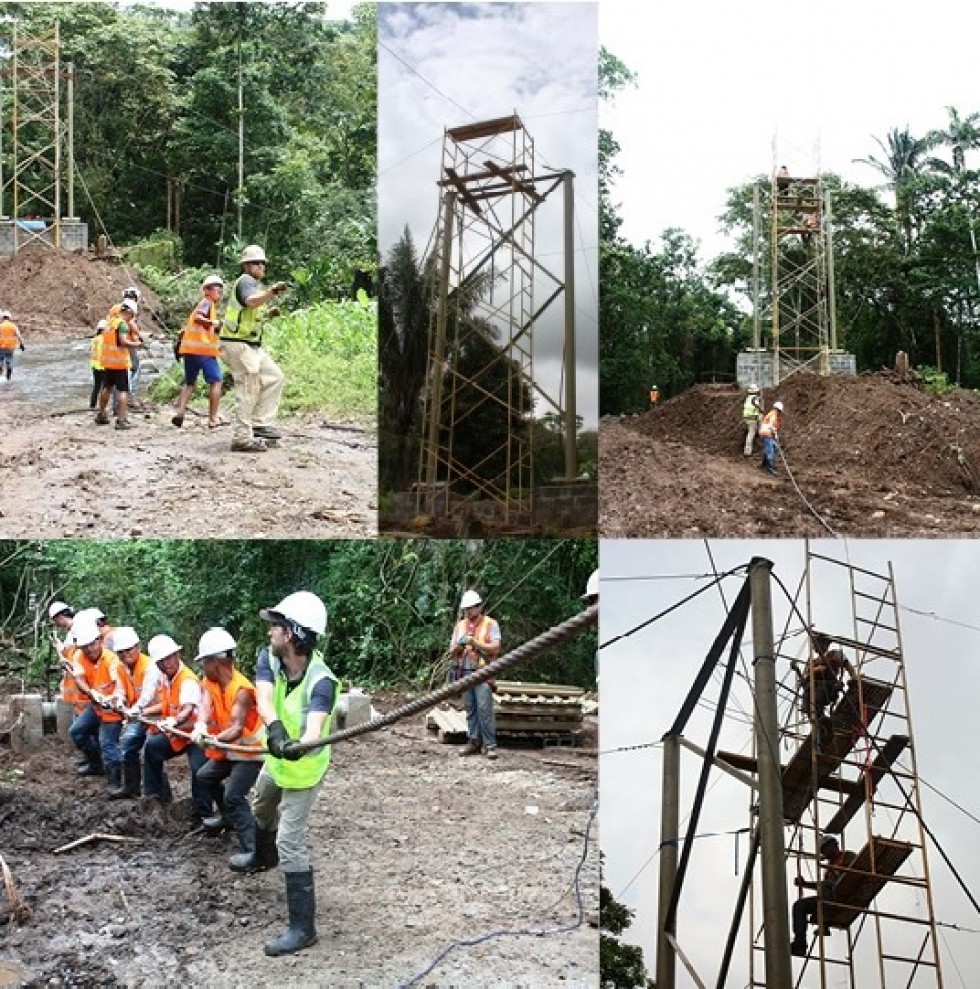
The process of threading the suspension cables: top left, pulling the pilot cable, followed by the main cable, up and over the saddle; top middle, the main cable through the saddle; top right, walking the cable across the river; bottom left and right, repeating the process on the other tower
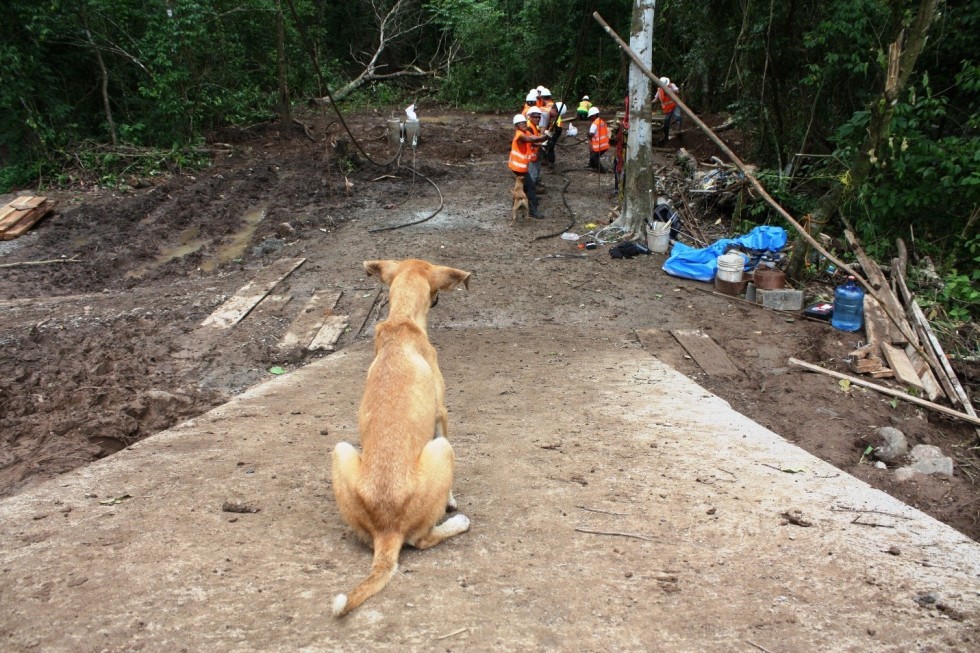
Quality control
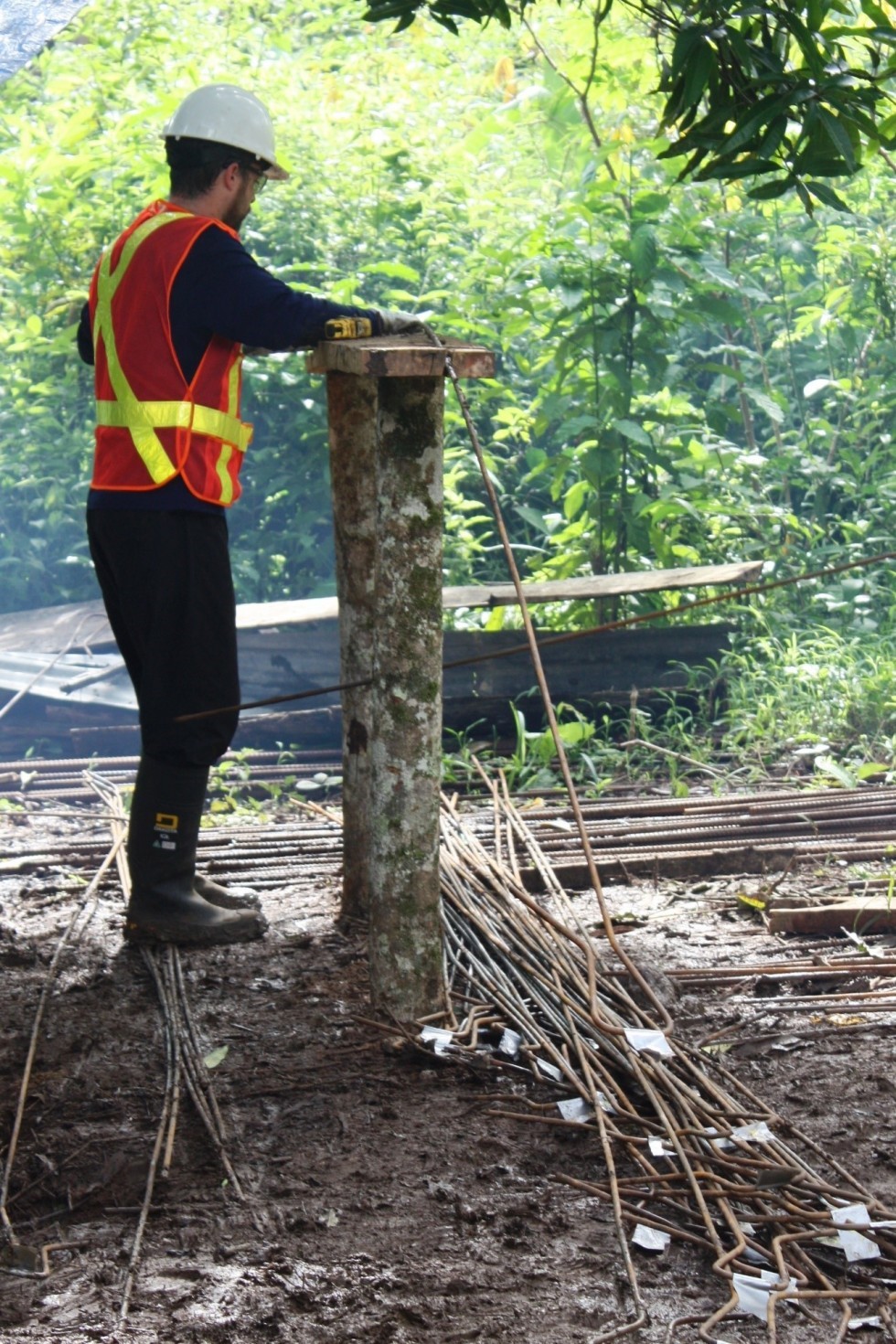
Chris Scollard mans his rebar operation
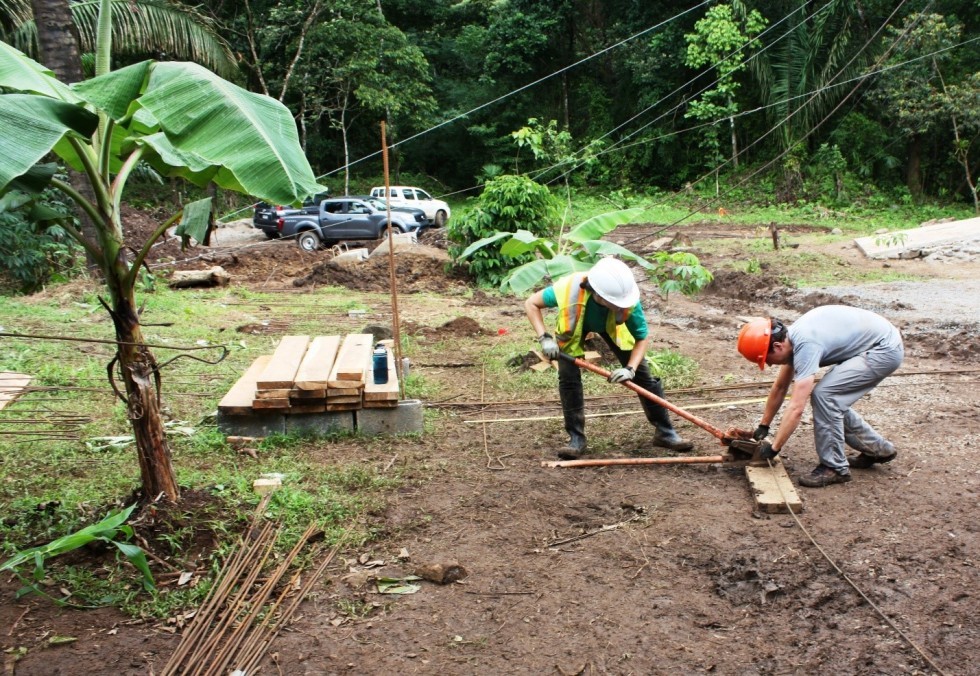
Christine Idzerda cuts rebar to size
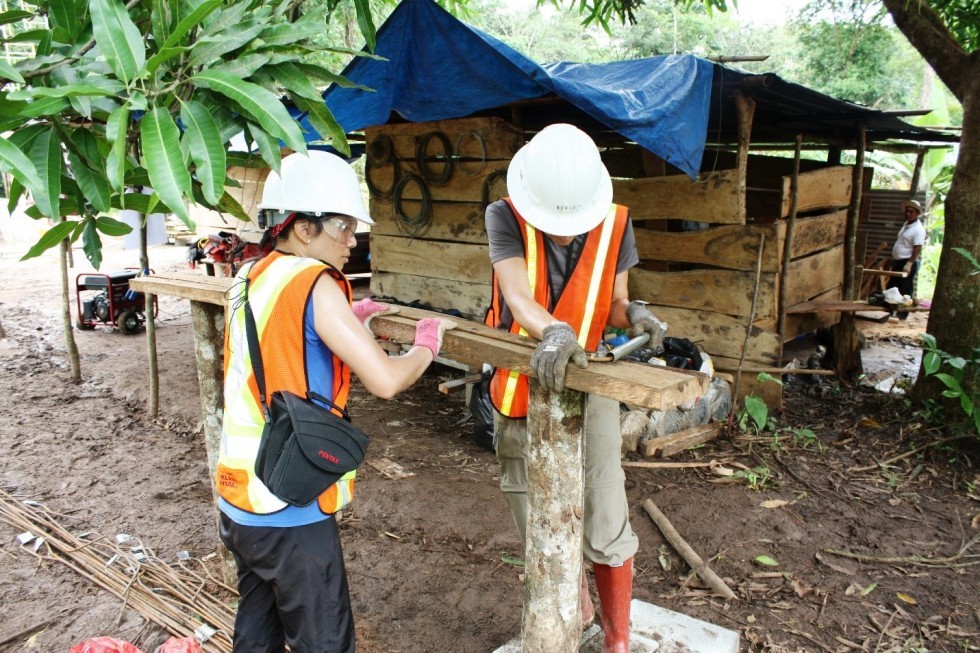
Amanda Wong and Ashlea Scaglione bend the cut rebar to form the suspenders
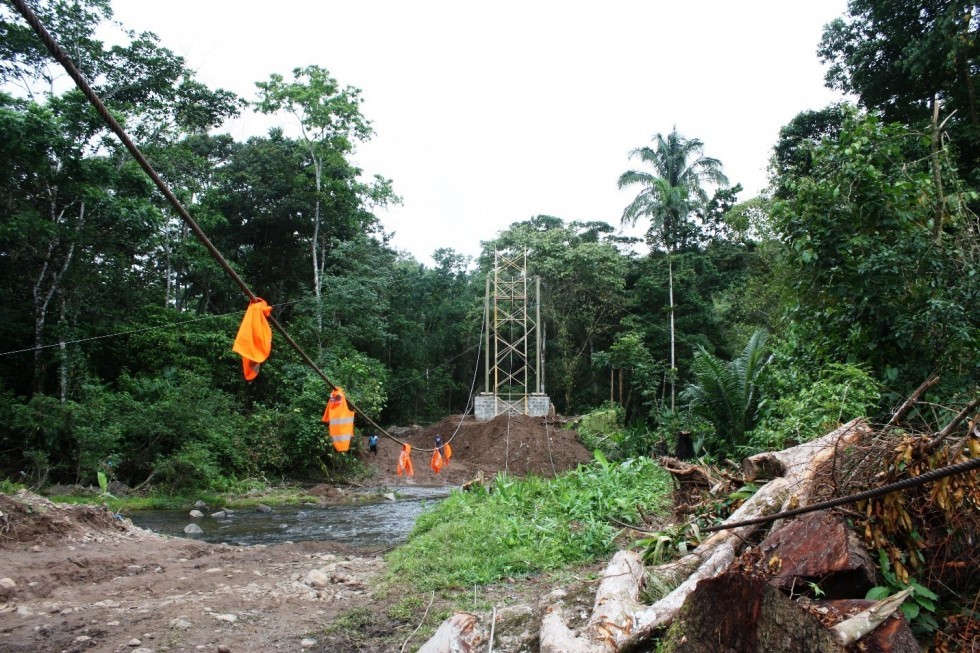
Evidence of a full day of work. The team tied reflective vests to the cable closest to the path to be sure nighttime travelers, especially those on horses, could see the cable
Local Tidbit: Pajaro Loco
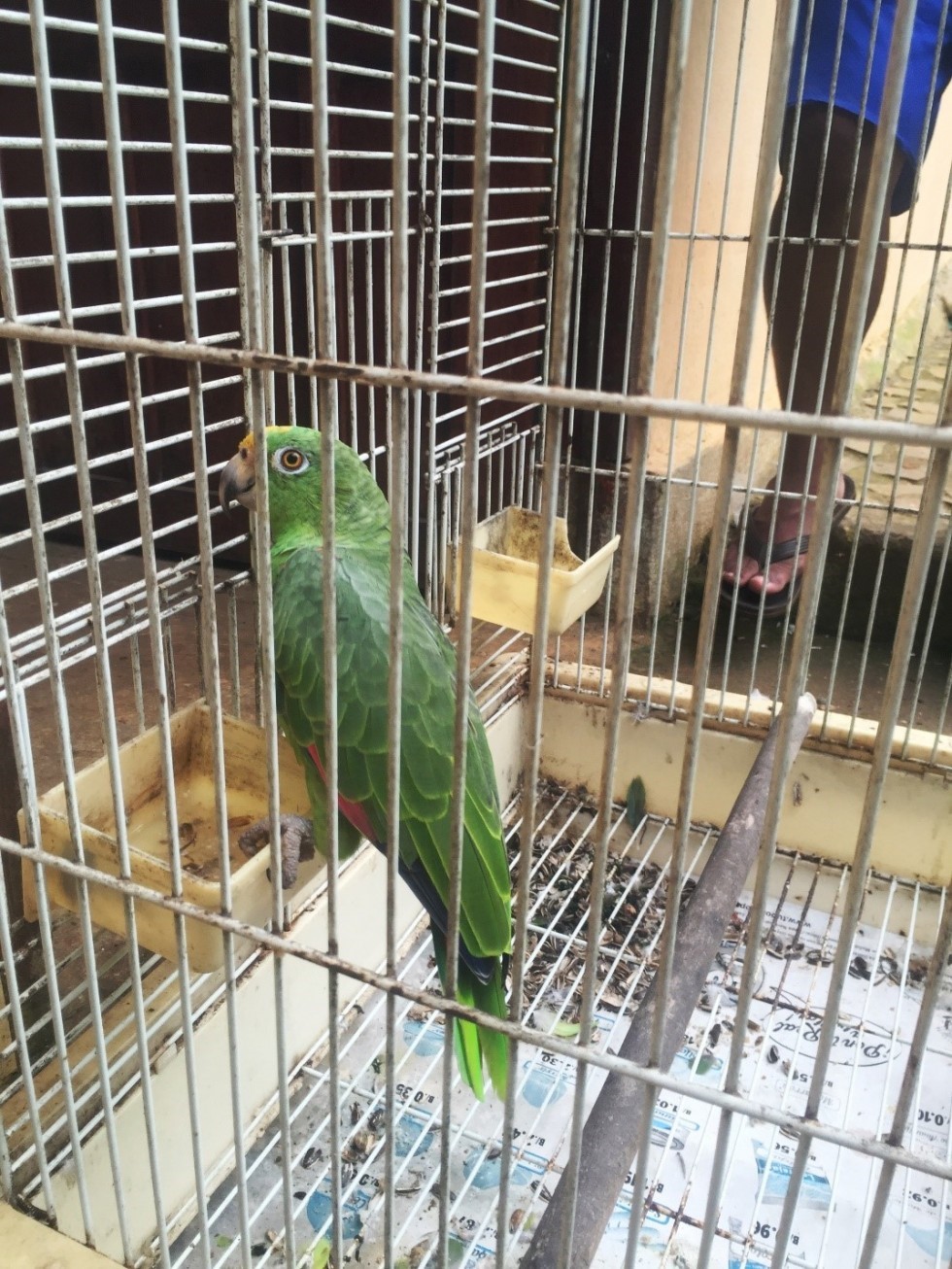
Meet Teto. Teto is a parrot who lives at our hostel in a cage just outside the owners’ home. Teto is a prolific speaker of Spanish. He also catcalls members of our team from time to time, which, let’s be honest, in our current dirty and odiferous states, provides a little boost of self-esteem. Teto also likes to scream loudly. When he does so, it’s the sound of a woman screaming in fear: “Aaaaaaaah! AAAAAAAHHHHH! No! Noooo!” The first time we heard this, we thought someone was actually in trouble. Now we laugh when we hear it, though there’s a nervousness behind it, as we all wonder how and from whom Teto learned this particular…vocal trick
July 13, 2016 – Day 3: Tower Tipping, Ramping up Production, Mango Bombs
Work Hours: 7am – 3pm
Weather: Low 80s, late afternoon rainout
Peak Local Staff: approximately 20
Conversations with the Team
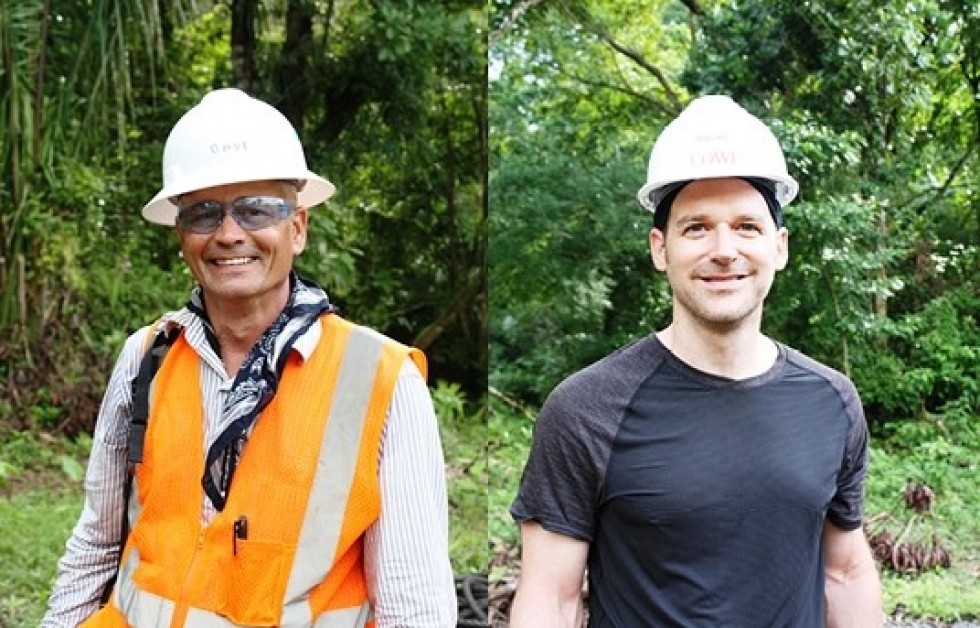
Left, David Pease, Traylor Bros. Project Manager, B2P Construction Manager; Right, Tobias Petchke, COWI Senior Bridge Engineer, B2P Support Team Member
How do you feel the project is going overall?
TP: Very good!
DP: There are lots of little obstacles, but the team is able to solve them as we need to.
TP: And we have full support from the community. They are fully integrated into the work process—and they feed us as well!
What challenges do you anticipate moving forward?
DP: The set and sag [of the suspension cable]. It will just take some patience. Each step is going to have challenges we haven’t thought of, but nothing we can’t overcome.
TP: We may be running out of deck planks, but I already have spoken to Jose [the informal community leader] and he has a tree trunk that can be cut if needed.
What is the most interesting thing you’ve encountered so far?
DP: The sloth!
TP: I like to see how the locals get involved—for instance, when Eliuterio was drilling the deck boards with us and he looked up smiling—it was nice to see that he clearly felt that he achieved something.
DP: Also, it’s been great to see how well we can communicate even when Tobias [our only fluent Spanish speaker] isn’t around, through gestures, drawings, and a few words.
TP: It’s because both sides are making an effort to communicate. No doubt, the locals are a great help.
The main focus of the day was tripping (raising) the Right Side towers. A surprisingly small team used a winch and pulley system to slowly raise the legs, inch by inch. Two men took turns working the winch, and after about 25 minutes of backbreaking work, the tower was vertical.
- Also on the Right Side, restraint cables to stabilize the towers were set.
- On the Left Side, tower legs were placed in the base hinges and the cross bracing was assembled. The snatch block, through which the hoist cable is threaded, was set up in the scaffolding in preparation for tripping of the tower.
The Left Side team ran into a few challenges that were overcome with quick, ingenious thinking. When the downstream tower leg was placed, it became clear that the stability of the scaffolding was less than expected. In order to increase the stability, the team took action. They quickly assembled a V-brace from two deck planks spaced at the bottom by a cinder block and tied together with rope at the top and bottom to temporarily support the tower leg, and briefly lifted the tower leg off the scaffolding. With the tower leg elevated mere inches, the team quickly shifted and further stabilized the scaffolding. They then removed the temporary V-brace and set the tower leg back on the bolstered scaffolding. Because of the adjustment, the team then built a hinge from wood blocks and sandwiched it around the horizontal frame of the scaffolding, bringing the adjusted tower legs to a level position, allowing the team to safely move forward with the next task of assembling the cross bracing.
Production work also continued for the deck suspenders and planks. The focus for cutting and drilling the deck planks has been to develop a methodology to assure quality, as the deck planks are irregular in shape lengthwise. The team settled on setting the angle against both longitudinal faces of the plank and then, if they didn’t appear the same, using best judgement to draw the more perpendicular line for the volunteers to cut.
Another team continued bending and cutting rebar for the suspenders. The methodology has now been determined for how best to bend the bars on both ends and to the correct length. With different workers joining us all the time, new people need to be trained each day, which causes the operation to take a little longer than planned; however, all production work is on schedule.
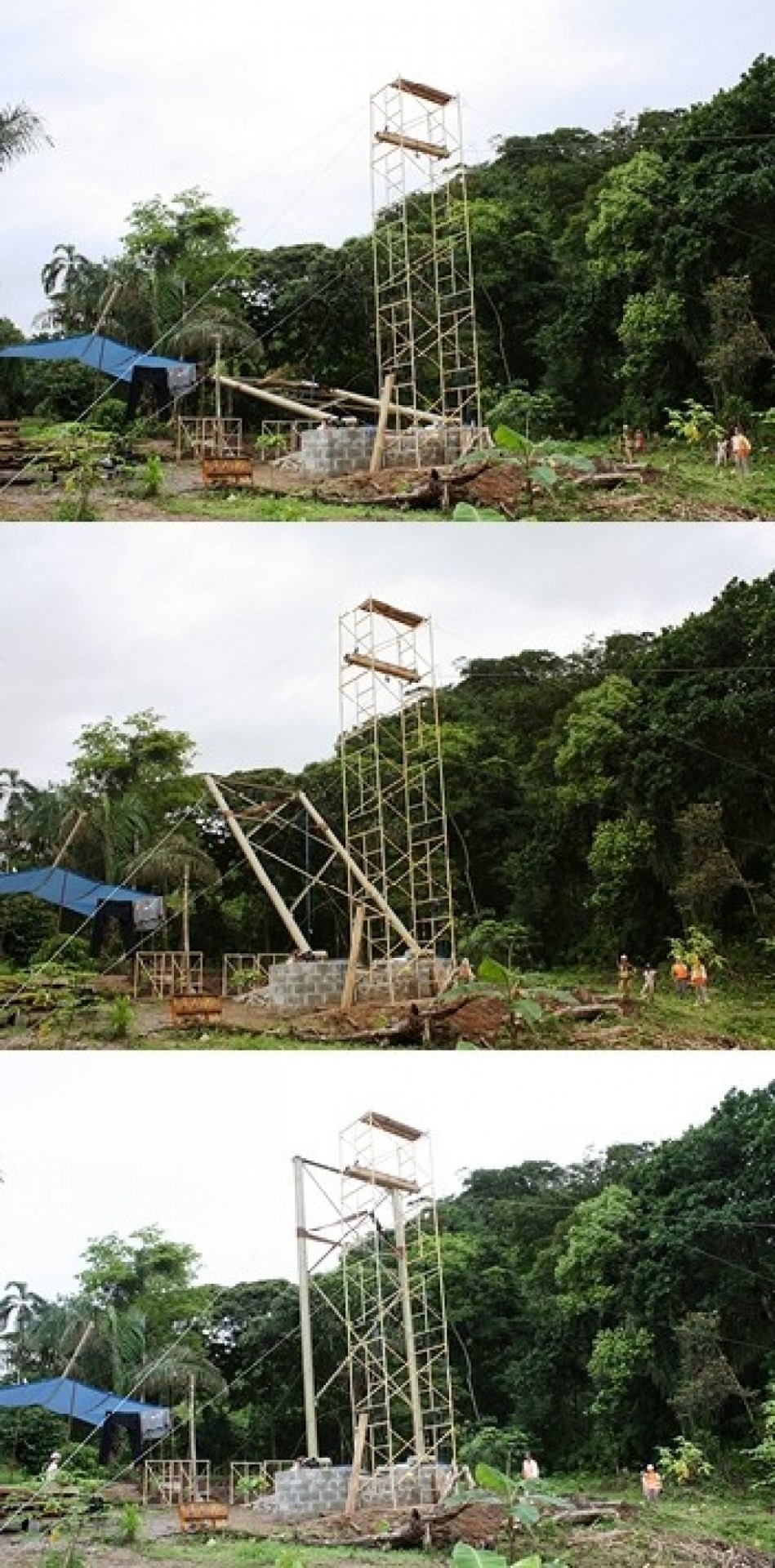
The Right Side tower ascends
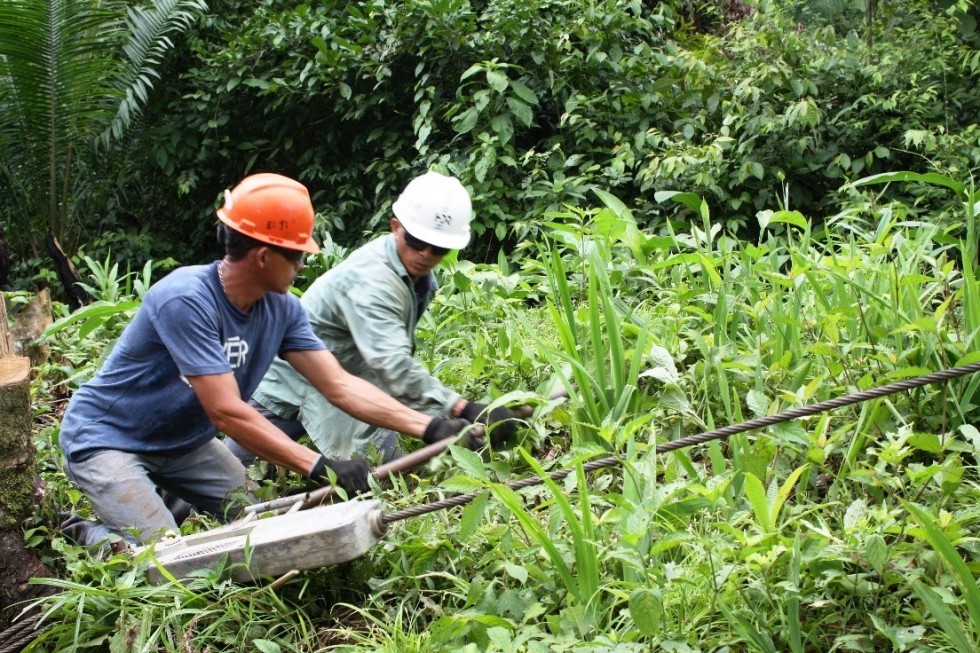
David and Chone, the project’s two masons, winch up the tower
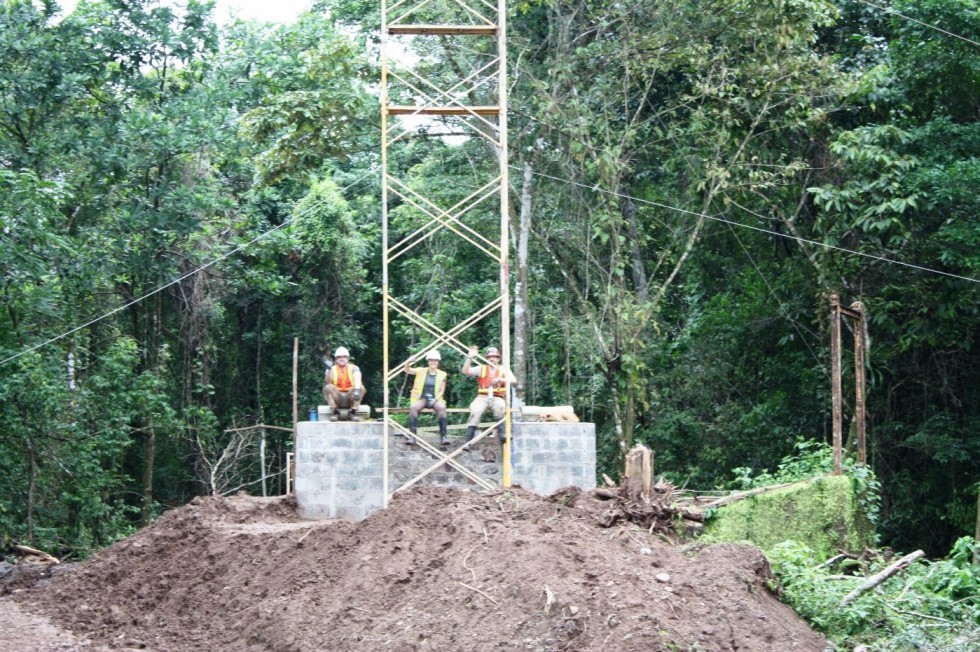
Mat Reynolds, Christine Idzerda, and Mike Krulc observe the Right Side tripping before setting towers on the Left Side
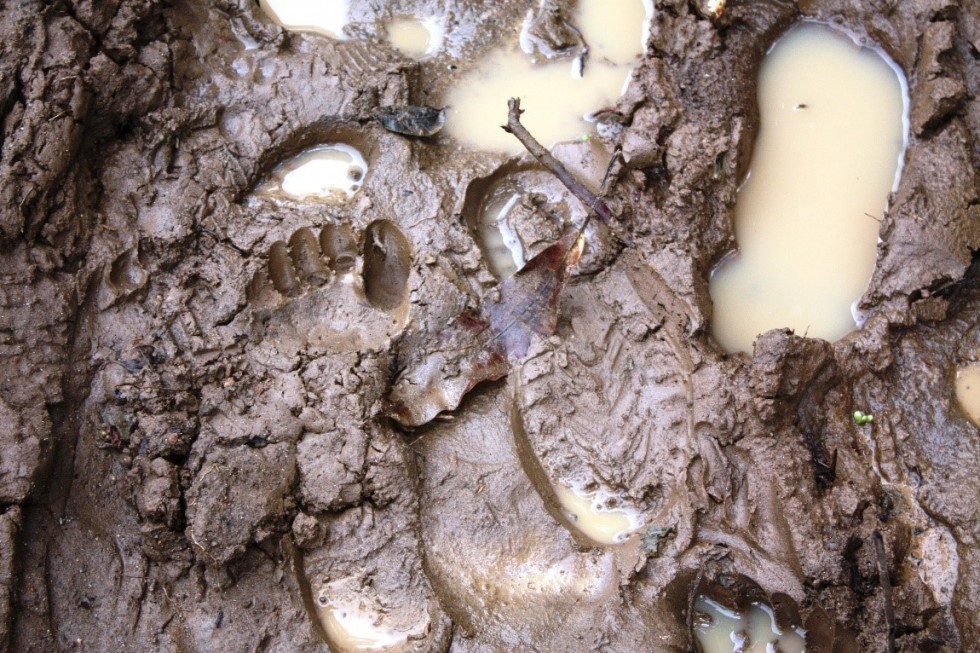
Footprints and boot prints at the river crossing
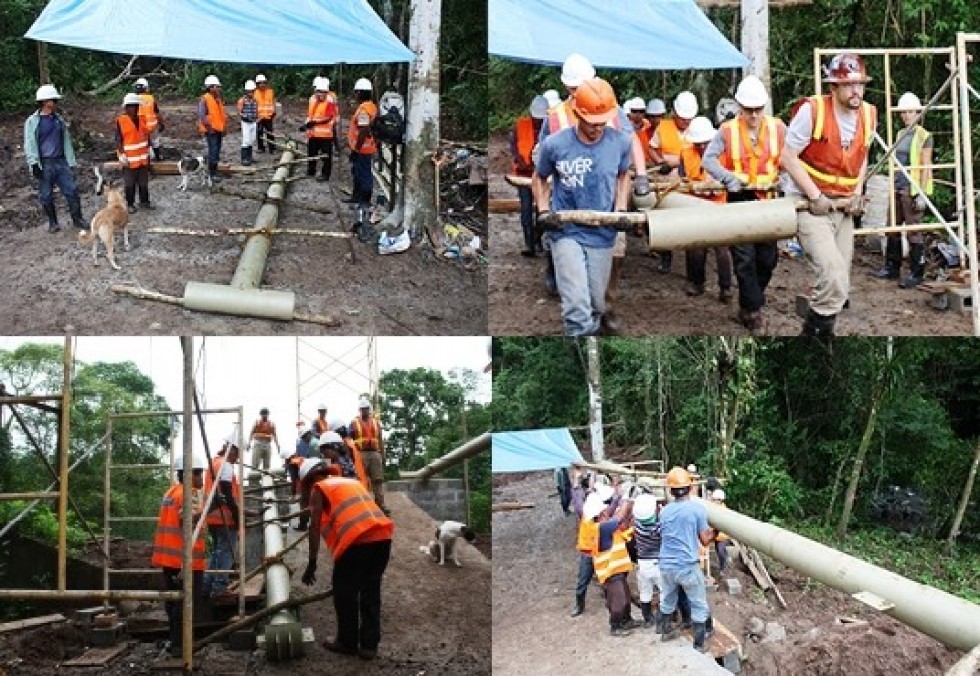
Left Side tower placement: top left, large tree branches were utilized as handles; top right, carrying the leg up the pedestal ramp; bottom left, a brief rest; bottom right, placing the tower leg on the scaffolding
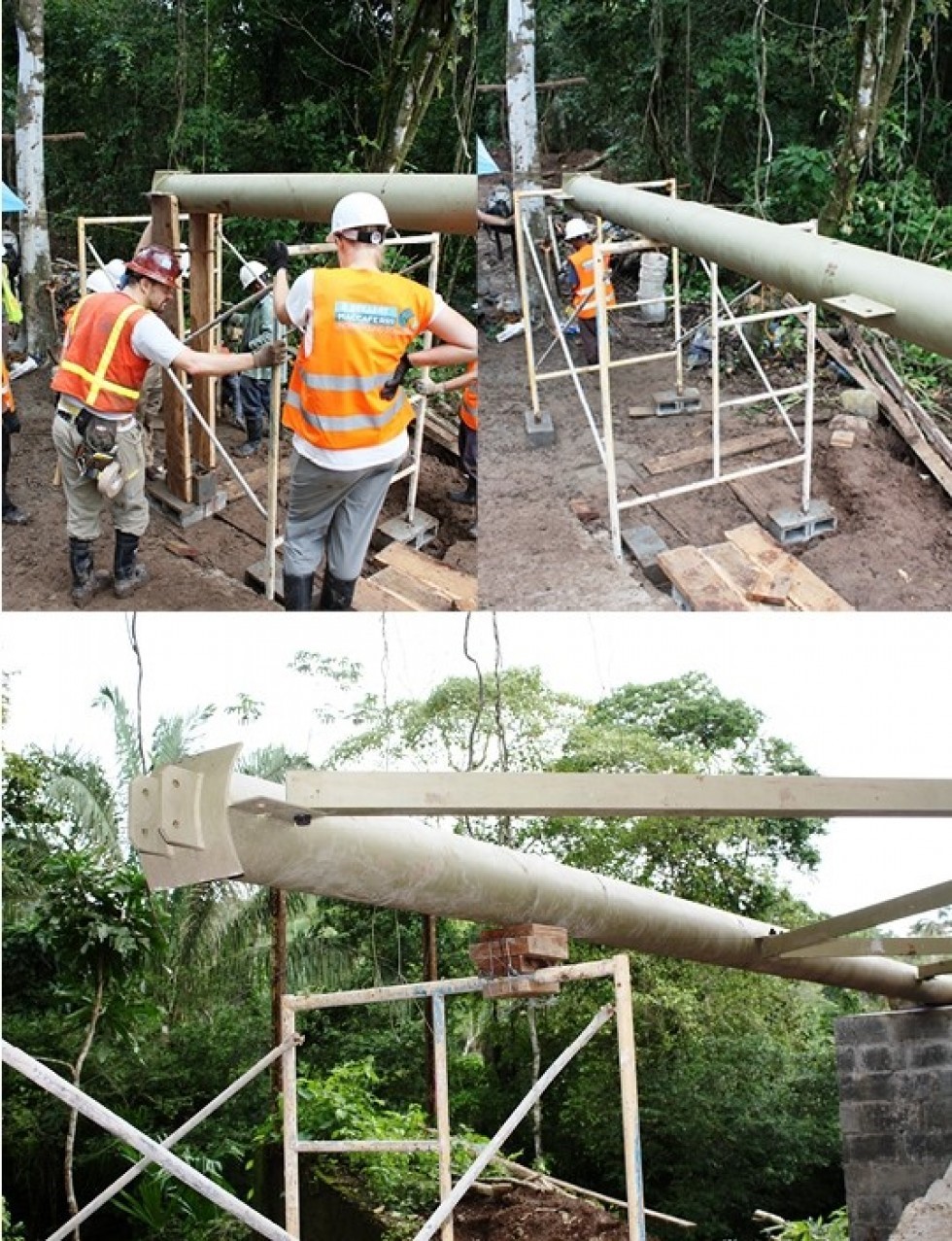
Shoring up tower leg scaffolding: top left, contemplating next steps after setting up the temporary V-brace; top right, successful shored up tower leg placement; bottom, the hinge that brought the tower back to level
Local Tidbit: Mango Bombs
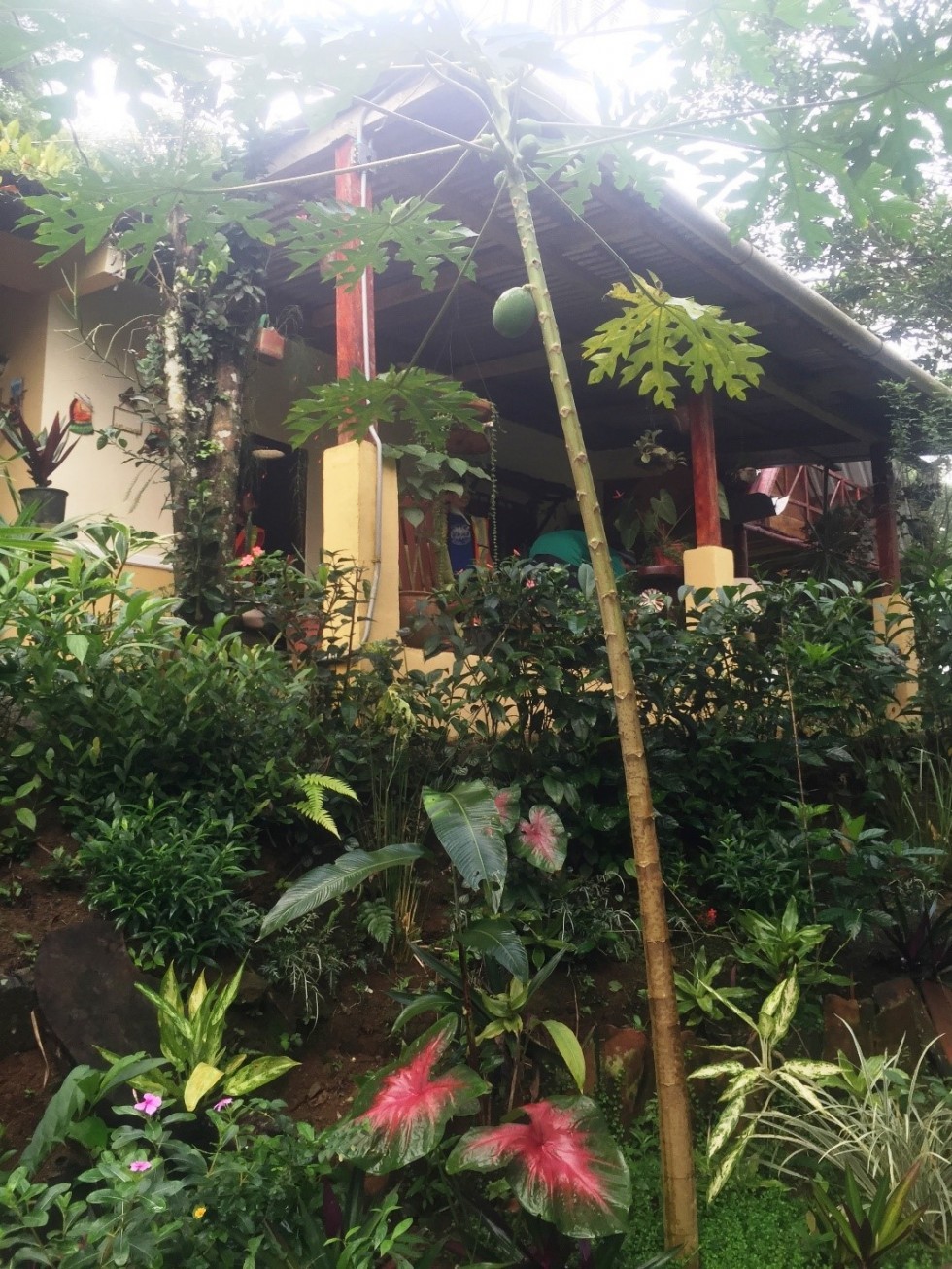
See those mangos up in the tree? They look perfectly innocent, right? Delicious, even? Wrong. Imagine sitting beneath the tin roof of the dining area, enjoying a beer and a game of cards with your colleagues, and—BANG!—mango hits the roof, and so do all of you, because it sounds like a bomb going off.
July 12, 2016 – Day 2: Rain, Mud, Sloth!
Work Hours: 7:30am – 5pm
Weather: Morning rain, low 80s
Peak Local Staff: approximately 20
The team was awoken at 5am by heavy rain and lightning, half hoping to be able to sleep in. However, the rain lightened up in the next hour, and we spotted a sloth in the tree just outside our dining area, spurring us to work. (Certainly he was not going anywhere soon.) The rain continued for the first hour of work but didn’t prevent us from making progress. We set up work stations under our main camp cover and spent the majority of the morning cutting, predrilling, and bolting wood planks to the steel crossbeams.
The other major preparatory activity was bending one end of the rebar for the stringers. This was accomplished through creating a pattern of bolts in a plank of wood that served as a template through which the rebar is threaded and bent.
- On the Right Side, the two masons from B2P, “El Tigre” and “El Zorro,” climbed to the top of the scaffolding to set up the snatch block that will be used to erect the towers. The lifting cable was led through the snatch block in preparation for tripping the tower.
- On the Left Side, the final set of scaffolding and four guy wires were set. Because there was not a suitable tie off location for one of the guy wires, the team decided to string that one in particular to a tree all the way on the opposite side of the river. In addition, the site on the left side of the river is extremely muddy and far less compacted than the right, so the team carried dirt and sand from the right side of the river—bucket by bucket—to create a more stable walkway before placing the tower legs.
Stay tuned for the next days’ entries—as of Wednesday, Tower #1 is up!
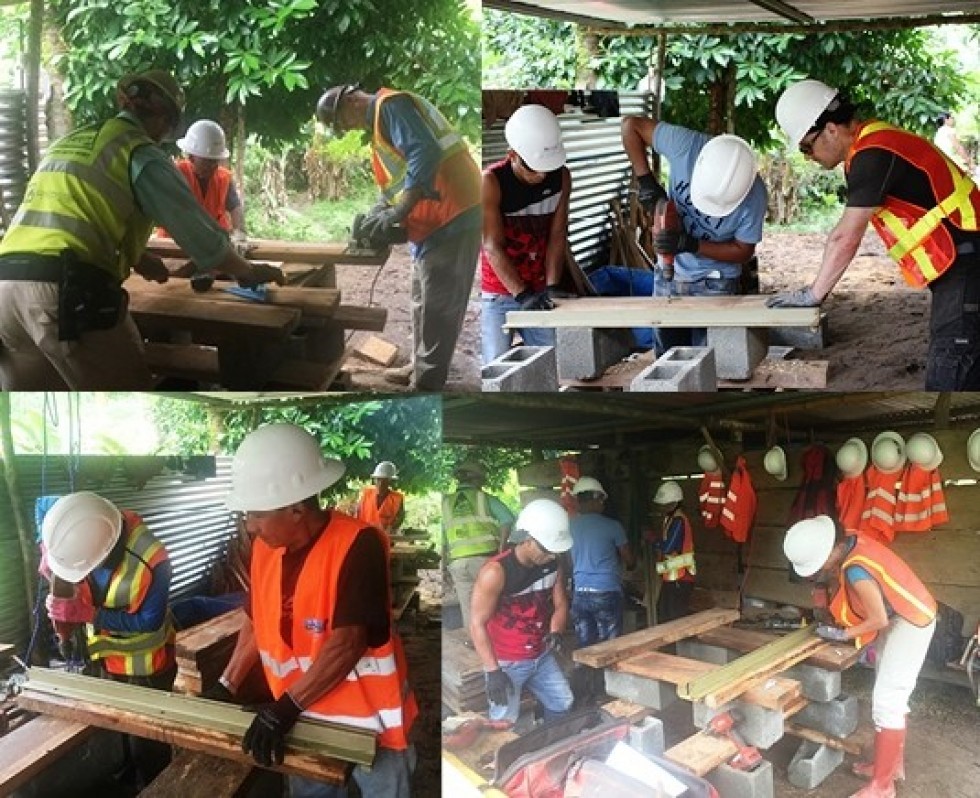
Assembling the crossbeams: top left, Wayne Jones, Patrick Haley , and a volunteer cut the wood planks to size and mark them for pre-drilling; top right, Tobias Petchke instructs volunteers; bottom left, Amanda Wong pre-drills a plank through the steel crossbeam; bottom right, Ashlea Scaglione bolts the crossbeam to a cut and pre-drilled board
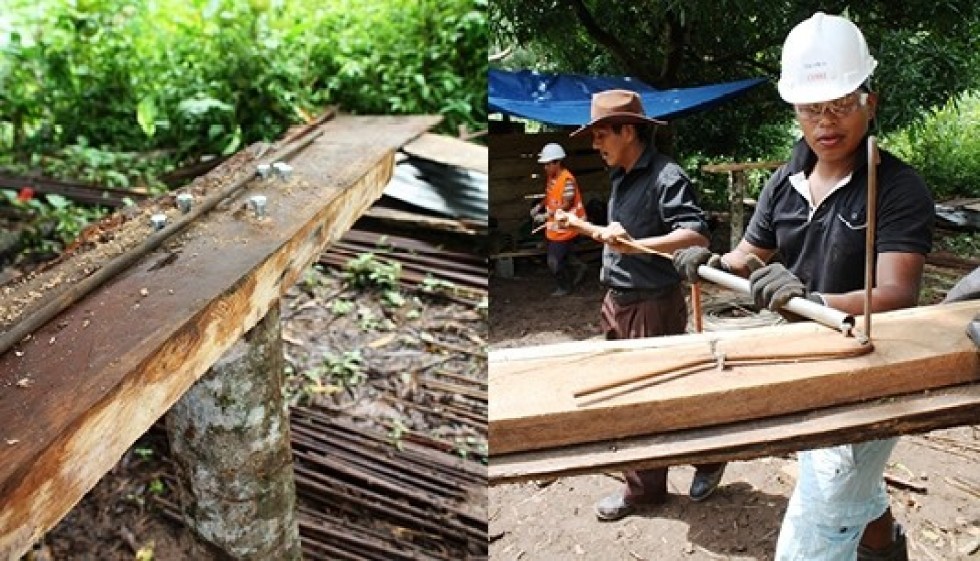
Rebar template and bending
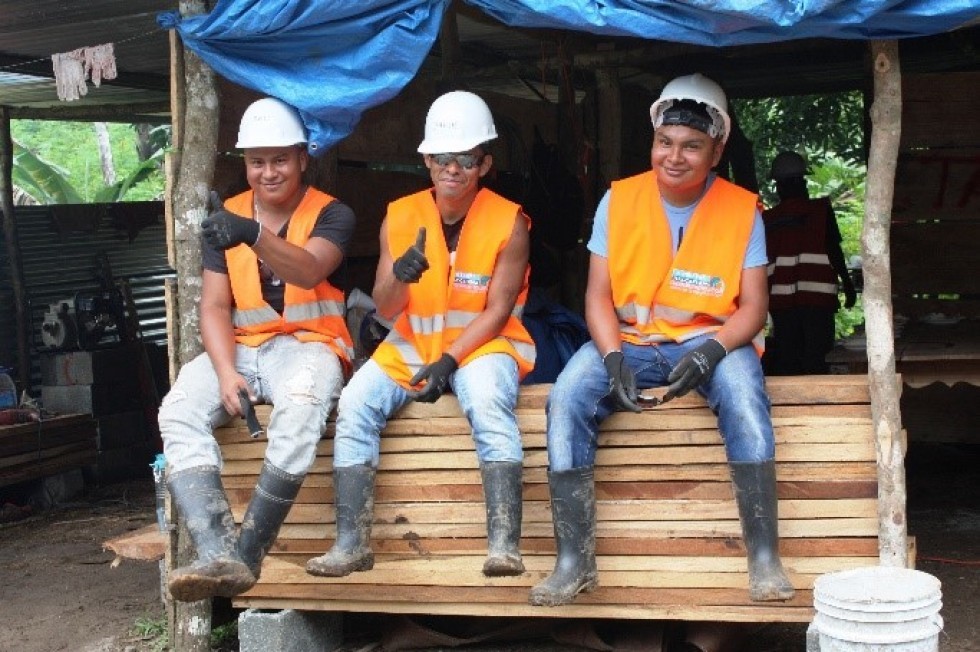
Volunteers await their next assignment
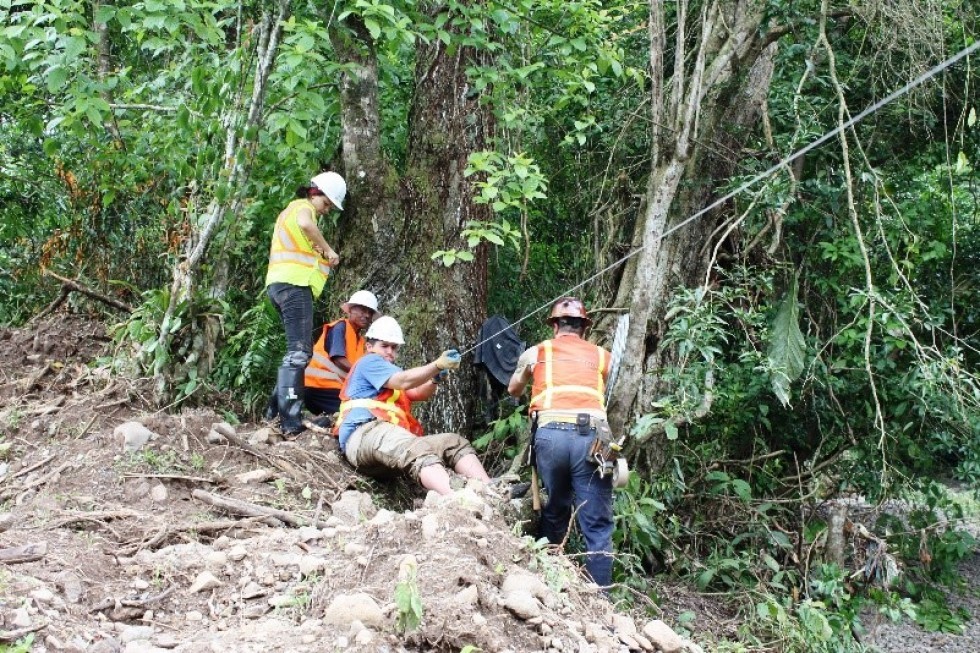
Securing guy wire for the Left Side scaffolding on the other side of the river
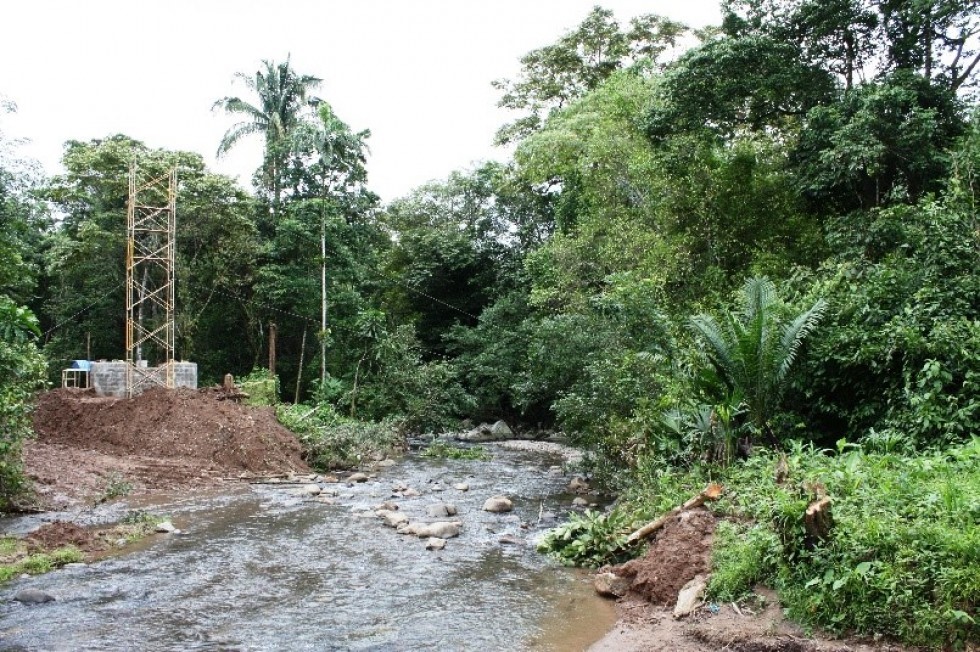
The Left Side with all scaffolding and guy wire, ready for tower setting
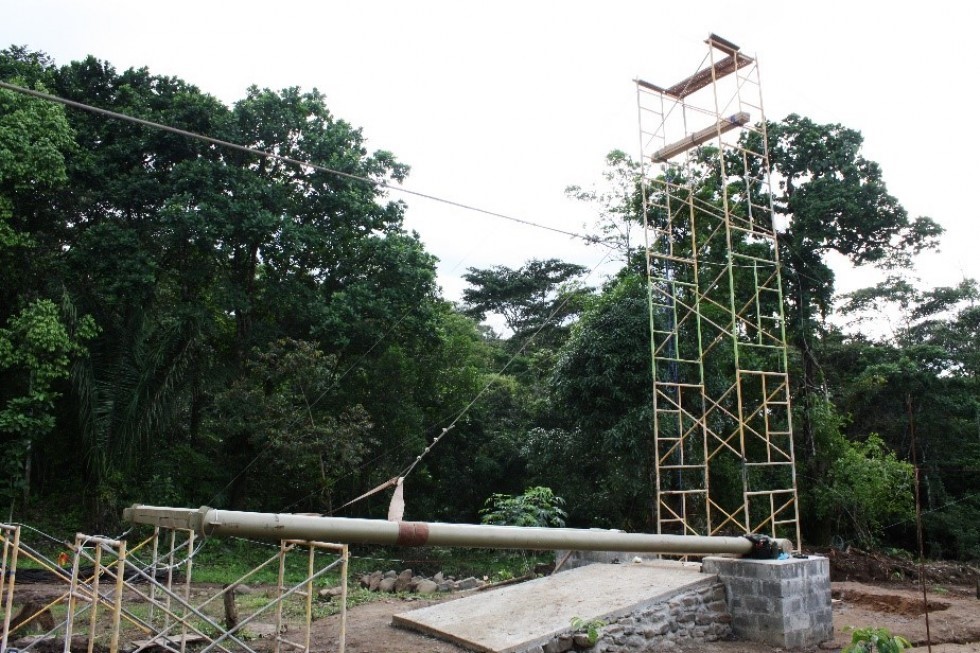
The Right Side, prepared for tower tipping
Local Tidbit

Although these appear to be dress shoes, they are made of plastic. These types of shoes, ladies’ flats made of plastic, and Crocs are all very popular. When you must cross a river several times a day, and conditions are frequently muddy, plastic shoes are the way to go
July 11, 2016 – Day 1: Mascots, La Vieja, and Lots of Hands
Work Hours: 7am – 5pm
Weather: Mid-80s, overcast, and surprisingly, no rain!
Peak Local Staff: approx. 20
The day began with our first team stretch and flex and safety briefing. As villagers trickled in, everyone was given safety vests, hard hats, and gloves. There was a visible uplift in the way the villagers carried themselves with the addition of the gear.
The project is divided into the ‘Right Side’ (Chiguiri Arriba central side) and the ‘Left Side’ (the side of the sub-community of La Vieja). Significant progress was made on both sites.
- On the Right Side, all scaffolding was assembled and tied down with eight guy wires. Both tower legs were placed in the hinges and the assembly of the cross braces neared completion.
- On the Left Side, five of the six sets of scaffolding were assembled and tied down with four of the eight guy wires.
- Considerable amounts of sand needed to be placed under the timber planks that were used for leveling the scaffolding due to settlement.
- Wood for the deck planks was transported to the site and work to cut and drill the boards began.
- There were no pins to connect the vertical frames of the scaffolding, so we used tie wire to connect them.
Best of all, we had an excellent turnout from the villagers. Locals were trickling in throughout the day, and by the end of the afternoon there were approximately 20 villagers helping to place the tower legs, in addition to the five who cooked and served us lunch.
And, we have mascots! Anywhere from three to five dogs have joined us on site, in addition to one vociferous rooster, who struts around the site chasing crickets for lunch, crowing, and burrowing in the dirt like the dogs. I’m sure we’ll be seeing them daily.
A Walk to La Vieja
In addition to the work, a small group hiked to the village of La Vieja to see the land and say hello to more of the villagers. The bridge is needed because this is the only crossing that is unavoidable; the other four crossings between Chiguiri Arriba, where the schools, medical care, shops, and work are located, can be circumvented. In fact, we noticed the crossing was consistently busy for much of the day.
We chose to take the short route of approximately a half mile (versus avoiding the other crossings, which amounts to approximately a mile), crossing the river at all five points, and abandoning all efforts of keeping dry as one of us slipped on a rock and soaked ourselves to the knees, while the height of the water rose and plunged over the top of another’s knee-height neoprene boots. Refreshing, but squishy, and no chance of them drying in the time we’re here.
The path rose upward, through the crossings, past a small waterfall, and meandered by expansive properties with concrete walls and thatched or tin roofs, well-tended lawns, tropical gardens, and colorful chickens of the sort we would call ‘free range.’ The properties are large and widespread because the majority of the villagers farm produce such as yucca, plantains, and potatoes for subsistence. Very few have jobs; most participate within the community and take small stipends from the government (for grandparents and women), and occasionally sell items or perform a service for extra money. The pace is slow, and judging by the wide smiles, cheerful greetings, and easygoing gaits of those we encountered along the way, the villagers are for the most part content.
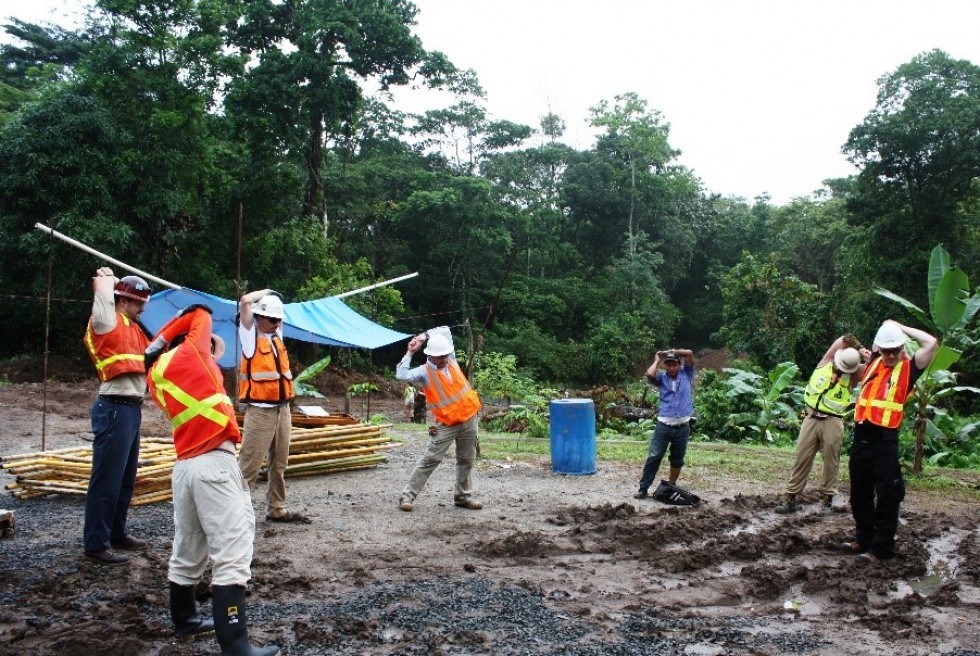
Day 1 stretch and flex
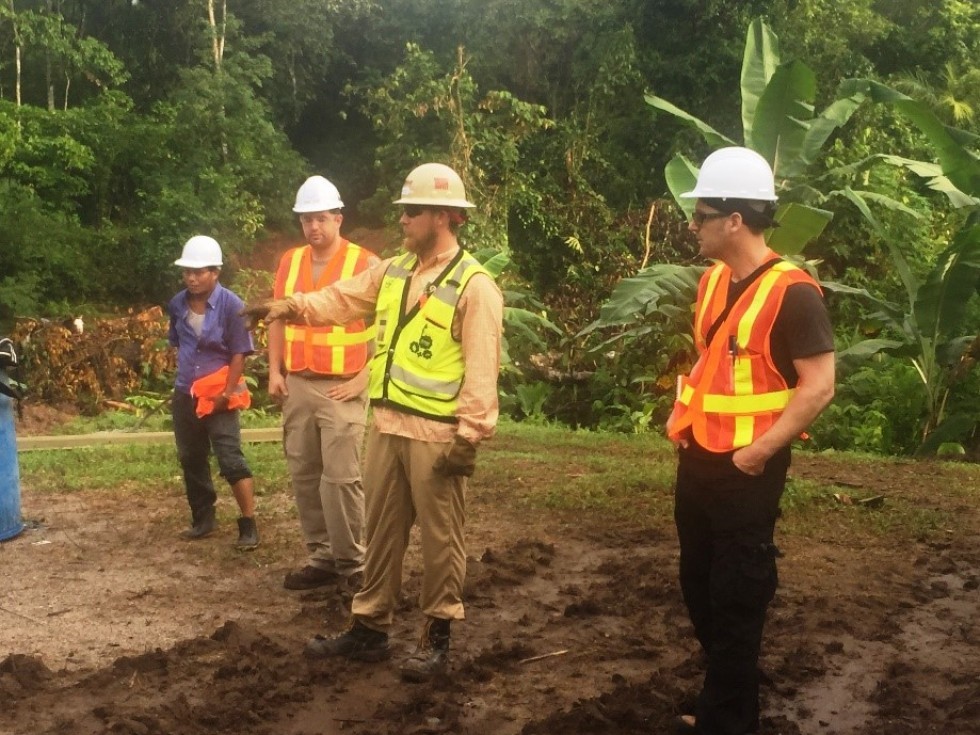
Safety Manager Patrick Haley gives the project’s first safety briefing
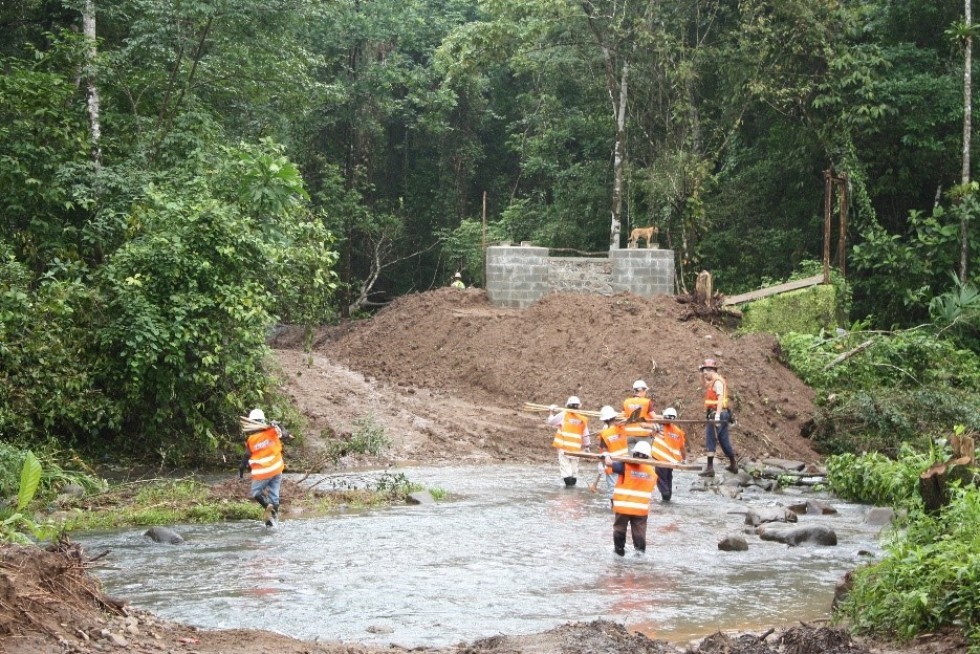
Villagers carry materials across the river to the Left Side
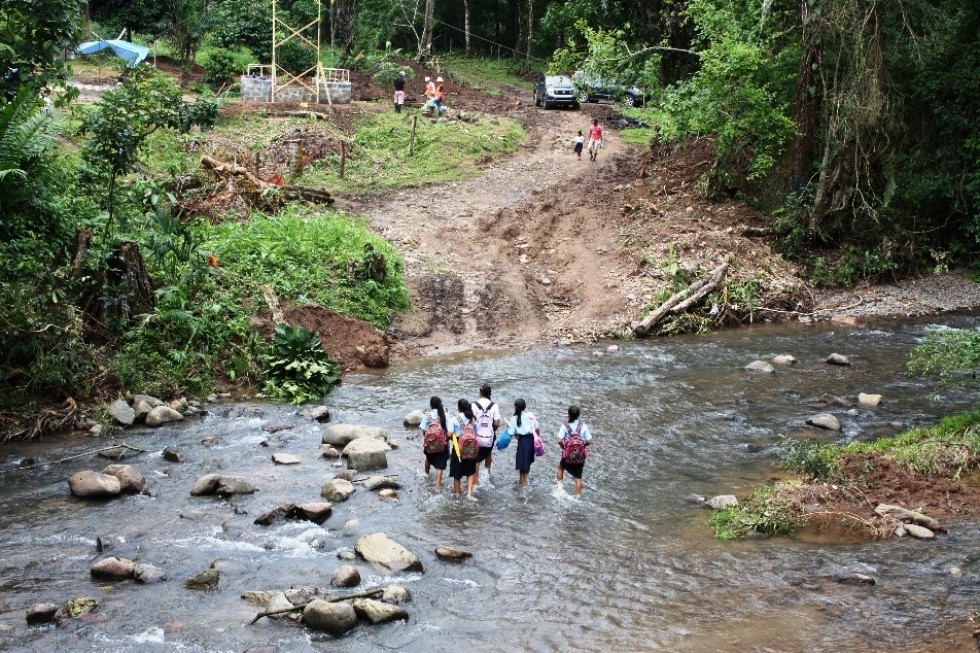
The need for this bridge is apparent after only a few hours on site
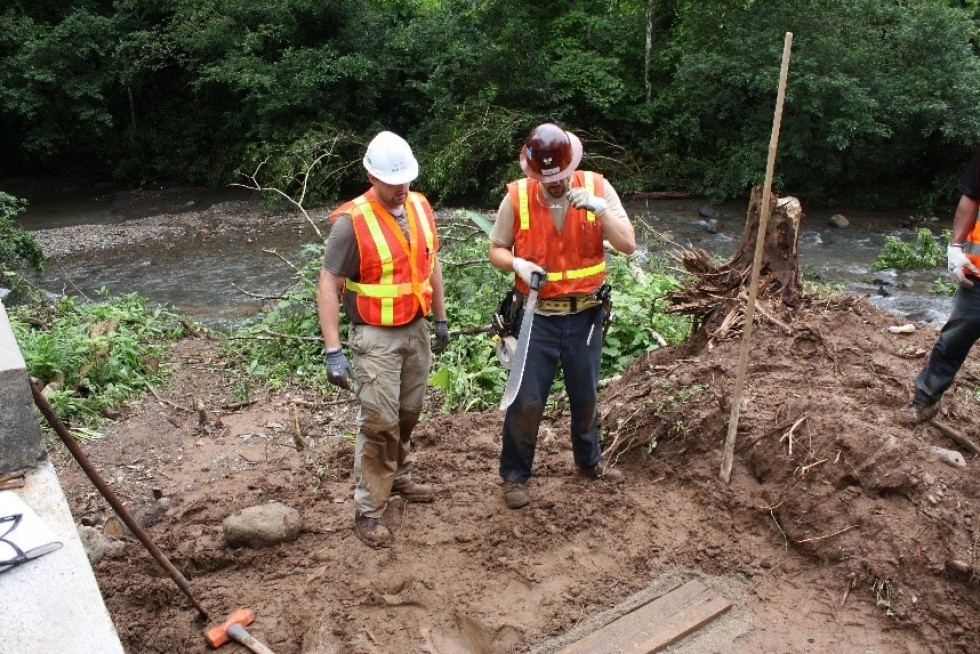
Mat Reynolds and Mike Krulc consider the many, many uses for a machete of this size
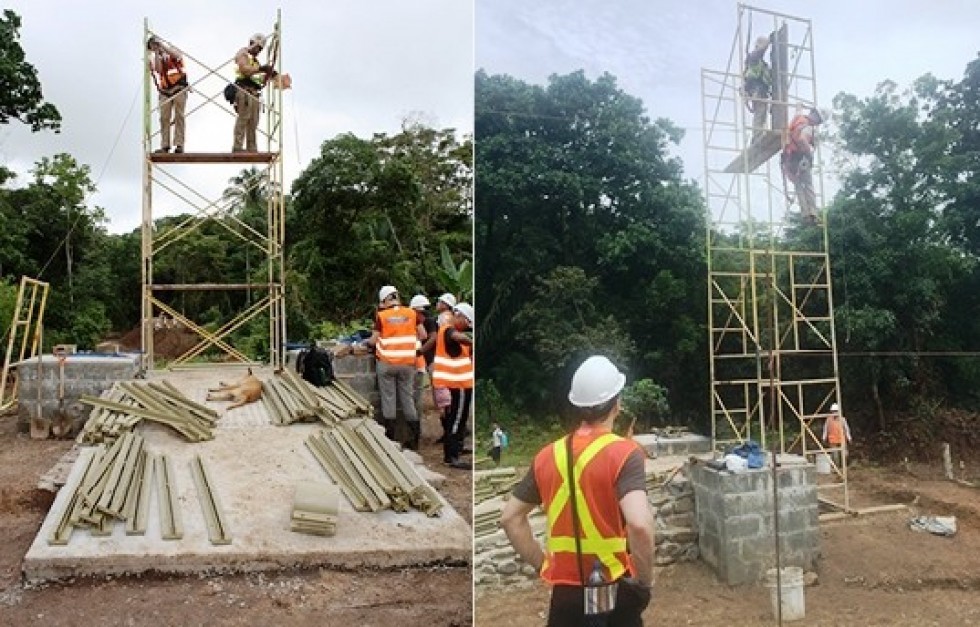
Progress on the Right Side scaffolding
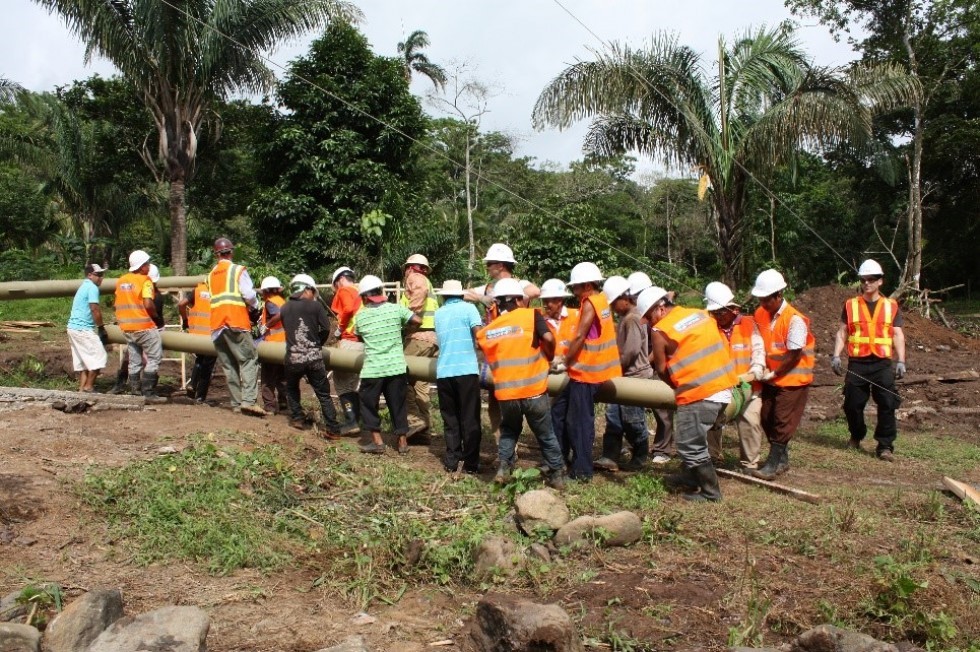
Setting the Right Side tower legs
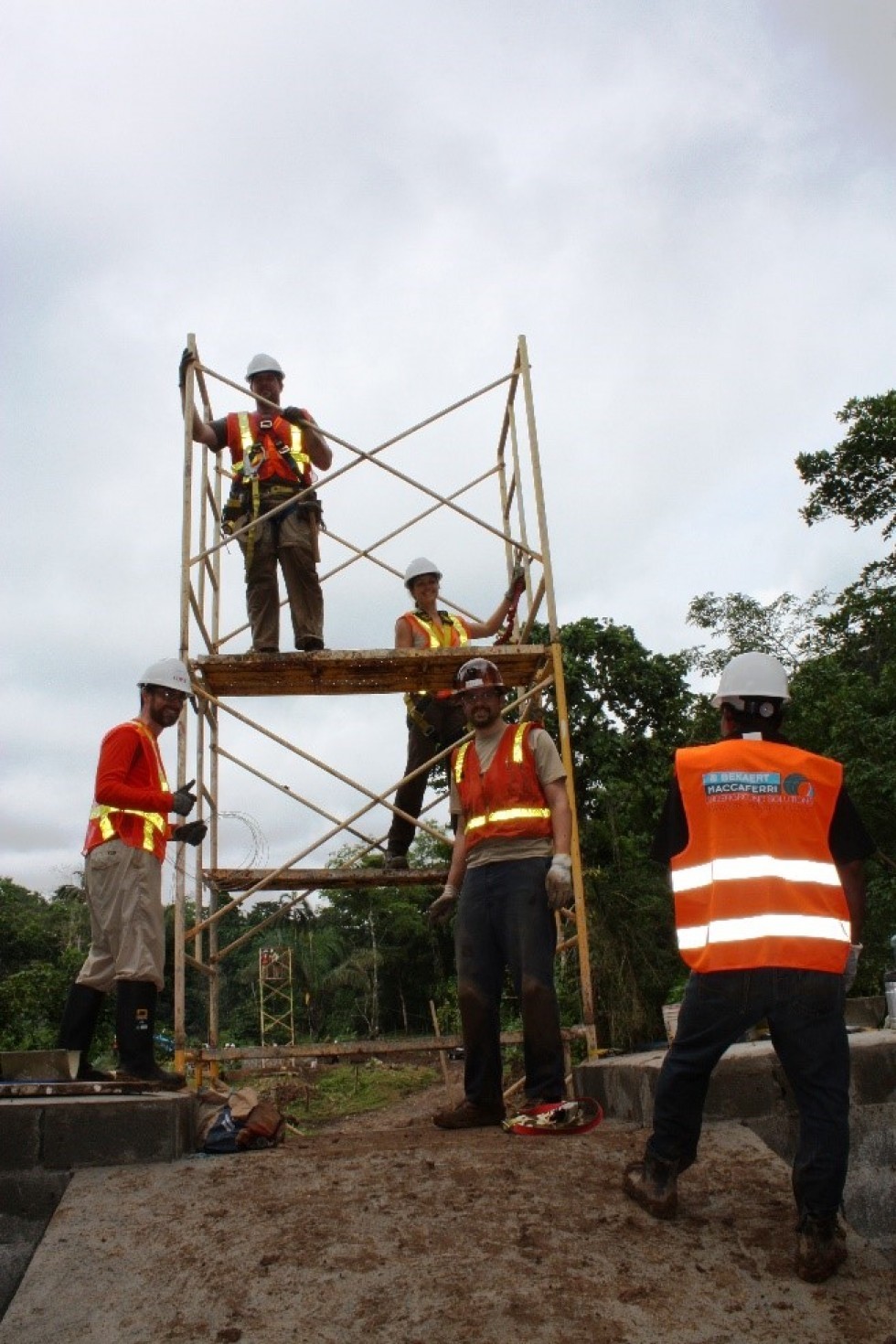
The Left Side team
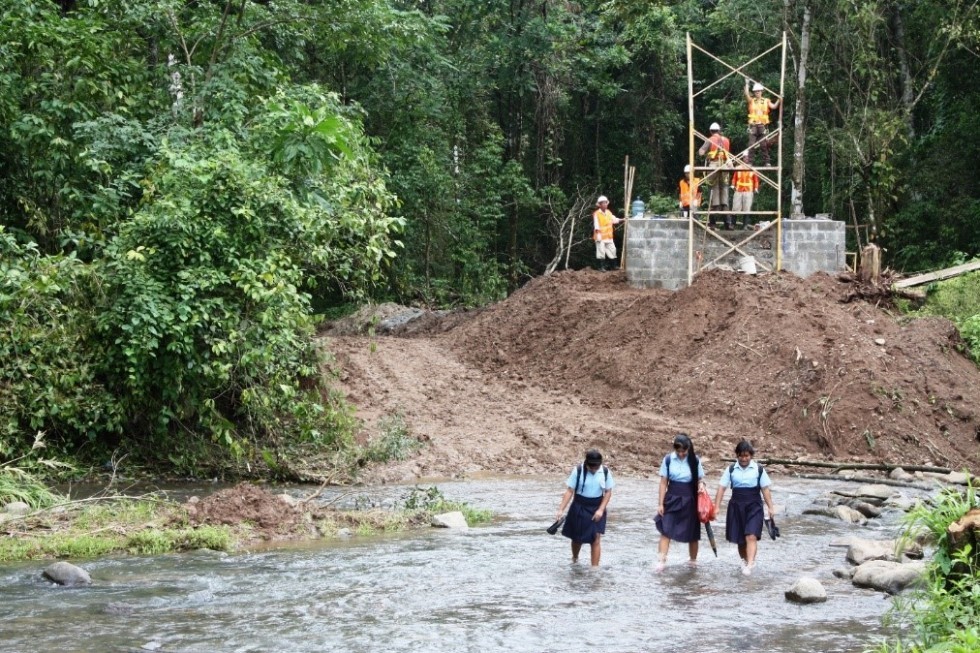
Left Side scaffolding assembly and schoolgirls making their way to Chiguiri Arriba

Just a few of our on-site mascots

The village of La Vieja
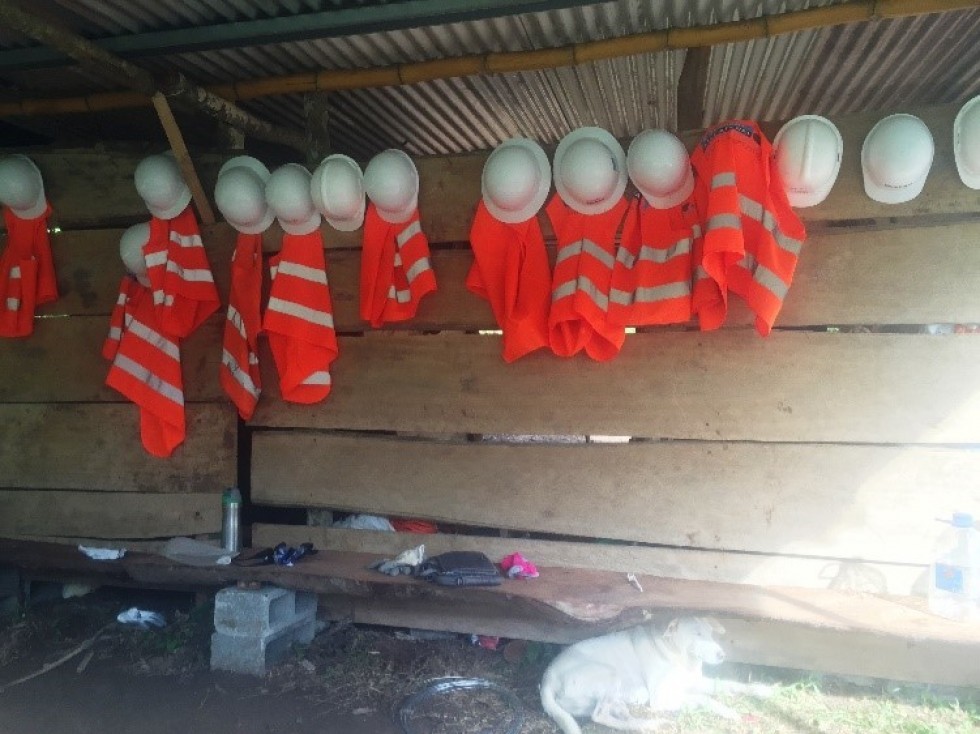
Quitting time
July 9-10, 2016 – Segue: from City to Rainforest
After a full day of air travel at varying levels of discomfort, our team members arrived in Panama City late on Saturday evening and reconvened early Sunday morning to set out for Chiguiri Arriba.
Then, so noted—what about the journey was notable? The equatorial heat and humidity, which all of us experience differently, and the inevitable debate as to whether heat or cold is preferable, which occurred immediately upon stepping outside the hotel to pack up the trucks. Passing by the Panama Canal as we exited the city. The multiple stops at hardware stores searching for rubber boots in a small enough size for two of our team members, with no luck. The glimpses of everyday Panamanian life through the vehicle window as the land through which we traveled became increasingly hilly, lush, and remote. Our first team shopping trip and our quaint and welcoming hostel accommodations. A ‘medium’ rainstorm followed by a delicious homemade dinner, beer and cards, discussion of scorpions and other creatures that may join you in your cot, crawling into bed beneath a mosquito net, and sleep, anticipating the first day of work.
The most notable event of the day, of course, was our brief visit to the site. Upon arrival, Tobias Petchke with COWI delivered a welcoming speech to the villagers, “We came here to build the bridge together with you, and you’re going to be part of the construction process. We’re going to show you how to stay safe and how to maintain the bridge in the future.” In turn, Jose Ruiz of Chiguiri Arriba offered the village’s full participation and assistance over the coming weeks.
The river was running low—about six inches—as it hadn’t rained yet that day, but it was immediately clear why the bridge is needed. Two concrete structures on either side of the river formed the pedestals, with anchor structures for the cable already poured. Scaffolding for each tower was laid out and ready for use. A temporary structure for staging, rest, and cooking was staffed and in use. Best of all was our brand-new latrine, which had just been poured over the weekend. What more could we ask for?
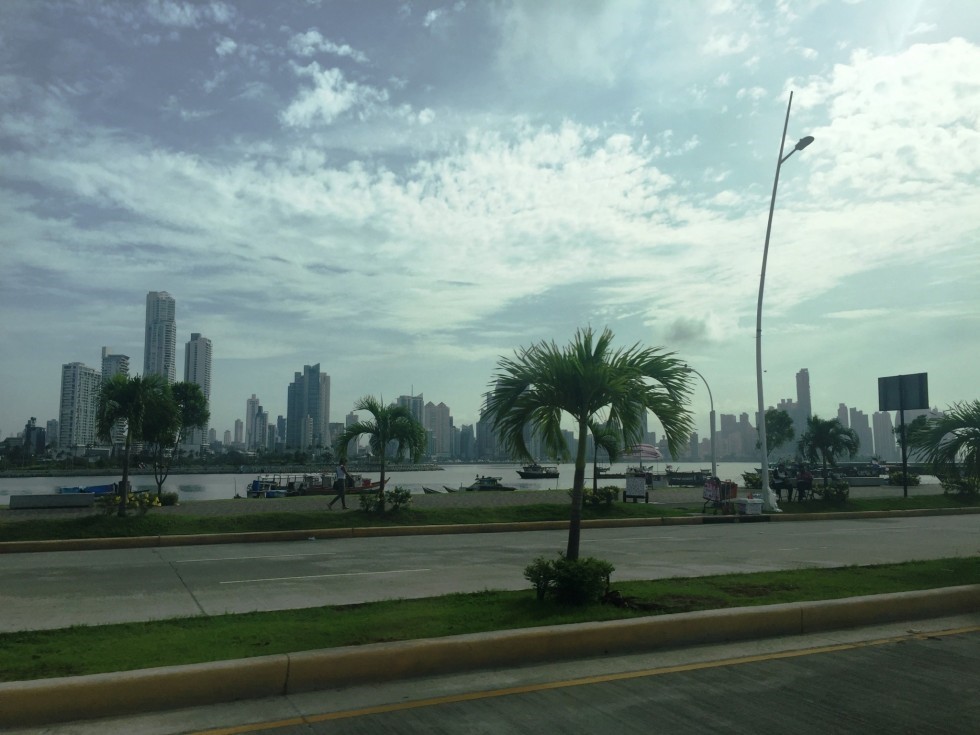
Passing by downtown Panama City on Corriador Sur
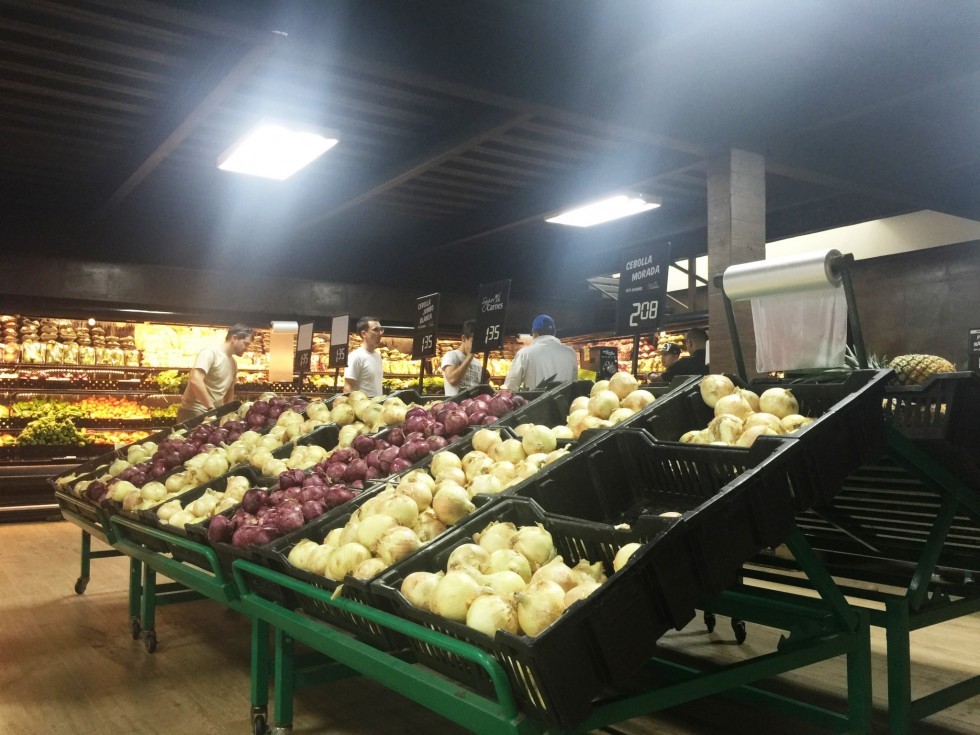
The produce section at Super Carne in the town of Penonome, where the team purchases our first round of food supplies: 10-lb bags of rice, beans, and lentils; onions, garlic, peppers, pineapples, mangoes; large packages of chicken and pork; dozens of eggs and gallons of water
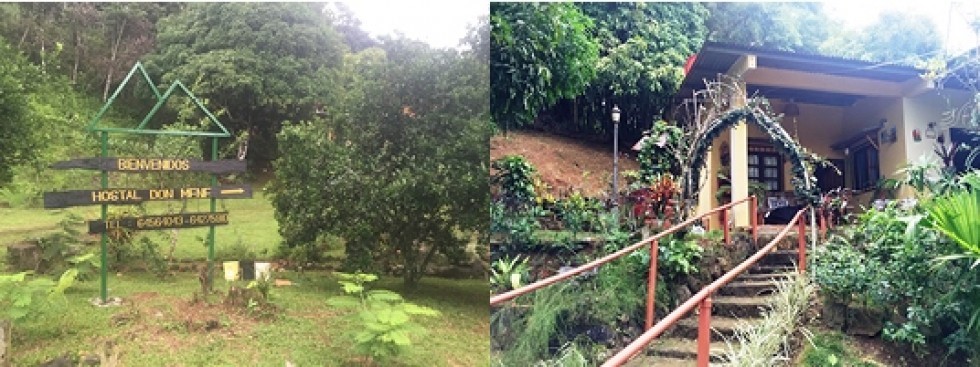
Our charming hostel
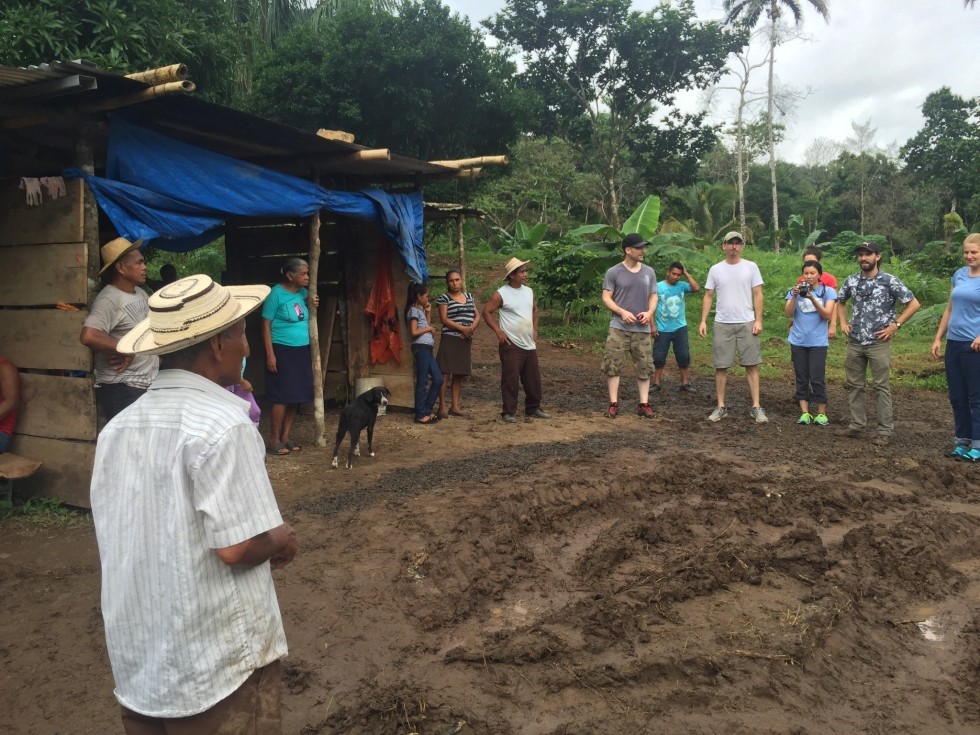
Tobias Petchke with COWI—our team’s fluent Spanish speaker—and Jose Ruiz of Chiguiri Arriba share welcoming words
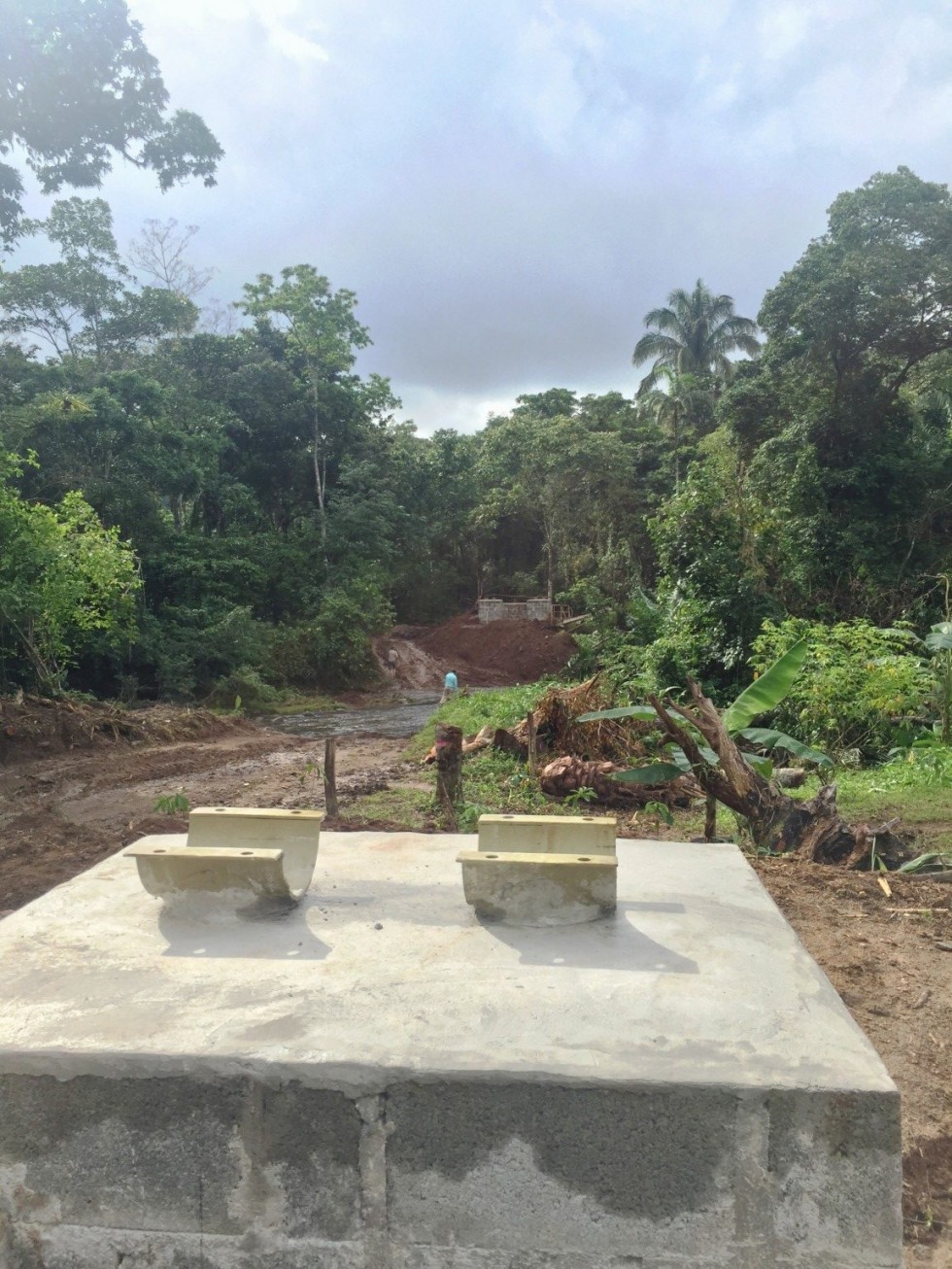
The pedestals with the tower bases
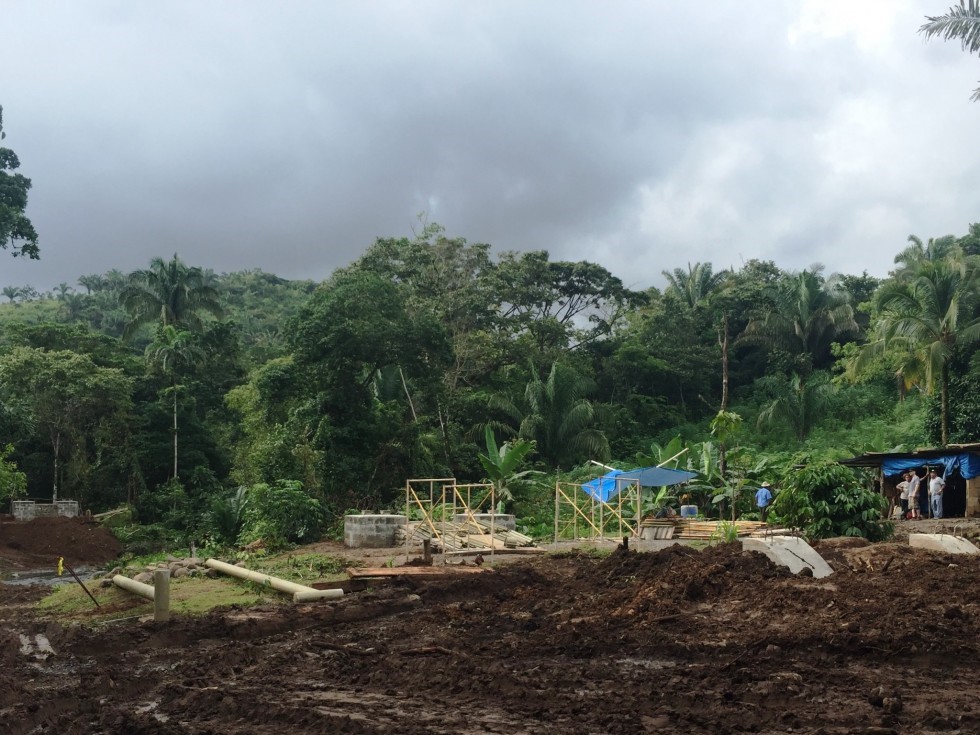
Overall site view…just a little muddy
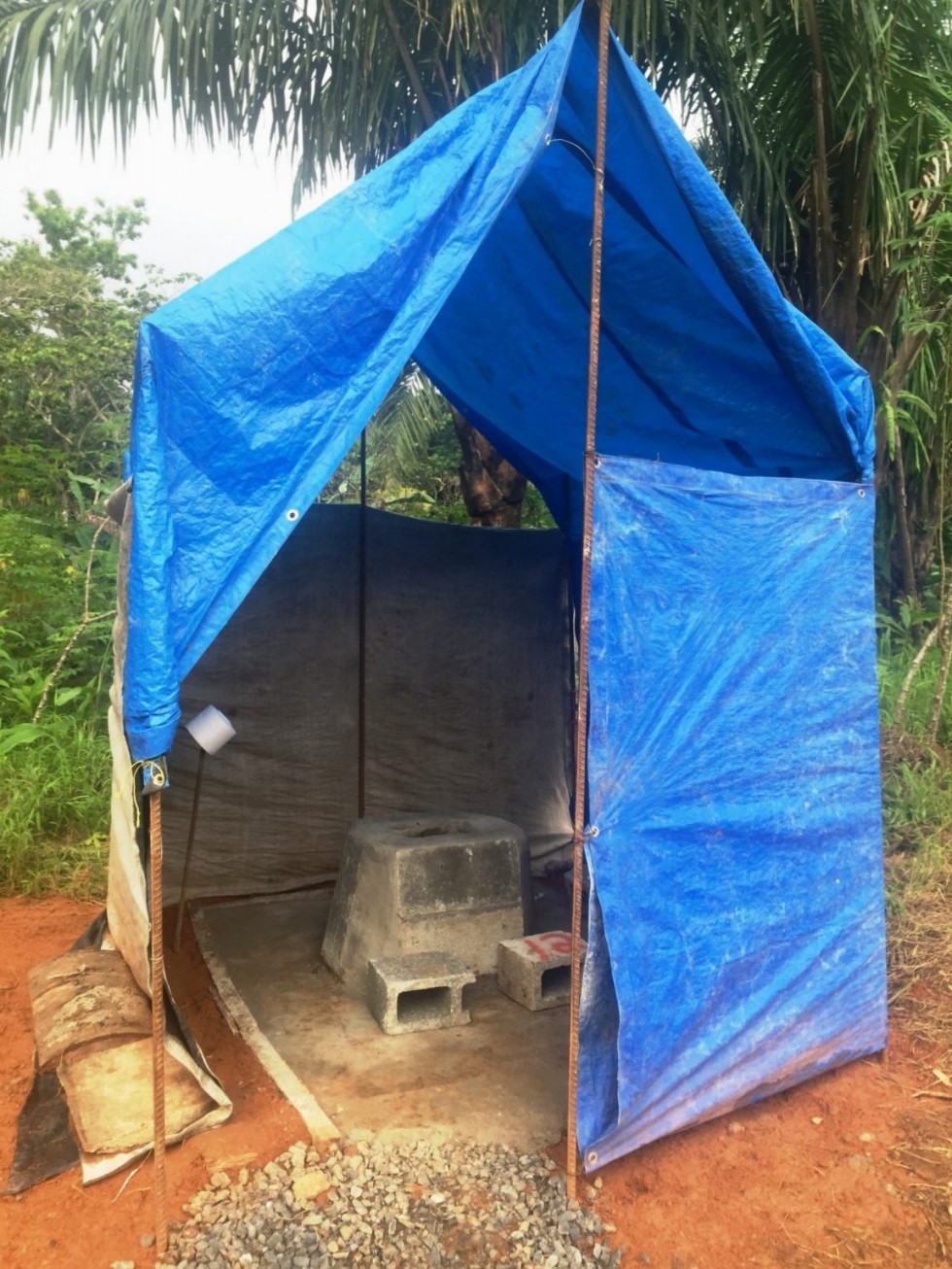
Our latrine is pretty cush…
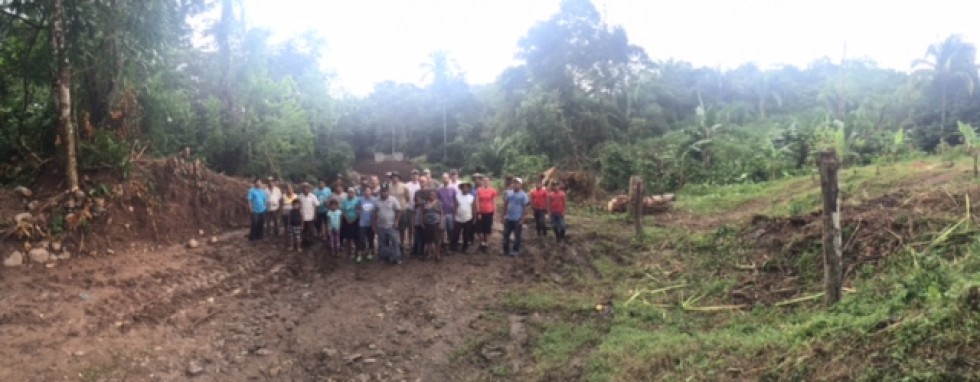
Shot of the whole team eager to get to work
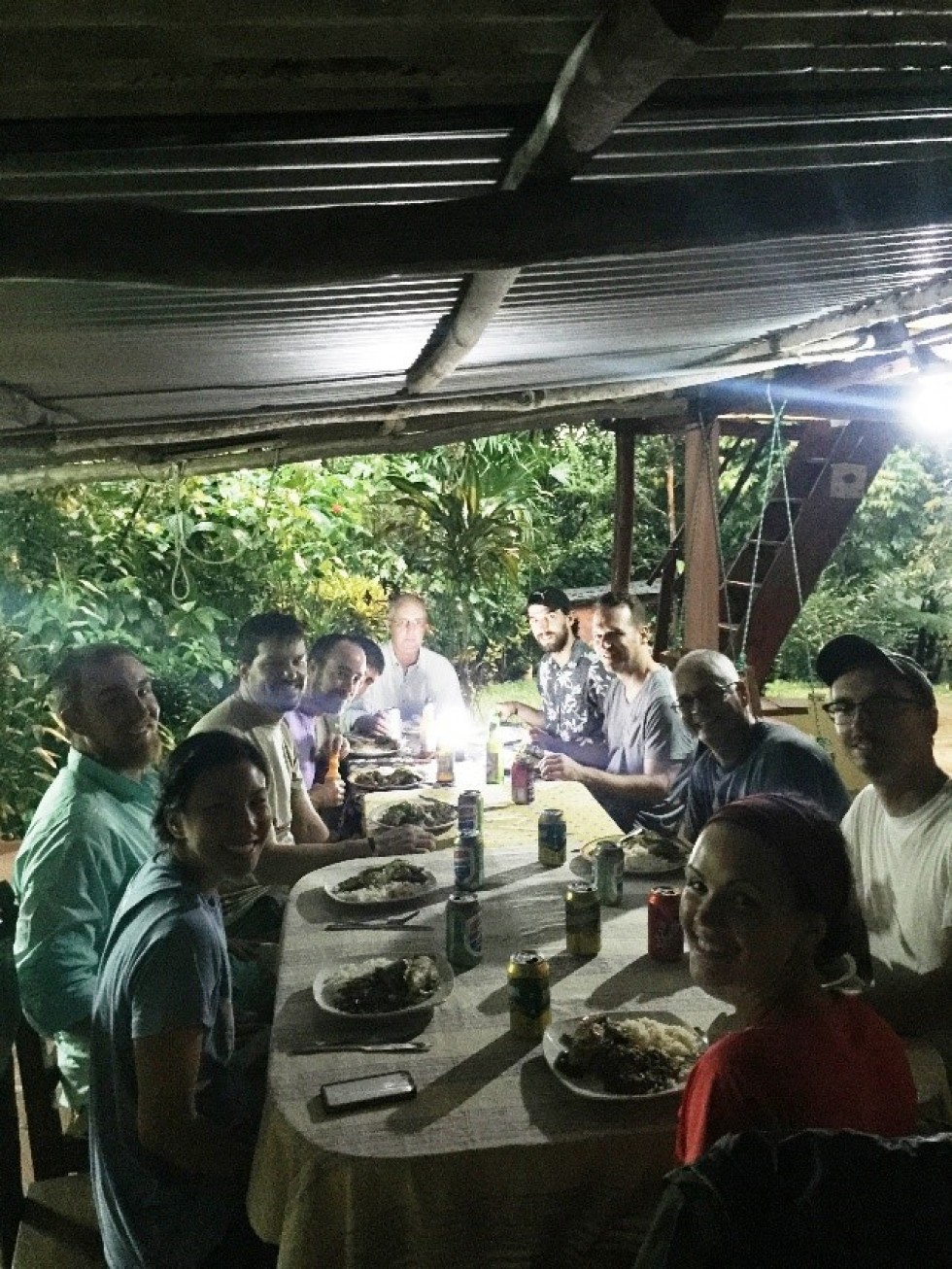
Enjoying an excellent home-cooked meal of chicken, lentils, and rice
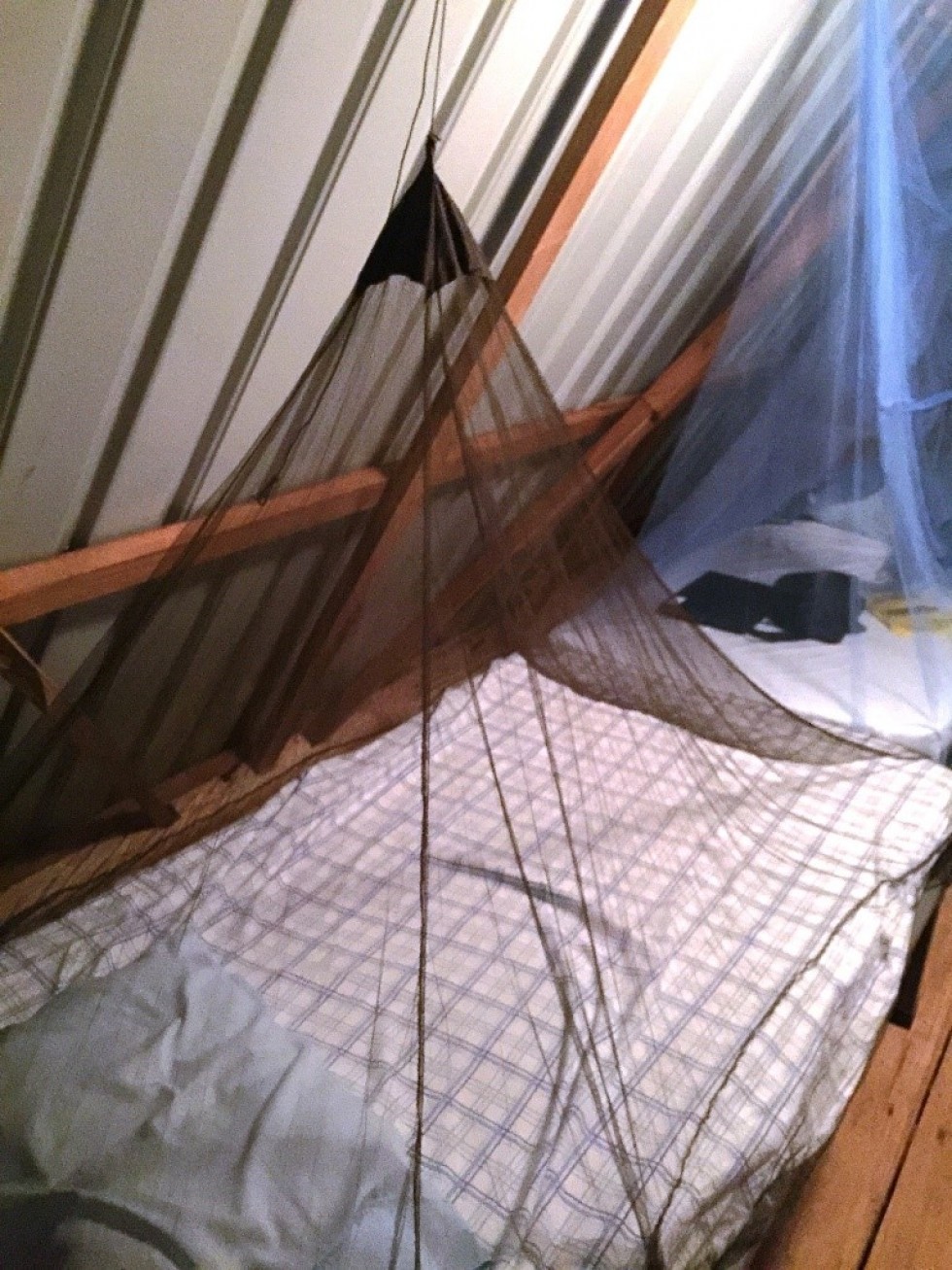
There were only a few creatures under the mosquito nets…spiders, scorpions…
July 7, 2016
Well, folks, the time has come. In less than 48 hours, the Traylor team will depart for Chiguiri Arriba, Panama, laden with tools and safety gear, energy bars, extra socks, and an ungodly amount of bug spray.
Alongside our partners, international design consultant COWI, we are spending approximately two weeks building a 66-meter suspension bridge across Rio Chiguiri in rural Panama. For nearly half the year the river swells, making passage difficult and dangerous. A previously existing bridge has since washed away. Approximately 200 families will directly benefit from the new footbridge, which will open access to schools, healthcare facilities, markets, farms, and other employment.
This blog has been set up specifically to share our experience with all of you. We will continually document our progress through photos, videos, and interviews, and our goal is to upload new blog entries whenever we can access wifi. Want to know where we are in the construction process? Are we on schedule? Did it rain for three days straight? Who dropped a hammer on their toe? Check back frequently to experience all the excitement and drama as it unfolds!
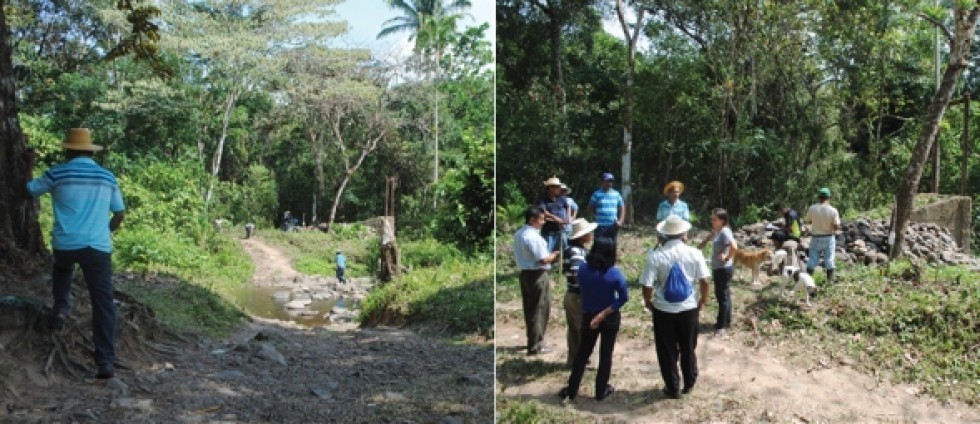
These are the ‘before’ photos
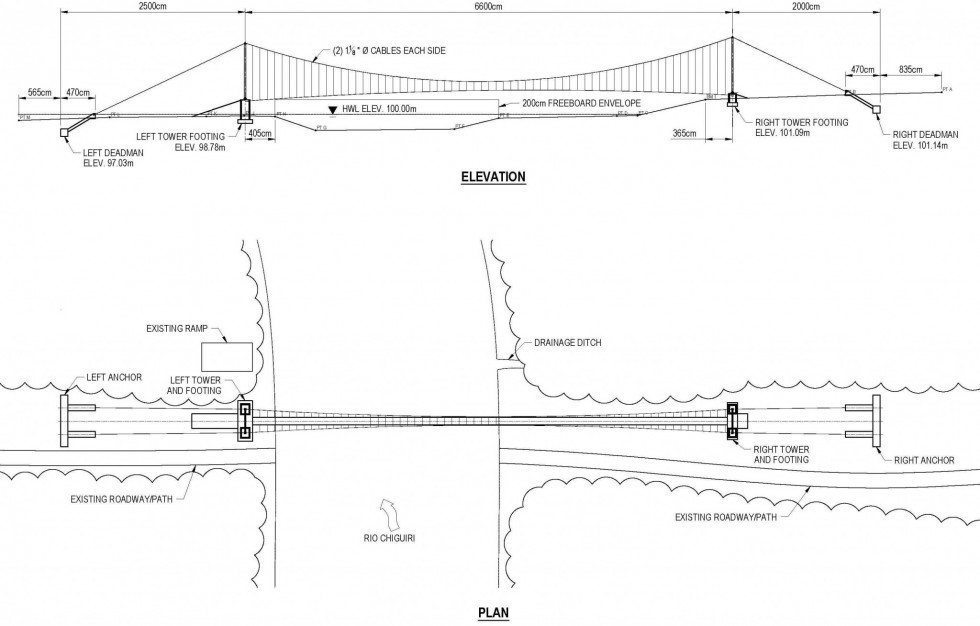
Here’s hoping our bridge looks kind of like this
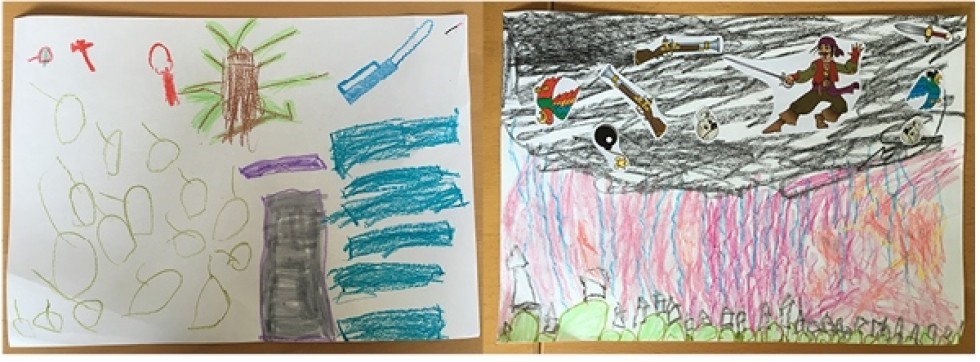
Traylor team member Mike Krulc’s 4-year-old son, Stanley, clearly a budding engineer, has been hard at work for us as well. To the left, his tools and materials list, which includes a hammer, nails, a tree to hold up the future bridge, and walk boards for decking. On the right is his weather control drawing, complete with tents and pirates to ward off the rain
